 |
Central Asia: Across the Caspian Sea and along the Silk Road
with a side excursion to where the Aral Sea used to be
October 2014
|
We started this journey in 2013 when we travelled from Istanbul through the Caucasus to Baku. If you would like to see that journey just click the map at the bottom of this page.
This time our route went through Central Asia from the South Caucasus to the Caspian sea, then along one of the Silk Road routes through the 'Stans' and up to the former coastline of the Aral sea. Altogether about 3,000 miles (4,800 km) including 125 miles (200 km) across the sea. |
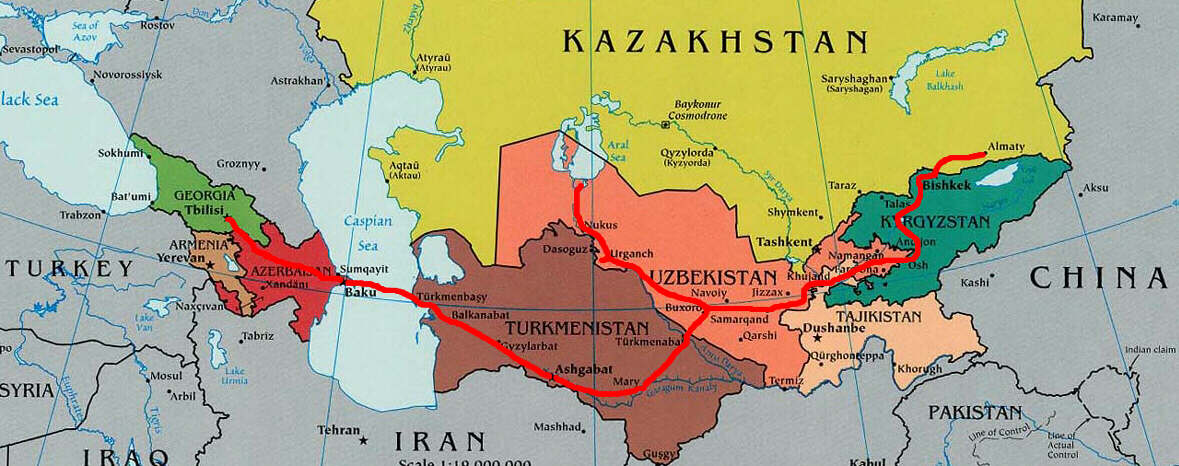
|
The Caucasus
Azerbaijan - Baku airport
|
Sat 27 Sept. We flew from London to Baku, a spectacular modern airport terminal created in preparation for the 2015 European games, with wooden ‘cocoons’ containing coffee shops and champagne bars, then flew on to Tbilisi. |
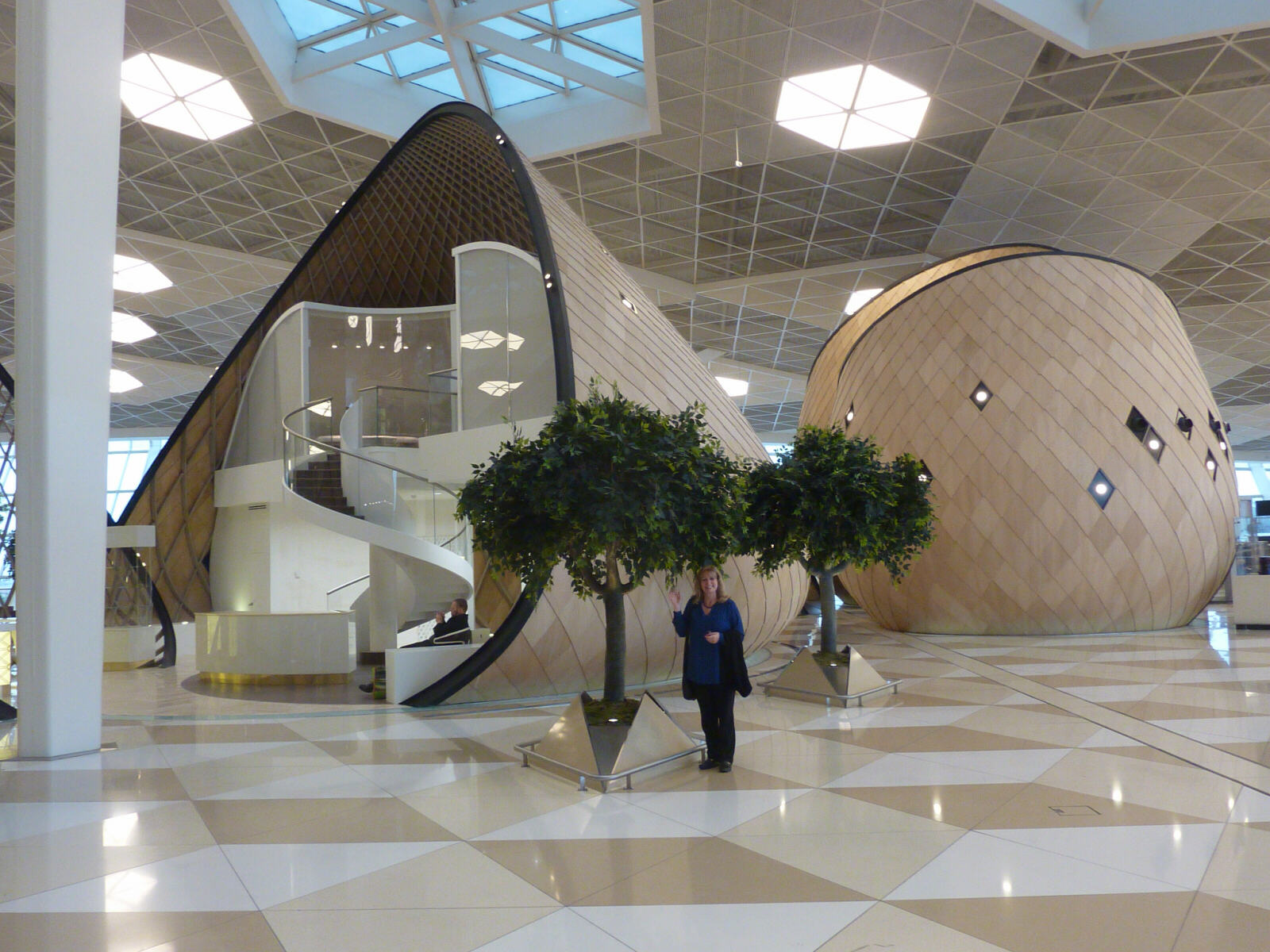
|
Georgia
- Tblisi
|
A taxi cost 30 Lari ($16/£10) to the Ponto Hotel, where we left our bags and went on our standard walk (we were here last year) down the hill, across the bridge and along Abkhazi Street, stopping for frozen yoghurt, to Freedom Square where we enquired at the tourist office about buses to Baku. Then back to Chardin Street (restaurant street) where it started to rain and we found shelter in a very nice restaurant called 12 Rue Chardin, drinking Russian champagne and eating cheese until the rain stopped. After a restful afternoon while the effects of the sparkling wine wore off we went back down to restaurant street and sat under an awning at the restaurant next door to no. 12, drinking Leffe brown beer and having a nice meal of strip steak and anchovy pizza while the rain continued to pour down.
Mon 29th. Woke up to bright sunshine, this looks more promising. We got a taxi out to Ortachala bus station where long-distance buses go to Moscow, Istanbul and all sorts of other places. We asked about buses and taxis to Baku in Azerbaijan but the buses all leave in the afternoon so arrive late at night, and a taxi all the way costs US$250 (£135) because the Azerbaijanis put all sorts of restrictions on the cars that can enter the country. Also, nobody spoke English there so we collected a couple of phone numbers and headed back to the hotel intending to ask them to phone for us and find out more. However, Sergo the taxi driver who took us, managed to convey (in Georgian) that he would take us to the border for $20 (£13) and there were frequent minibuses or shared taxis on from there. Back at the hotel they confirmed we had understood correctly, so we booked Sergo to pick us up on Wednesday morning. Pleased with this we went for a stroll and when it clouded over and started to rain we did the only thing we could do – retired to 12 Rue Chardin for more sparkling wine. In the evening we strolled around the old town past the ‘hammams’ (bath houses) and along the old main street to the wonky clock tower, then returned to the Leffe Pub for black beer and delicious steaks in Calvados sauce.
Tues 30th. At leisure in Tbilisi; another nice breakfast, a bit of a walk round, Sheila went to Metekhi Church on the hill to light candles for her family and friends and we had champagne and sausages for lunch. Then another walk round before yet more wonderful steaks and Leffe brown beer. As you may have gathered by now, it's all about the food and drink! |
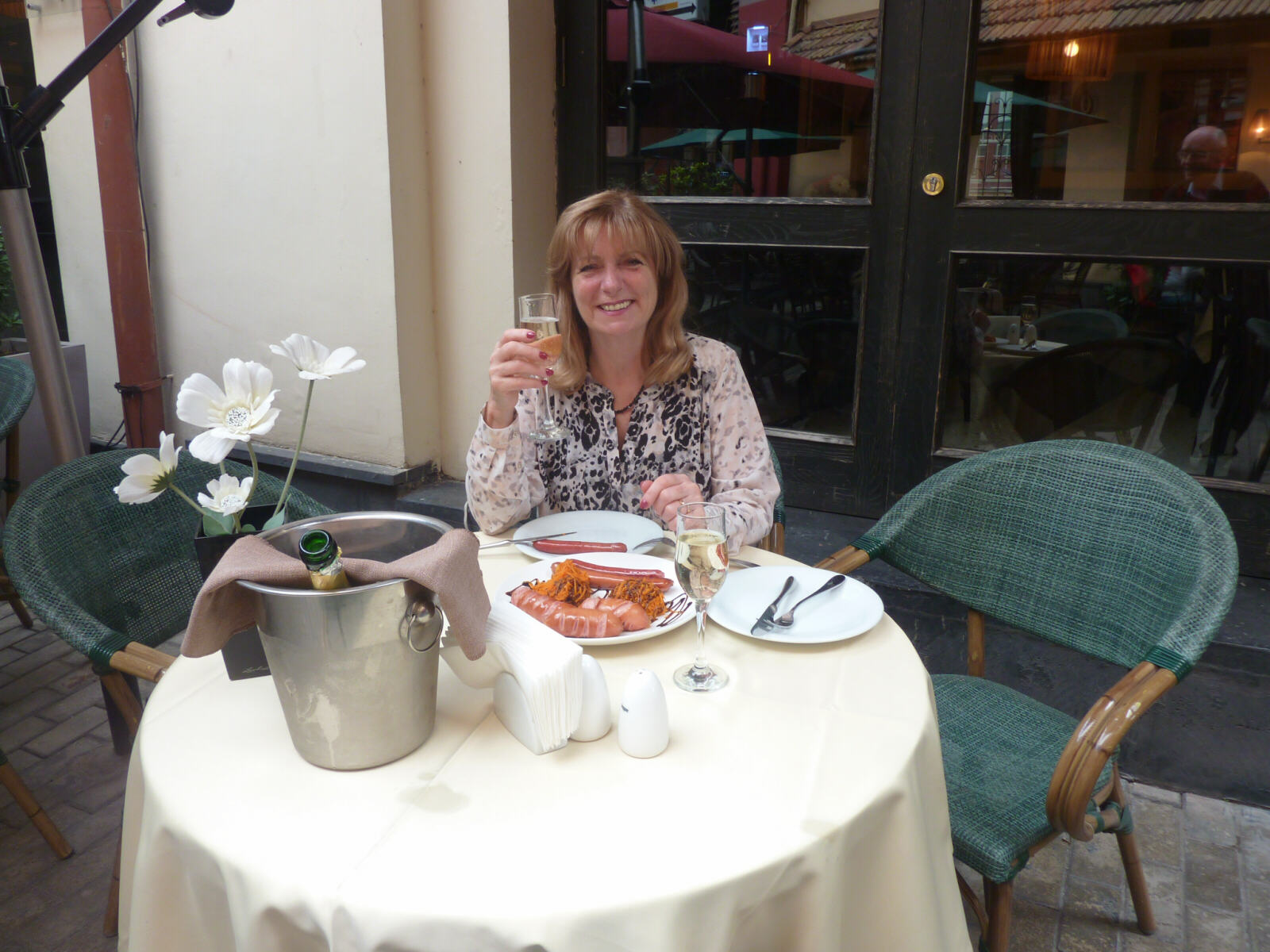
|
Weds 1st Oct. After breakfast Sergo the taxi driver was there and we set off for the hour’s drive to the border. Usually when we go for a long drive in a taxi, the first thing they do is pull in after five minutes and fill up with petrol. Sure enough Sergo pulled over after five minutes but nowhere near a garage and the next thing we knew he was injecting himself with something! We hoped he was diabetic because we couldn’t think of any acceptable alternatives. The hour-long drive was one long mobile phone conversation for Sergo using either one hand or none at all on the steering wheel, but we arrived and went painlessly through the border formalities and emerged at the other side where we changed our few remaining Laris into Manats, and got on a bus to Baku for 10 Manat ($11/£7) each. |
Azerbaijan
- Baku
|
There was a lot of stopping and waiting at bus stops and the 400-km journey took 8 hours. A taxi would have been quicker but we didn’t discover how much a taxi from the border would cost. From the bus station we got a taxi to Fawlty Towers Hotel for 14 Manat which was probably too much but they had us captive (nearly 10 pounds, so total journey cost about $56/£37 instead of $250/£135 by taxi all the way). It was late and we didn’t fancy a big meal so we went to a bar by Fountain Square and had Erdinger dunkels (dark beers) and pretzel sticks for dinner (gourmet or what?!)
Thurs 2nd. After breakfast at Fawlty Towers we walked to the Tourist Information office where a very helpful man told us where to buy tickets for the ferry across the Caspian to Turkmenistan, wrote it down and came and hailed a taxi for us and explained to the driver how to get there. He stopped a purple ‘London’ taxi cab because he said they always use the meter but the other taxis make up the price as they go along and are therefore much more expensive for tourists. With some difficulty the taxi driver found the ferry ticket office, a small door in a nondescript building down a dirt track by a railway line to the port. The ticket lady spoke no English but luckily there was a travel agent lady visiting the office who spoke English and she explained that we couldn’t buy our tickets until tomorrow morning because our Turkmenistan visa was not valid until the day after, and the ferry will leave tomorrow evening – we shall see. Next we asked the taxi driver to take us to the Ateshgah fire temple about 30 km outside Baku, the only tourist ‘sight’ we didn’t do last year, and off we went straddling the white lines on the multi-lane road. Ateshgah is an ancient Zoroastrian site where natural gas lit an ‘everlasting flame’ until the Soviets over-exploited the gas reserves and the fire went out. |
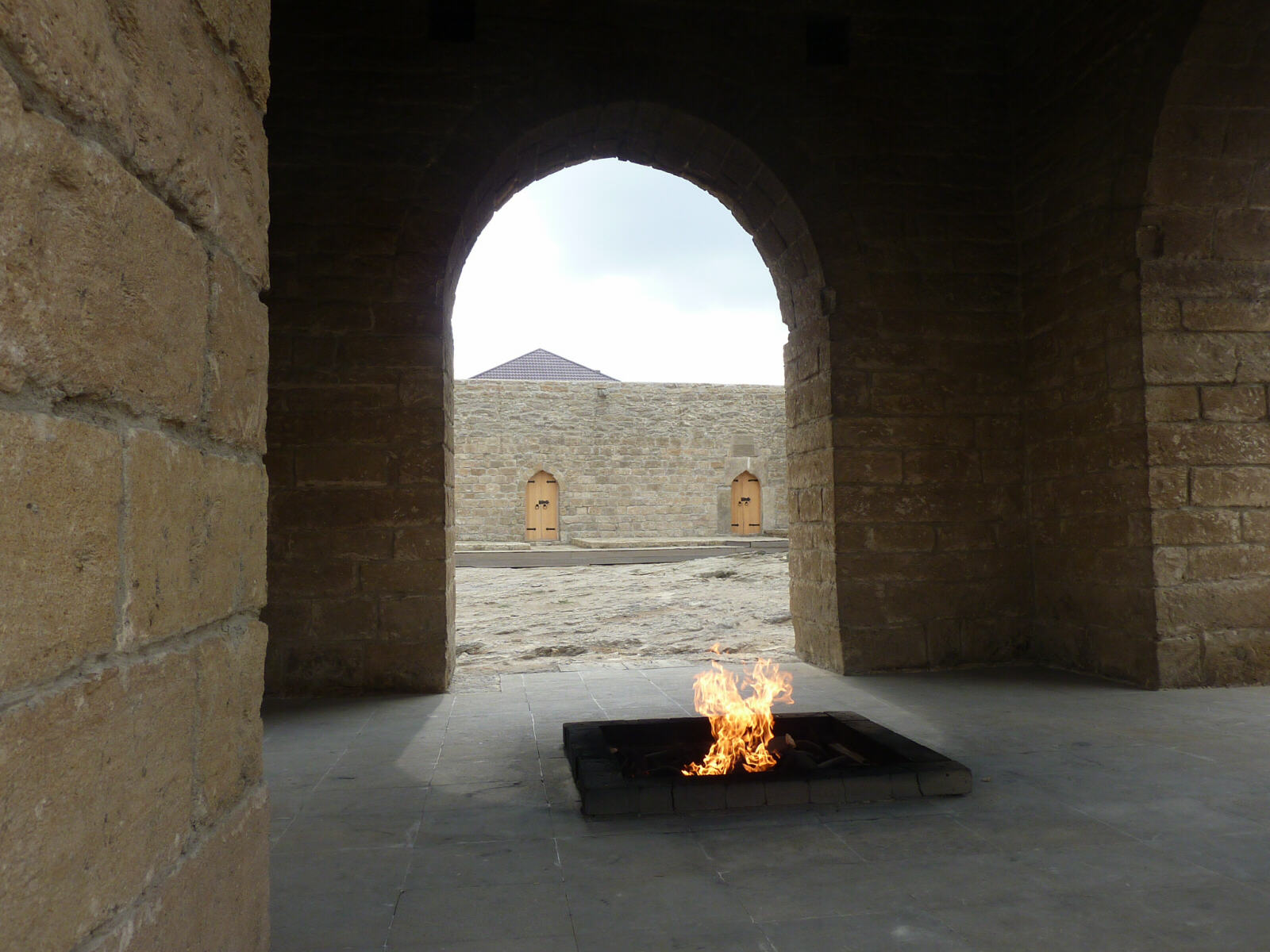
|
The temple is surrounded by pilgrims’ cells with rather touristified tableaux of pilgrims in various poses and is all recently renovated, and the flame is now lit by gas piped from Baku city, but it’s still very interesting. |
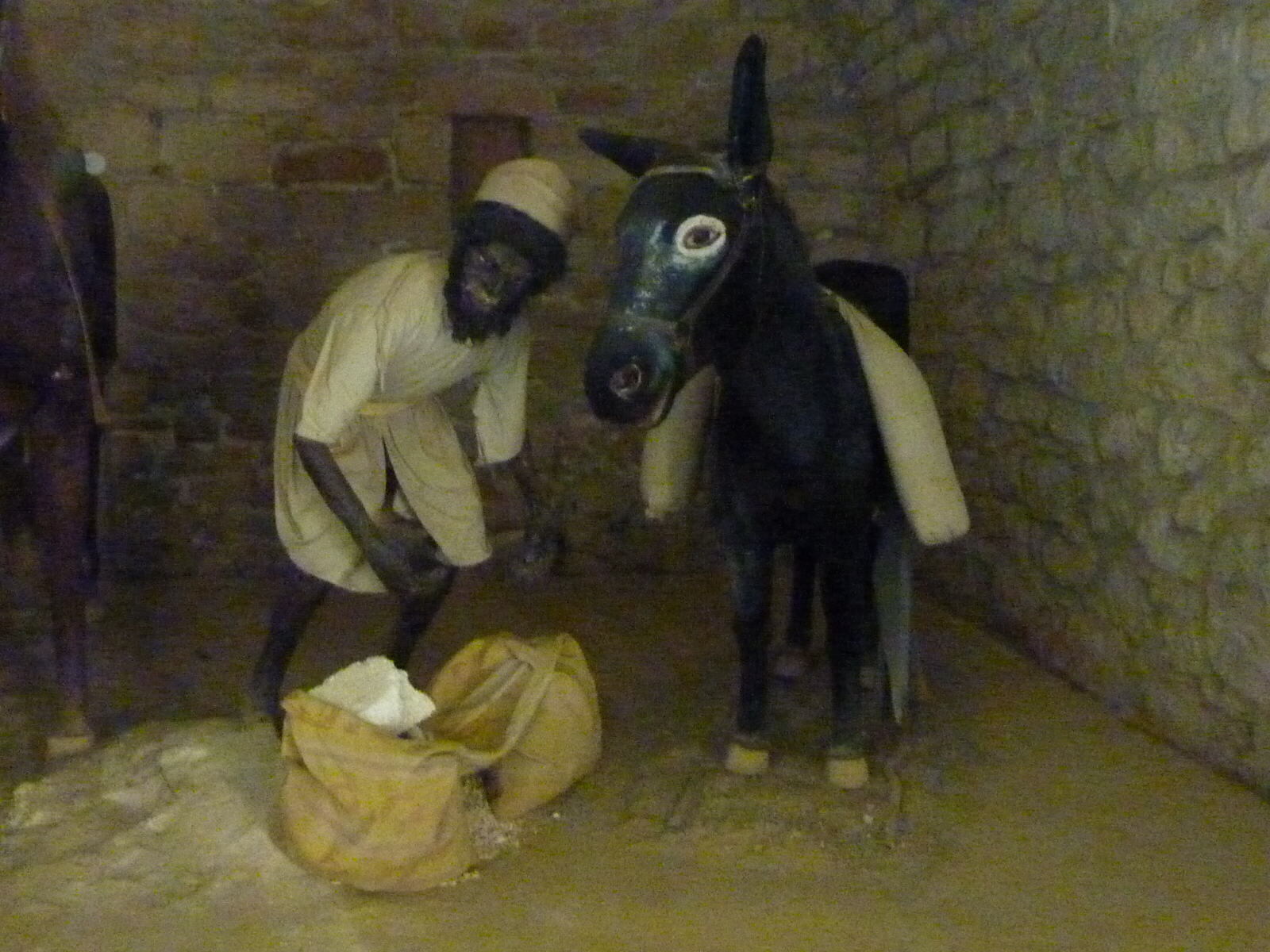
|
Back in Baku we went to Fountain Square for a late lunch at Pizza Inn, the only place for sitting out watching the world go by on the square. Despite the name they have a varied and extensive menu and we had a delicious lamb kebab and a smoked seafood salad, with ice-cold Efes (Turkish) beers. After a restful afternoon we went for a stroll round the shops in the elegant central area of Baku then back to Pizza Inn for delicious pepperoni pizza and Azerbaijan red wine (me) and another lamb kebab and Efes beer (Sheila).
Fri 3rd. The lady yesterday told us to come back to the tiny ferry ticket office between 10 and 11am – what she didn’t say was that the office appears to close at 11am so be on time! Luckily we were and bought our tickets at US$100 (£62) each (the price seems to be rising steeply comparing it with what the man at the tourist office said and blogs on the Internet). The ticket office lady who didn’t speak English made it clear we had to hurry, we had to be at the boat by 12:00 – this was a surprise because we hadn’t brought our luggage with us, so the taxi driver raced back to the hotel as quickly as possible through the awful traffic and we collected our already-packed cases and raced back to the port again, to the police post just a little bit further down the road from the ticket office (which was now firmly closed). There is nowhere to change money and we were stuck with some Azeri Manat which nobody in subsequent countries wanted to change. After having our details entered into several ledgers and weaving our way through stationary goods trains, we came to a dock with two rather old and rusty-looking ships alongside. One had the goods train sticking out of it, the other was ours. A friendly crewman who spoke no English showed us our ‘stateroom’, which had two beds, several wardrobes, a sink and a porthole. When we went in Sheila took a step back recoiling in horror but I gently pushed her inside and I didn’t think it was too bad. We used up a canful of ‘Raid’ on it to make sure no critters survived and turned the stained mattress over to the less stained side and were quite pleased when a friendly lady who spoke no English brought us some grey sheets, pillows and blankets. |
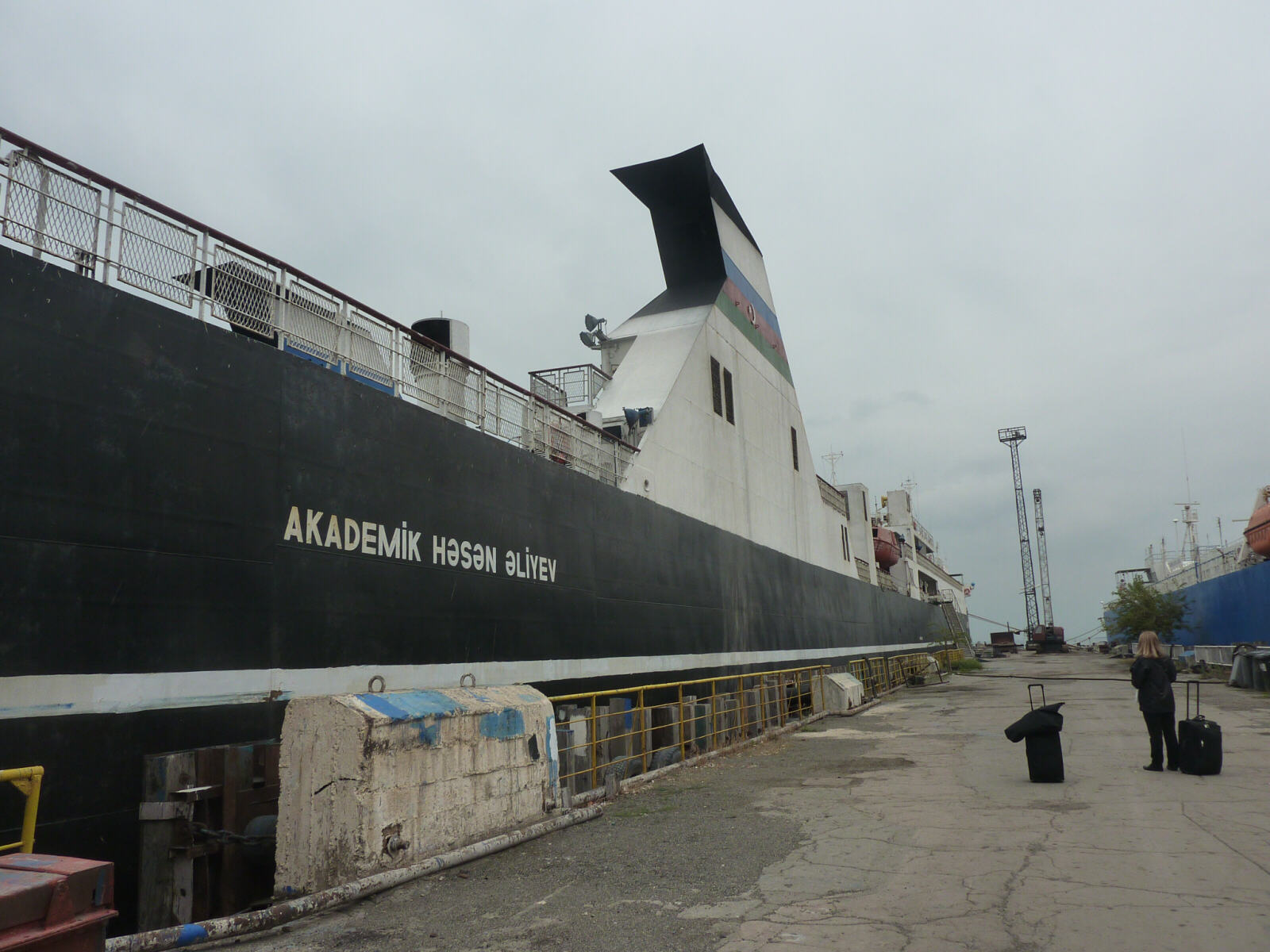
|
She managed to convey that the café would be opening soon which was good news because we’d heard that there was no food on board and because of the rush had not managed to buy anything more than a couple of Mars bars. We went along to the café and she served up tasty bowls of soup and plates of chicken with potatoes – there didn’t seem to be any choice but it was very good. Then we showed her our tin mugs and tea bags and she made tea for us and brought it over complete with a bowl of sugar and a spoon. There was no price list but the whole lot cost 7 Az Manat (about $7 / £4) which seemed reasonable. We retired to our ‘stateroom’ to read, by which time it was 2pm and other passengers were starting to turn up. As we suspected, there was no reason to have rushed here by 12:00, but never mind. Nothing much happened for several hours, but when I went for a walk round about 4 or 5pm the gangplank was up so no one else was getting on or off. A couple of hours later there were some distant rattling and rumbling noises which might have been the anchor being pulled up and about 7pm we moved smoothly and quietly away from the dock and into the Caspian Sea. The café was open again so at 7:30 we went for dinner of tasty chicken and rather plain macaroni with a squeezy bottle of tomato ketchup to flavour it, sliced cucumber and bottled water, and more hot water for our tea and coffee. This meal cost 6 Manat. Our stateroom was cozy and very warm and we went to sleep to the swoosh of the waves outside. |
Turkmenistan
- Turkmenbashi ....
|
Sat 4th. By 10am Turkmenistan was in sight and we pulled up outside Turkmenbashi port and dropped anchor. And waited.
For some time the café remained closed but then before 12 o’clock it opened and we got hot water for tea and coffee and carried on waiting.
About 6:30pm we went back to the café for dinner (the chicken was showing its age by now), then carried on waiting.
It got dark.
Then about 8pm we heard the sound we’d been hoping for, the metallic clank of the anchor being pulled up and we started moving slowly towards the port. A tug pulled us the last part of the way and we finally docked about 10pm. We were lucky though, we only waited 10 hours to get into the port, we later spoke to some people driving the Mongolia rally and they waited 24 hours. Then we waited some more.
After a while the immigration officers came on board and disappeared into the crew quarters. Eventually someone told us to go down the steep steps and we waited some more beside the railway wagons on the rail deck, which was connected to the railway lines stretching off into Turkmenistan. Eventually the immigration man came back and we all followed him down the railway lines to the immigration office where there was extensive form-filling, paying some sort of entry tax ($12 (£7.50) each) and very thorough bag searches. There was a holdup because if you get your letter of invitation through a travel agent they ‘own’ you and have to accompany you throughout your stay. Our chap hadn’t arrived so one of our fellow passengers, a grizzled but friendly Uzbek, let us use his phone to call him. Eventually our guide arrived but he had the wrong paperwork so a long discussion ensued while we waited some more. The customs people were especially interested in medicines and checked all ours very thoroughly; apparently some prescription meds like Tramadol are strictly not allowed. They asked if we had any weapons and Sheila burst out laughing which lightened the atmosphere and they were friendly after that. They were eyeing some packets of sweets in the case and wouldn’t let go of them until we’d opened them and passed them around - Sheila only allowed them one each because they had to last another four weeks. At last, about midnight, we were stamped, paid and checked through and entered Turkmenistan. The train we were supposed to catch had long gone so our guide took us to the big, modern Turkmenbashi Hotel overlooking the sea where we got a big room for $42 (£26). We had a couple of beers in the soulless subterranean bar then retired about 1pm at the end of a long day. |
.... and Ashgabat
|
Sun 5th. After a nice buffet breakfast at the hotel our guide took us to the taxi station near the railway station. The long-distance taxis are normal cars and take up to four passengers. The journey to Ashgabat costs $140 (£87) per car and so we were offered two seats in a car which already had two passengers but we didn’t like the driver who said he would smoke all the way, so we went with a much nicer driver who had a very comfortable Lexus which we had all to ourselves. We left at 9:30, stopped for lunch at just about the only café we saw en route and arrived about 4pm. Almost the whole route was through hot, dusty desert with camels wandering about and road works a lot of the way as they upgrade the road to dual carriageway. The tour company had booked us into the former Sheraton Ak Altyn hotel which has recently been renovated, complete with a big bathtub (we’ve never had so many baths, usually in India it’s a bucket of hot water in the corner!). We had a stroll round the park opposite the hotel where they were setting up for a big celebration and everyone was promenading in their finest sparkling clothes. |
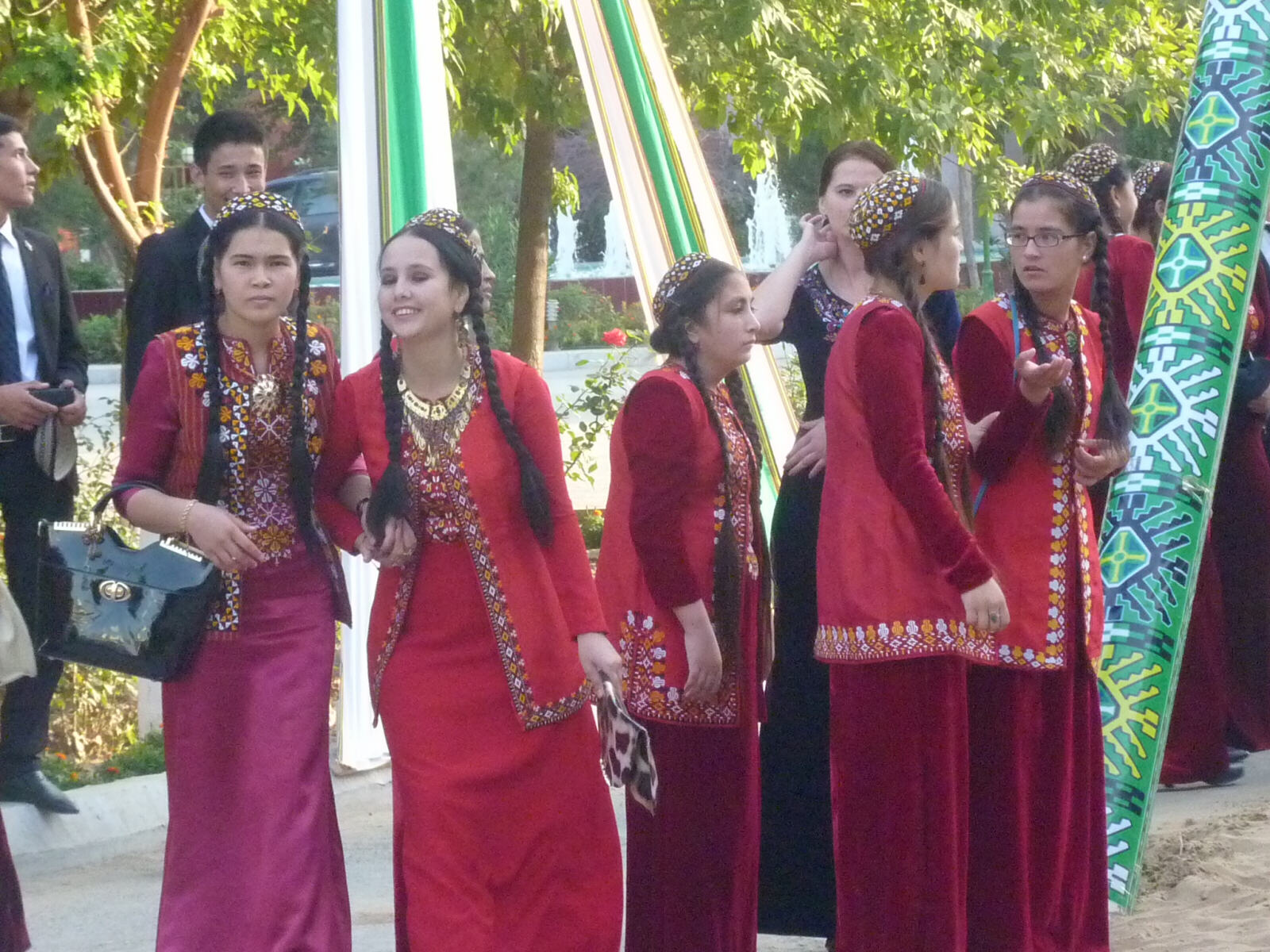
|
There were two huge swings in the park and Sheila re-lived her childhood by ‘pegging up on the flying plank’. |
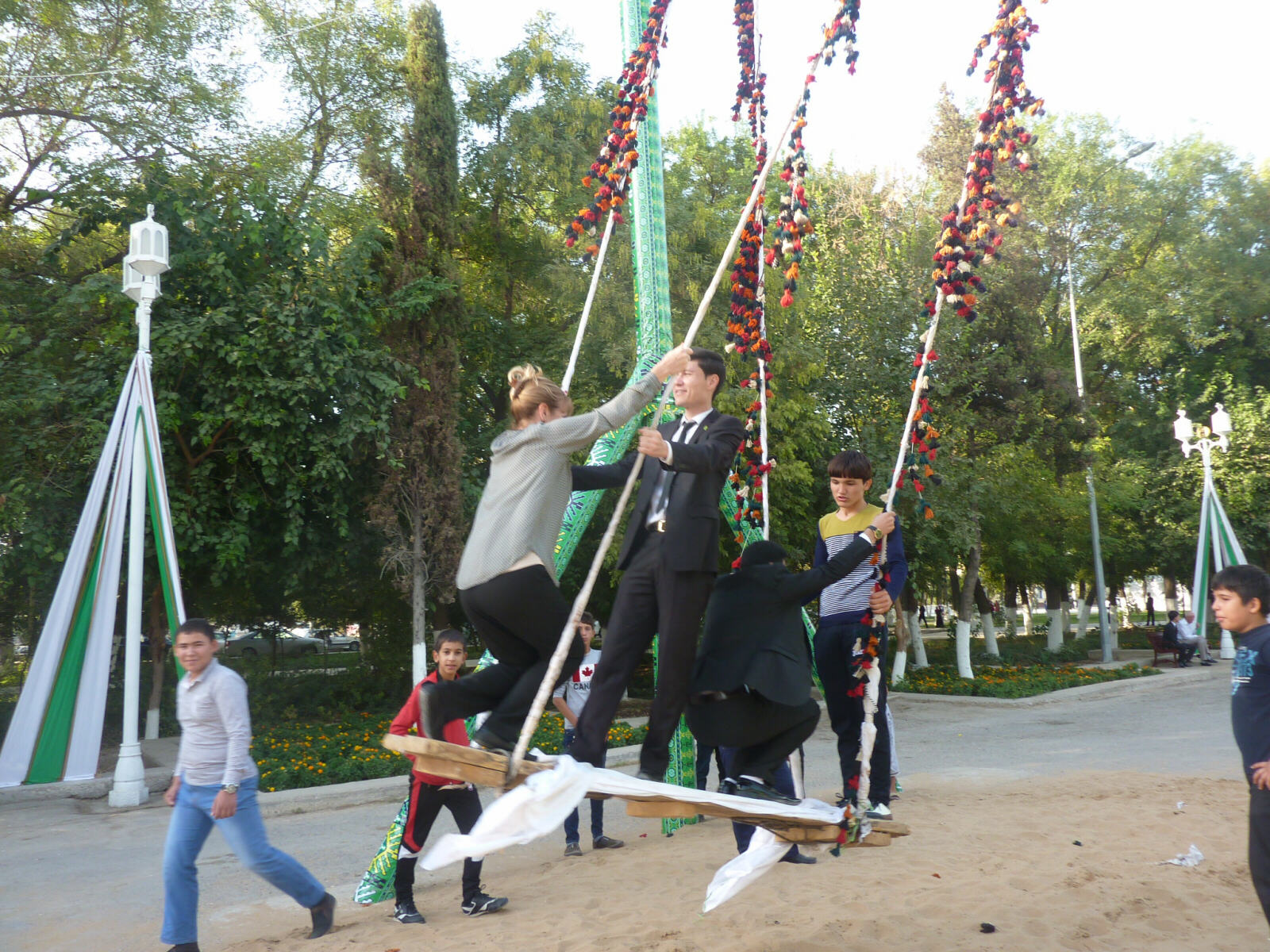
|
We looked in a couple of restaurants and bought a bottle of water from a little supermarket. Getting on for 8pm we thought the restaurants would be open and the event in the square would be in full swing so we set out again, only to find that the event in the square had finished and everybody had gone, and one of the restaurants wasn’t going to open tonight for some reason. We went back to the other one, an open-air beer garden and kebab restaurant called ‘Berk’ (previously the Iceberg Bar according to the guide book) and had a tasty if rather bony lamb kebab, salad, chips and some local beers. Several cats gathered and happily dealt with the bits of kebab that we couldn’t chew.
Mon 6th. After a nice buffet breakfast at the hotel, Batyr our guide and a driver picked us up for a sightseeing tour of Ashgabat. Today is a public holiday to remember the terrible 1948 earthquake which flattened the city and in the morning the president was out and about laying memorial wreaths, which meant that most of the roads in the city centre were closed off. So we started by going out of town to the huge new golden mosque, the largest in Central Asia, and the adjacent mausoleum of the first president. The mosque - which just happened to be adjacent to the president’s home village - was vast and light and airy inside and very peaceful. Then we drove round Ashgabat trying to find our way to the next sight but many of the roads were still closed off. Eventually we got to the Independence Monument with impressive statues of leaders of the Turkmen tribes, set in a large well-kept park with lots of pyramid-style fountains. |
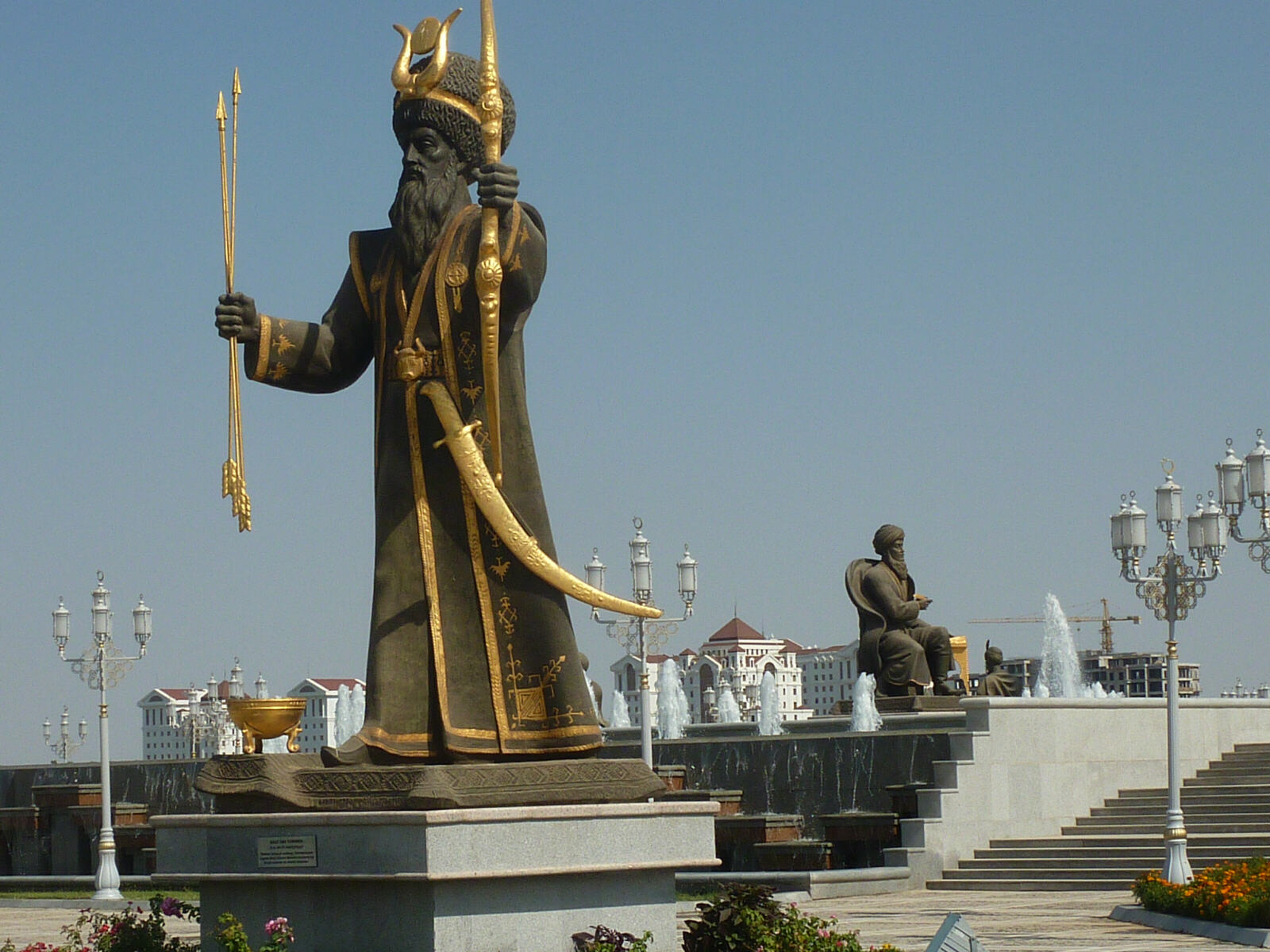
|
It was time for the changing of the guard and they marched to and fro, high-kicking like the Monty Python ministry of silly walks! |

|
From there we went to the enormous modernistic Arch of Neutrality, which used to be in the centre of town but too many tourists were coming near the government buildings so they moved it to another extensive park with more pyramid fountains on the edge of town. |
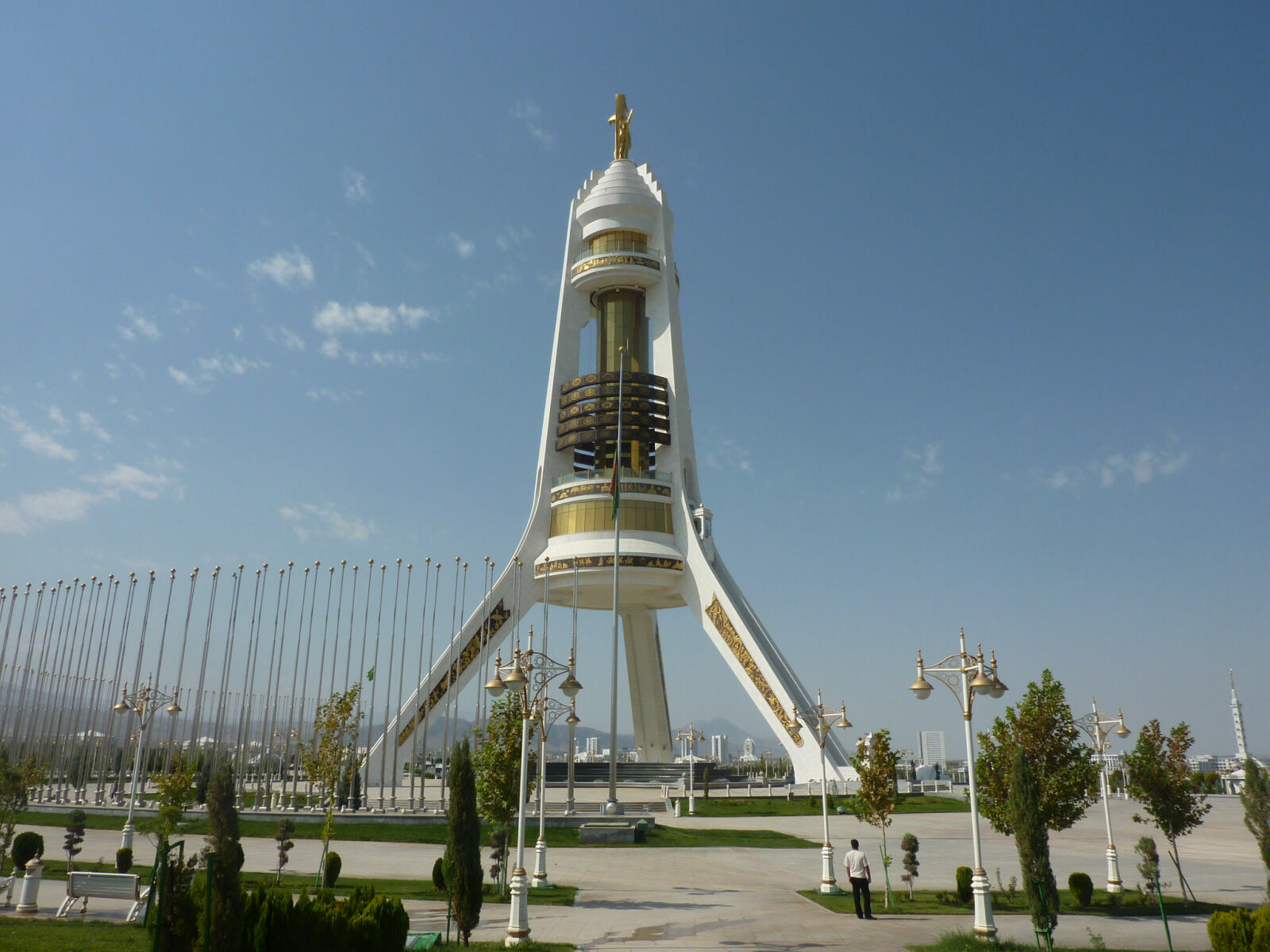
|
Ashgabat is full of wide avenues with gleaming white buildings containing apartments, offices or hotels, as well as some very eccentric buildings with no obvious purpose. It is all very impressive although rather eerily empty, with hardly any shops or pedestrians. |
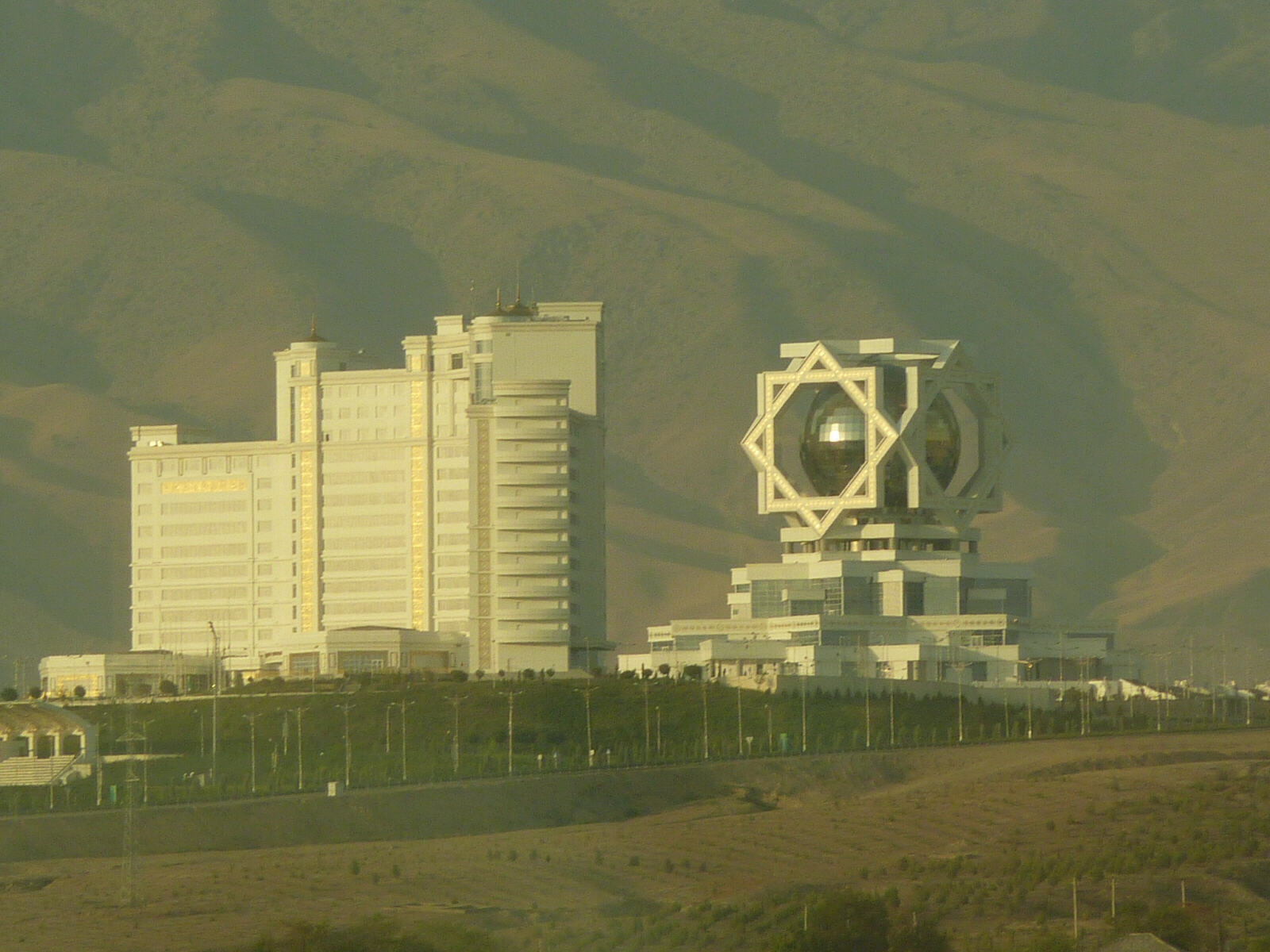
|
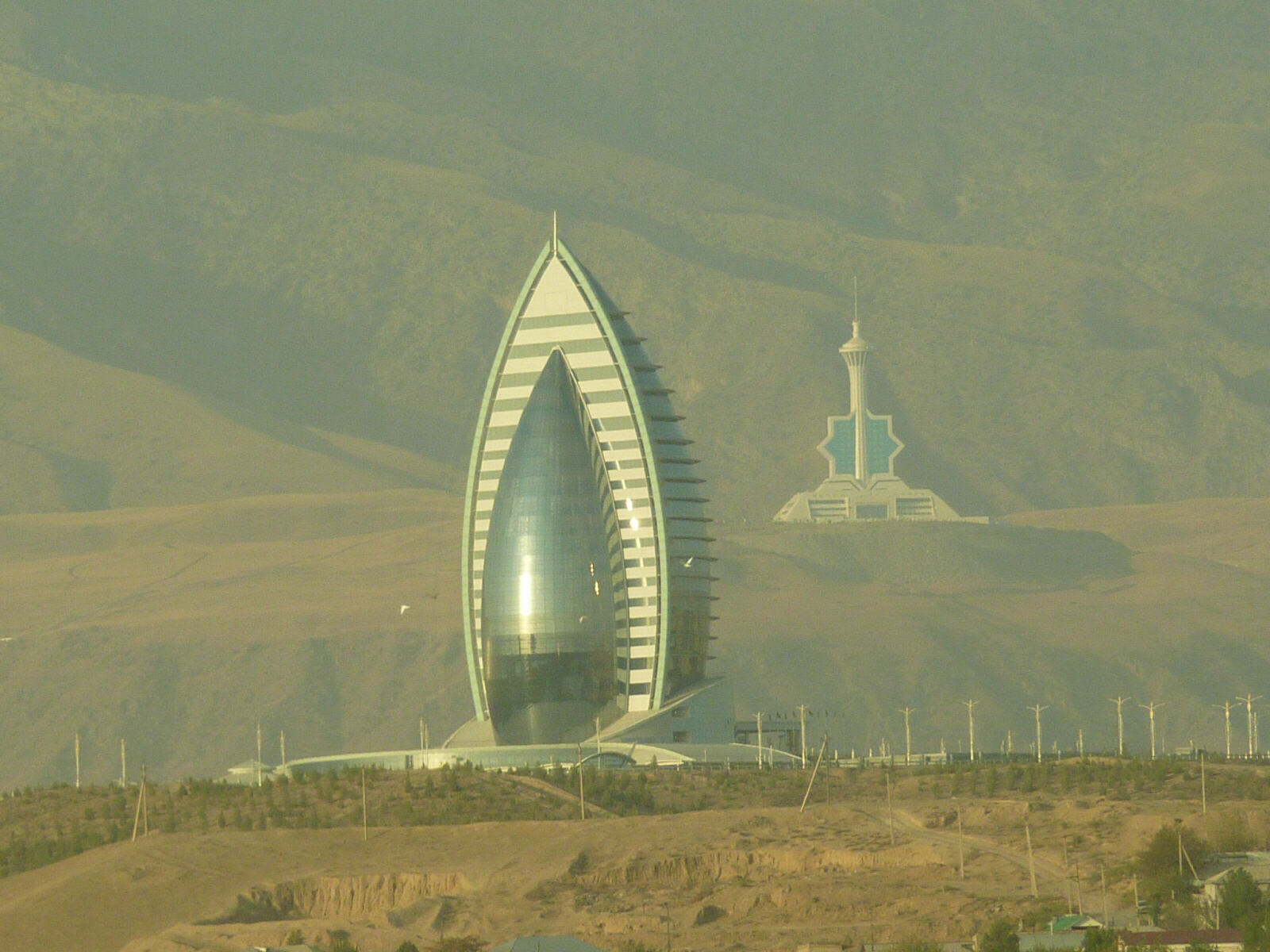
|
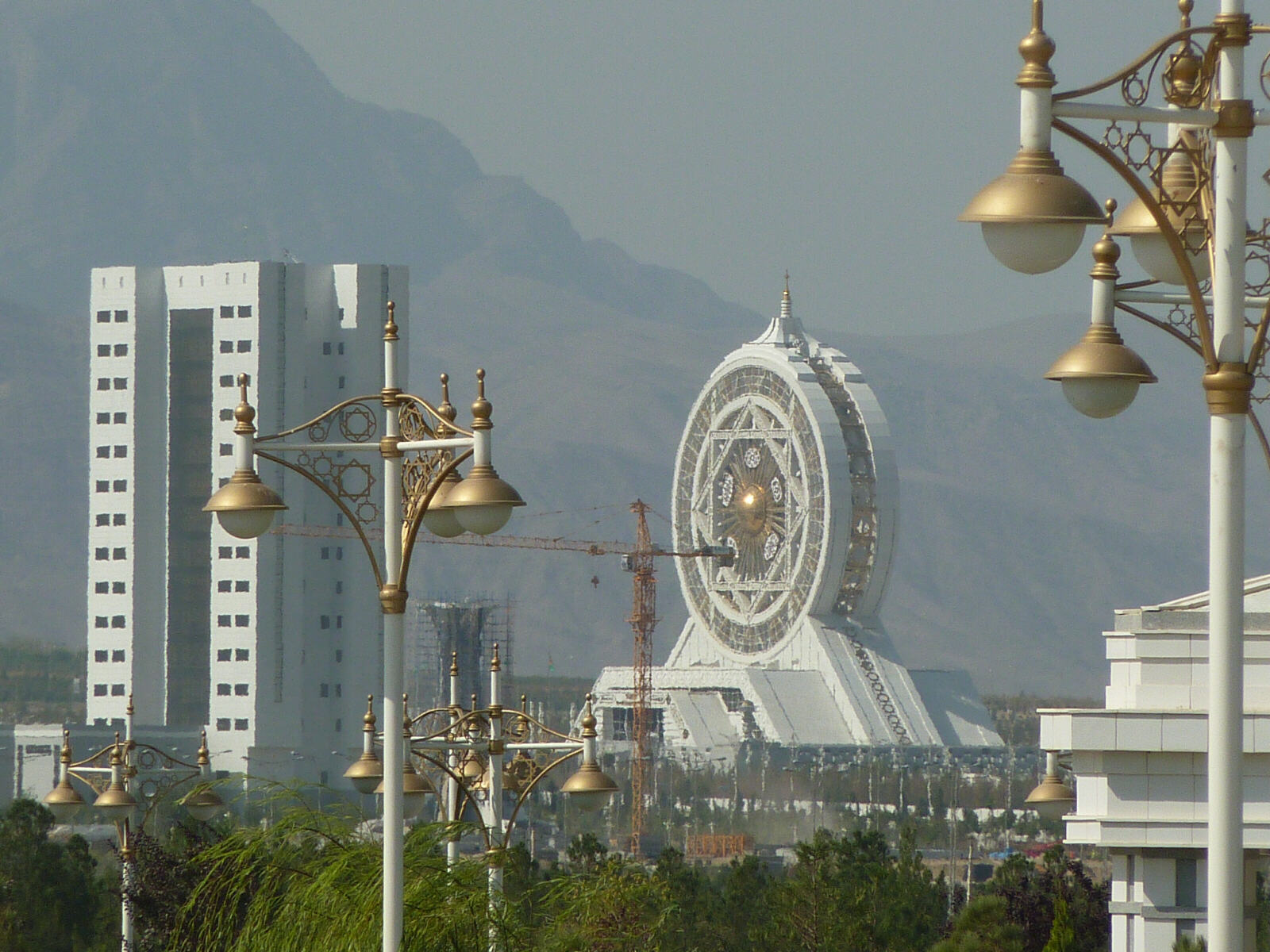
|
Apparently Ashgabat has been artificially expanded to take over surrounding villages so that its population is over one million, to justify hosting the next Asian games. The ‘willing’ villagers were plonked in high-rise apartments and their houses, gardens and farms were built over with more high-rises. We were just on our way to a restaurant for lunch when Batyr’s uncle phoned and invited us to lunch with them, so we drove to one of the big new apartment blocks (jointly designed by Batyr’s uncle who used to be an architect) and sat at a big table in the spacious high-ceilinged living room having a traditional Turkmen festive meal with the extended family. When we’d finished we drove to the last sight, another impressive big mosque built as a replica of the Blue Mosque in Istanbul as a gesture of friendship by Turkey. |
- Mary (Merv)
|
Then to the railway station where we got on the 4:40pm train to Mary (pronounced Maa-ree). The station was smart and clean but can’t be photographed because it is ‘of strategic importance’ (like bridges, policemen and many other things, apparently). The train was also clean and comfortable and left without preamble just about on time. It was a smooth and pleasant ride with only one intermediate stop and we arrived at Mary on time at 11pm. Unfortunately so did another train coming in the opposite direction, which blocked the walkway and left us stranded on platform 2 with no access to platform 1 and the exit, so we had to walk all the way down to the end of the train (and they are very long trains) and carry our bags across the tracks to get out. We went a couple of minutes down the road to the hotel Yrsgal.
Tues 7th. We were up early and off in a car with a dreadfully slow driver, who liked to come up behind lorries and just sit there while everyone else overtook us – I had to restrain Sheila who was dying to tell him to get a move on, and persuaded her to read a book instead! We went to the ancient city of Merv which was one of the most important cities in the Islamic world in early medieval times, but the Mongols literally flattened it and now there are just some substantial mud-brick walls, a ruined palace and a restored mosque. We walked round the walls of the Erk Kala, the oldest part of the city, believed to be nearly 3,000 years old. |
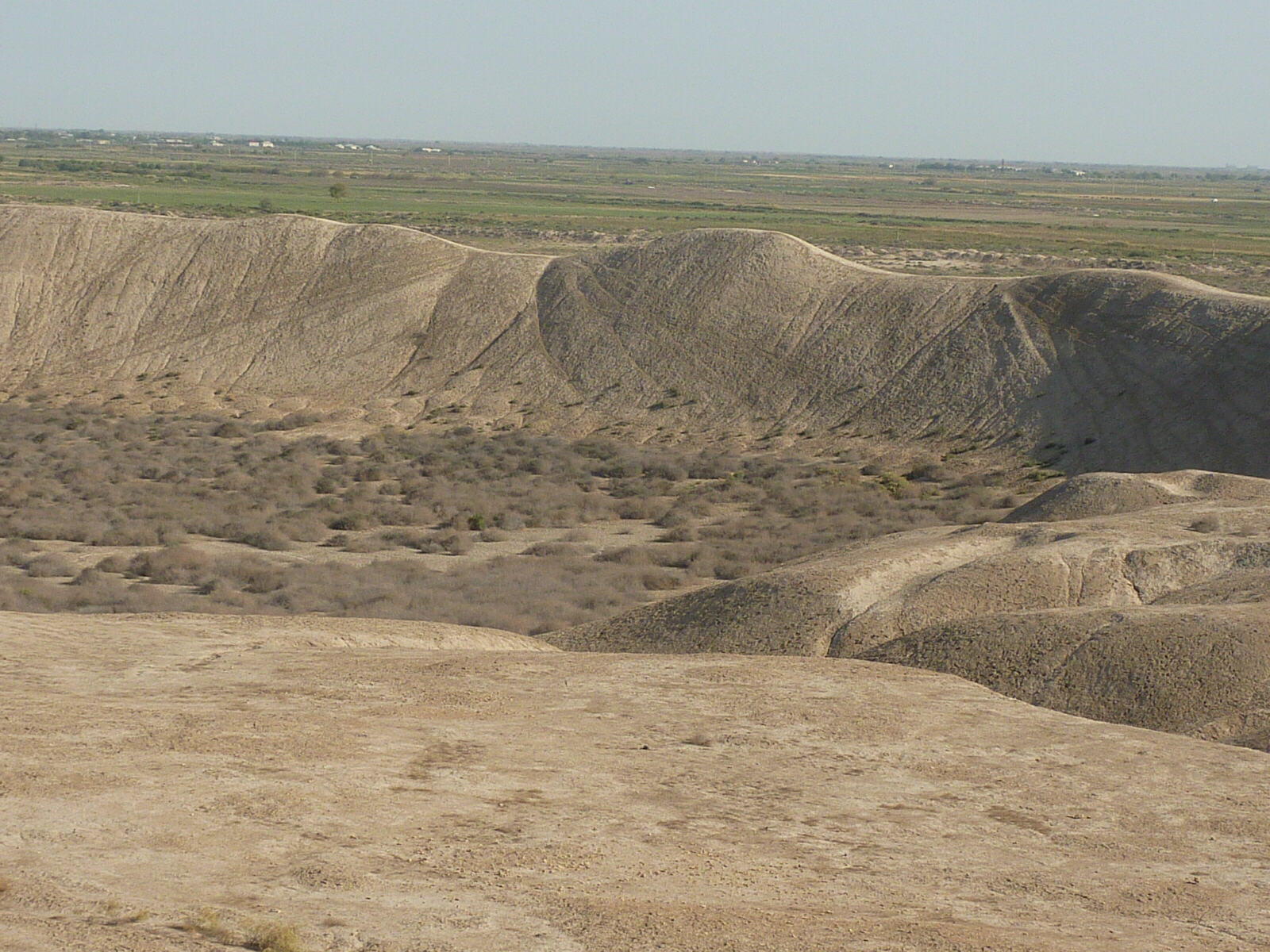
|
Then we drove on across the Amu Darya river (the Oxus in ancient times) on a rickety metal bridge, then through winding country lanes past a long queue of more than a hundred lorries to the Uzbek border. The lorries seem to go through about one every 20 minutes so they must have to wait days for their turn. There were very few other foot passengers and Batyr saw us through the Turkmenistan side very easily. There is then about a two-mile gap to the Uzbekistan border post but minibuses go back and forth if you don’t want to walk it. We used our last few Turkmen Manat for the minibus on the Turkmen side, but he could only take us to the little stream that forms the actual border and there was no sign of the Uzbek minibus so we walked the rest of the way. The nice customs lady saw us struggling to fill in the Russian-language customs form and brought us English ones, but wouldn’t accept any mistakes or crossings-out and I had to go back and do mine again. |
Uzbekistan
- Bukhara
|
Eventually we were through into Uzbekistan and ready to do battle with the cluster of taxi drivers waiting outside the border compound gates. The customs lady said a whole taxi (not shared) for the 100km to Bukhara should cost $30 (£19), the drivers started asking $60 (£38) and after a lot of haggling and standing around and a weird dance with one of the drivers to the music of a nearby radio, we agreed $40 (£25) and set off. Immediately over the border everything seemed to change – Turkmenistan had been sunny and warm and still, but in Uzbekistan the wind was howling and a sandstorm blew up. Turkmenistan was mostly desert but here there was agriculture and donkey carts loaded with hay or grasses. |
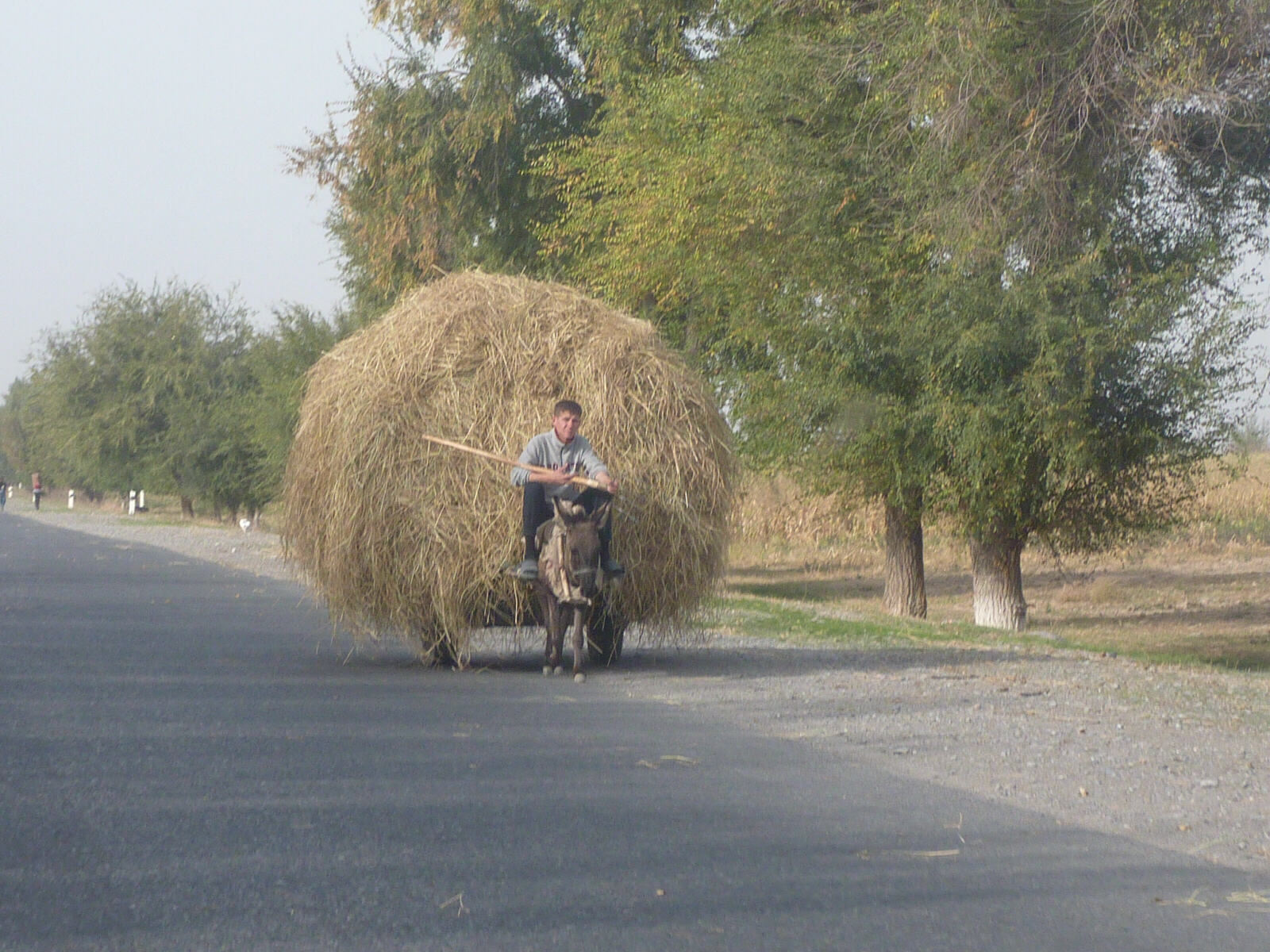
|
Turkmenistan was obviously richer (they have huge reserves of natural gas) with lots of big, gleaming new buildings in Ashgabat city (but not in the villages of course) and all the cars looked new and expensive. Here the cars were older and smaller. The one thing they share of course is plenty of Soviet-style bureaucracy. Turkmenistan seemed to have hardly any shops and hardly any tourists but as we discovered when we reached Bukhara, Uzbekistan has coach-loads of tourists and we had trouble finding a hotel because many were full. The taxi driver seemed to be getting impatient while we looked for somewhere, but when we finally settled on the Shoxtut hotel, just off the main historic square, he seemed very pleased with the $40. Like several of the nearby hotels the Shoxtut is built in the style of a traditional merchant’s house and the people there were extremely friendly and helpful. |
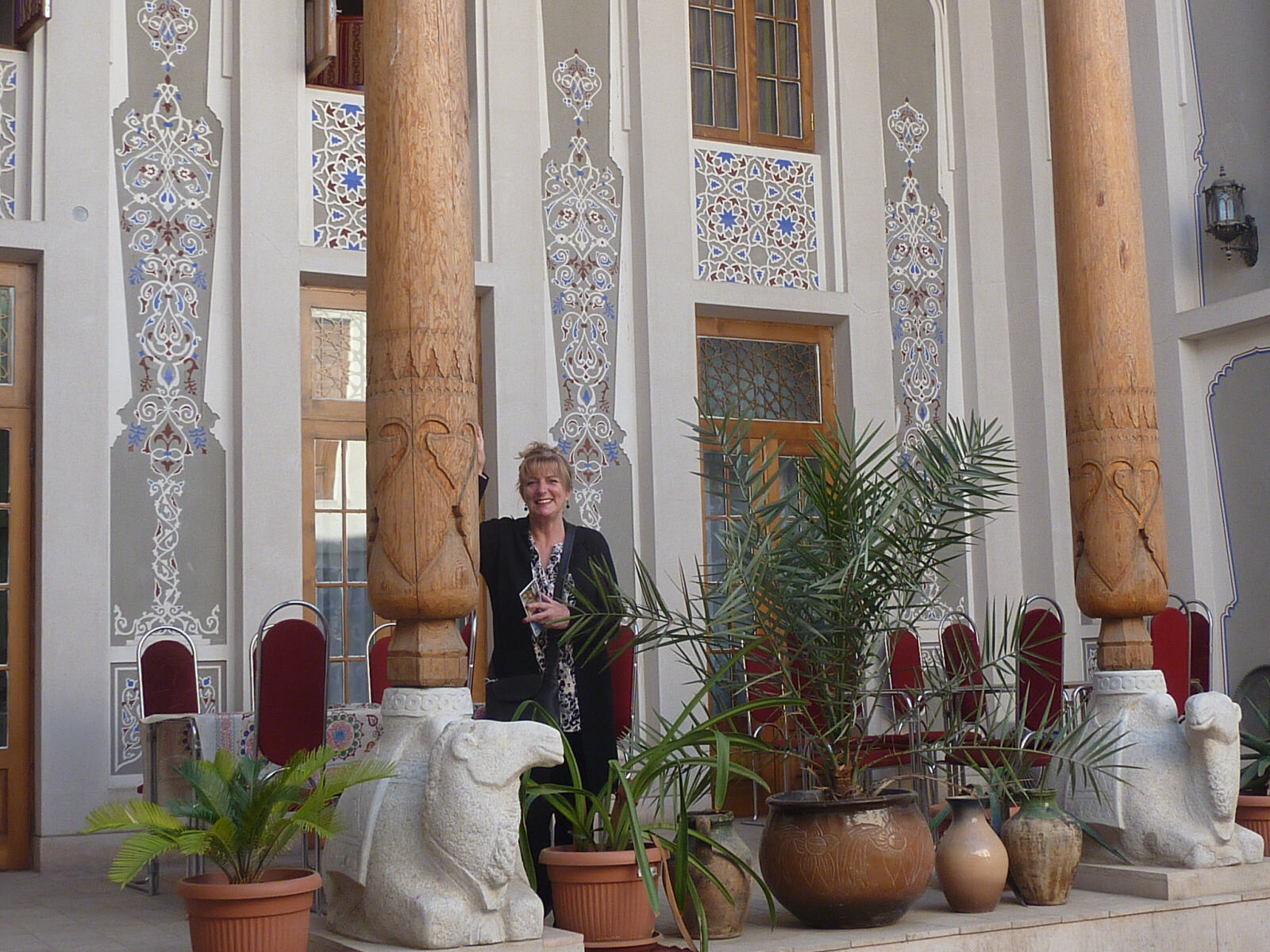
|
We tried to go to the next-door restaurant because it’s run by friends of the hotel people but it was full so we walked down the square to the Saroy restaurant and had very nice steaks (actually slices of tender beef) with local beer and Italian red wine for $37 (£23).
Weds 8th. The Shoxtut is arranged around a courtyard and the very nice breakfast was set out in the ornate high-ceilinged reception room across the courtyard. Sitora, the nice lady who co-owns the hotel with her sister, very kindly drove us to the bank to draw out some money in US$ on our card (there are no ATMs but you can withdraw USD from debit or credit cards at the banks; some banks take Visa cards, others Mastercard. The commission charge seems to be 2% or 3%). We changed some dollars into Som, the local currency. There only seem to be small-denomination banknotes worth about 30 pence each so we came away with a couple of bricks of money. Eventually about midday we set out to do our first real sightseeing of this holiday, following the Lonely Planet walking tour of Bukhara. We set out down Sarrafon Street to the southern part of the old town but soon got hopelessly lost in the maze of featureless streets. Yesterday’s sandstorms and showers had disappeared and it was clear, sunny and bright so we navigated by the sun (at least I did, Sheila admits she never has a clue where she is) to find our way back to Nuqshband, the street through the middle of the old town alongside the canal, and followed it round to the ‘Ark’. The Ark is the old royal fortress with thick walls, occupied from the 5th century up to 1920 when the Russian Army knocked it about a bit. We walked back to the centre of the old town past blue-domed mosques and madrassas (religious schools) .... |
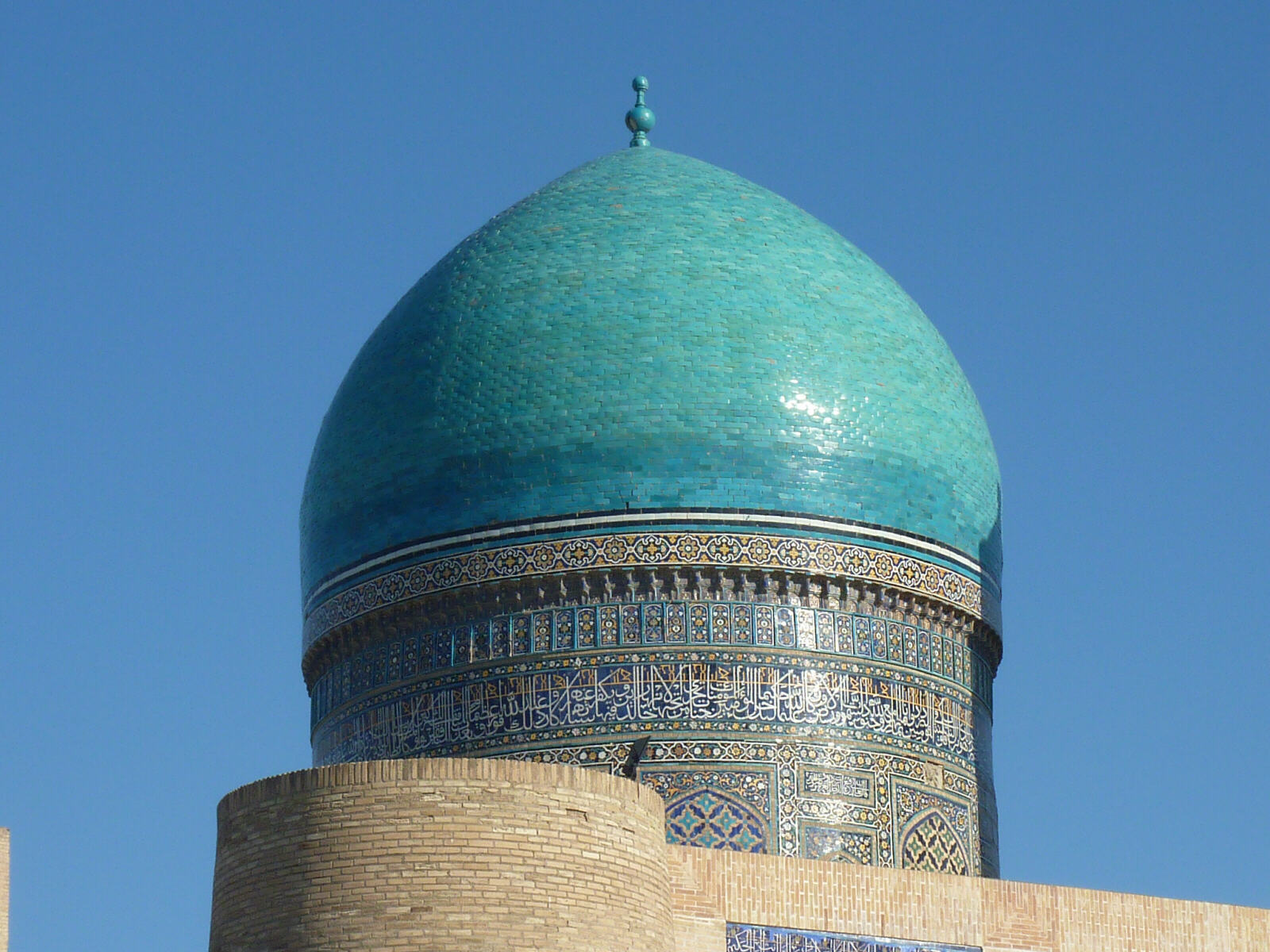
|
.... historic minarets ....
|
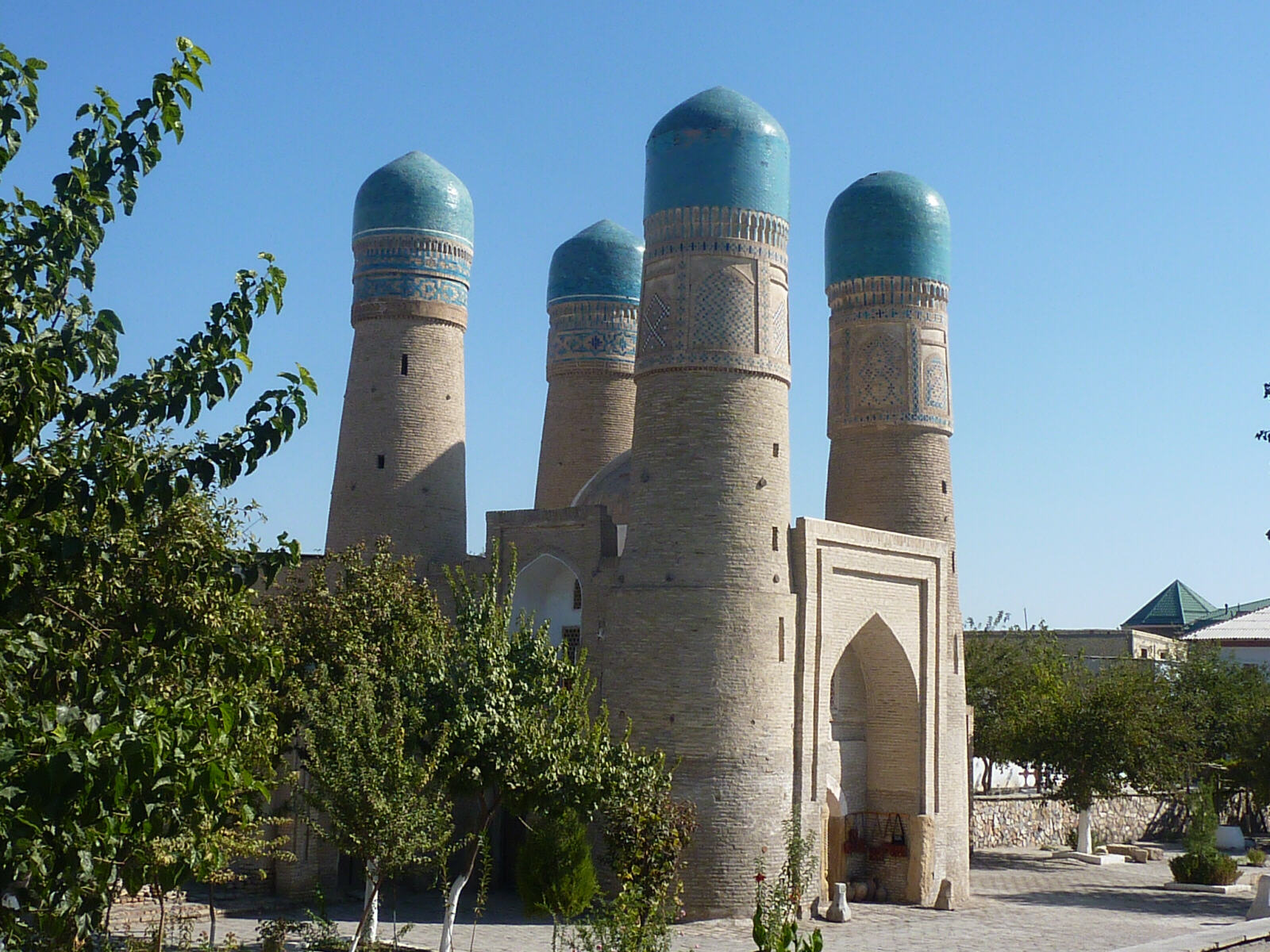
|
.... and covered bazaars.
|
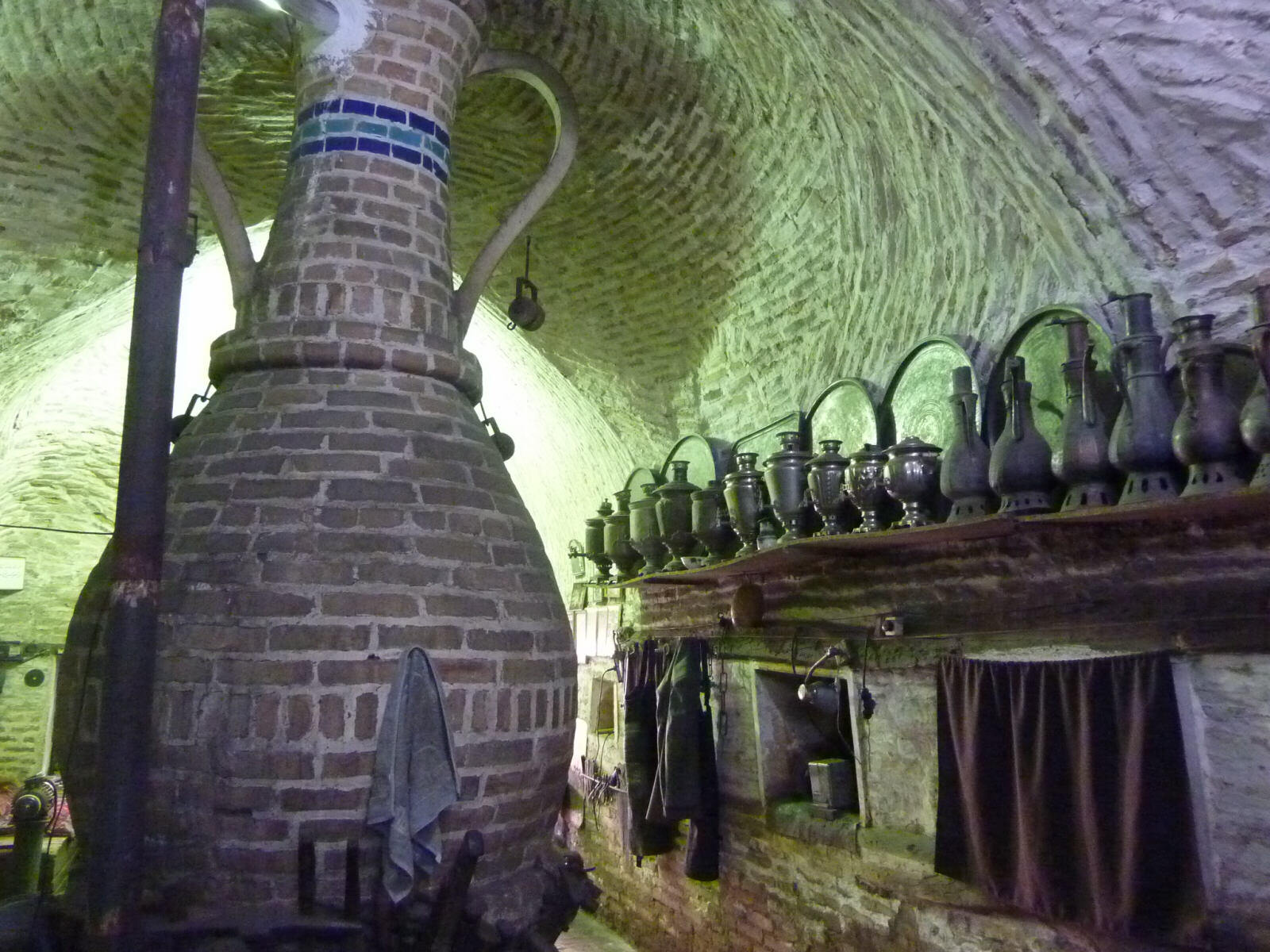
|
After a coffee and ice cream at a Lavazza café we used the Internet for a while (with some difficulty, it is always slow and often non-existent in Uzbekistan, and phone calls are expensive and have a huge delay which makes conversations difficult), then booked a table at Chinar restaurant next door to the hotel. We went back at 7pm and had a delicious meal of kebabs, Bukhara pilaf and salads (a selection of which came on a big tray so you could choose which ones you want), washed down as usual with local beer (Sheila) and Italian red wine (John).
Thurs 9th. We spent the morning in a salon getting Sheila’s hair coloured (she’s not ready to look or act her age yet) and a trip back to the bank for more dollars, then more sightseeing in Bukhara old town through bazaars, in madrassas with huge colourful entrance gateways and sparkling blue domes and back to the Ark (fortress) to visit the museums that were closed yesterday. |
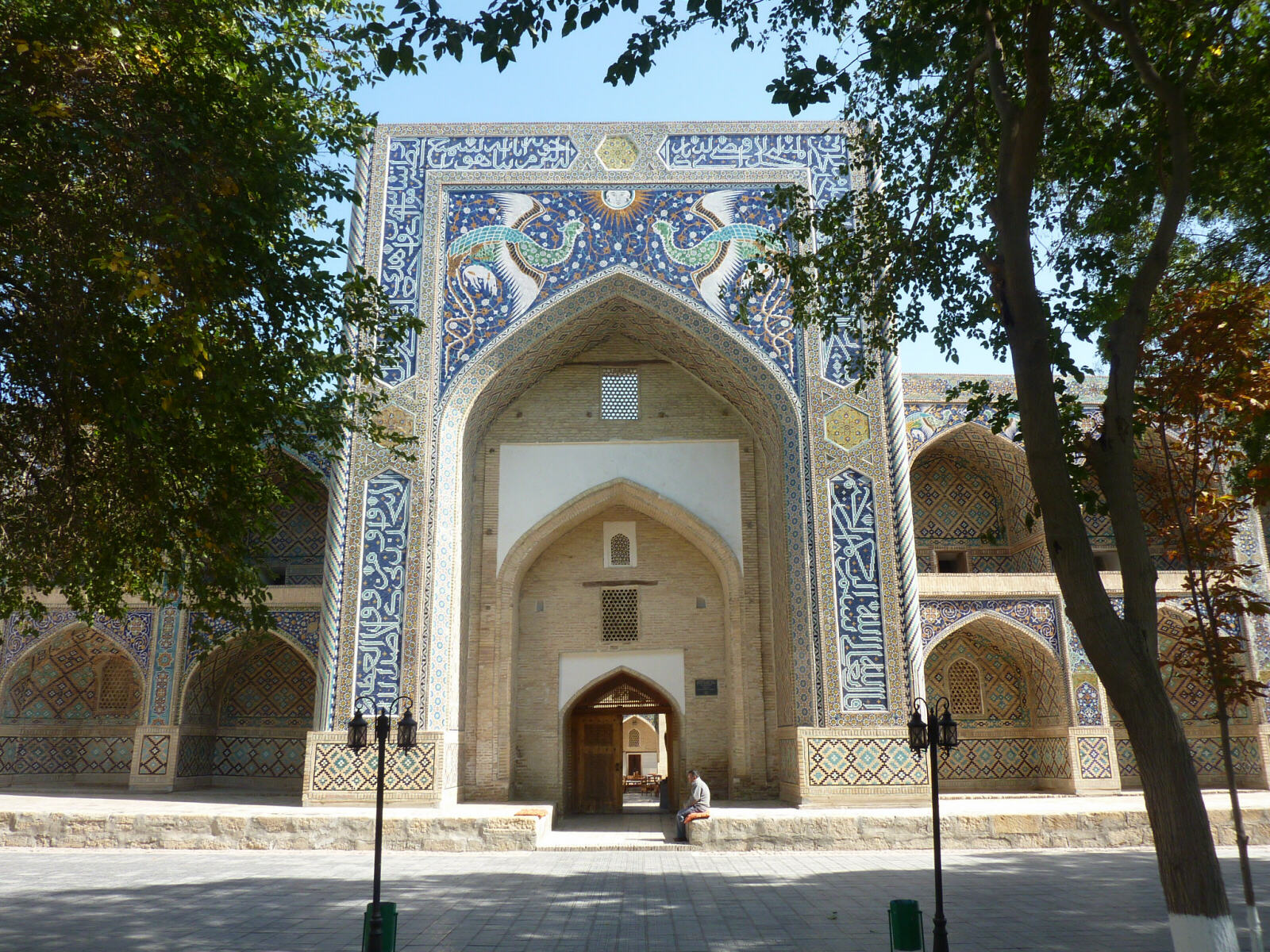
|
We got back to the pool in the centre of town just in time to sit and have a coffee and a beer as the sun went down. After a bit of shopping for postcards we went for another excellent meal at the Chinar. |
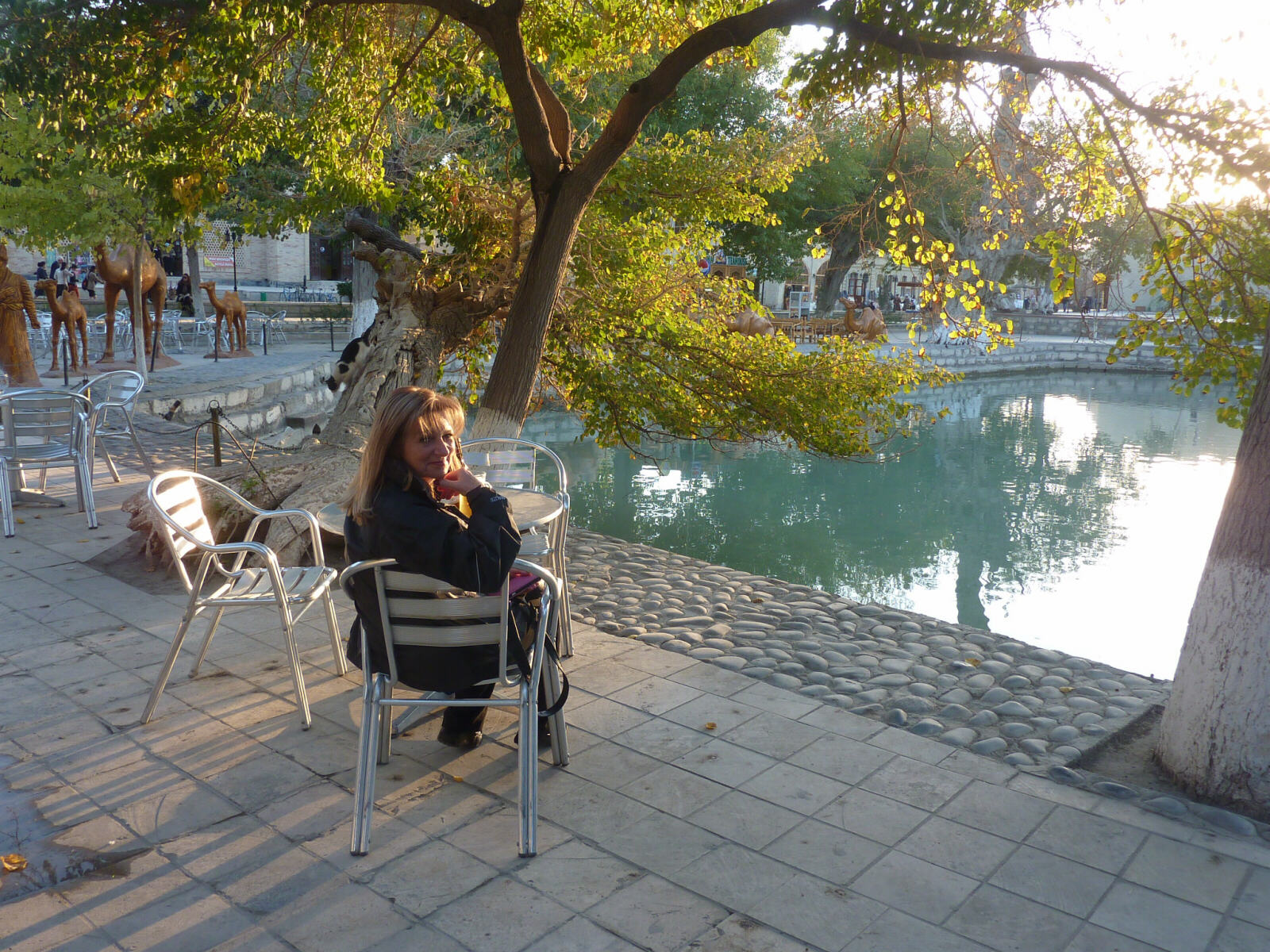
|
Fri 10th. We had tried to negotiate a price to go to Khiva, about 470 km away, with the taxi drivers outside the hotel. They started at $200 and quickly came down to $150, so we said we’d think about it and went sightseeing but one of them came and found us and said he’d do it for $100 (£62). We thought this was the best we’d get as tourists but Sitora said it was far too much and phoned a friend who found a driver who’d take us for $70 (£44). So after breakfast the driver was waiting for us and the lovely people from the hotel, and even our waiter from the restaurant next door, came and waved us off. At first the land was agricultural and there were irrigation ditches but after a while it turned to scrubby desert, the road surface deteriorated to potholes and sand dunes were blowing across the road. The temperature climbed steeply from 9 degrees (C) when we set off at 9am to 19 degrees by 11 o’clock. As usual on long-distance taxi journeys, no sooner had we got going than we stopped to fill the car up, only this time it wasn’t petrol but methane gas and we, like all the other passengers, had to get out and wait outside the compound while he filled up. There is no petrol (apart from a bit on the black market, sold from plastic bottles by the side of the road), only diesel, methane and propane in Uzbekistan, which would be a problem if you tried to drive here in your own car. Some say petrol is deliberately rationed by the government, others say by the petrol stations who can get a lot more for it on the black market. About half-way to Khiva, as we crossed from one province to another, the road suddenly changed into a brand-new, nearly empty dual carriageway and we sped smoothly along. The scrubby desert continued unchanged. After quite a long time we passed into another province and the road changed back to potholes. About 3pm we skirted round the industrial sprawl of Urgench and followed the trolleybus wires to Khiva’s western gate. |
Uzbekistan
- Khiva
|
We walked into the old city and went into the first hotel we found inside the gates, the Orient Star, in a lovely renovated old madrassa and the most upmarket hotel in the place, where we got a cozy upstairs room with a domed ceiling and a bathtub in one of the former study cells for $75 (£47), worth every penny. The rooms downstairs weren’t nearly so nice. |
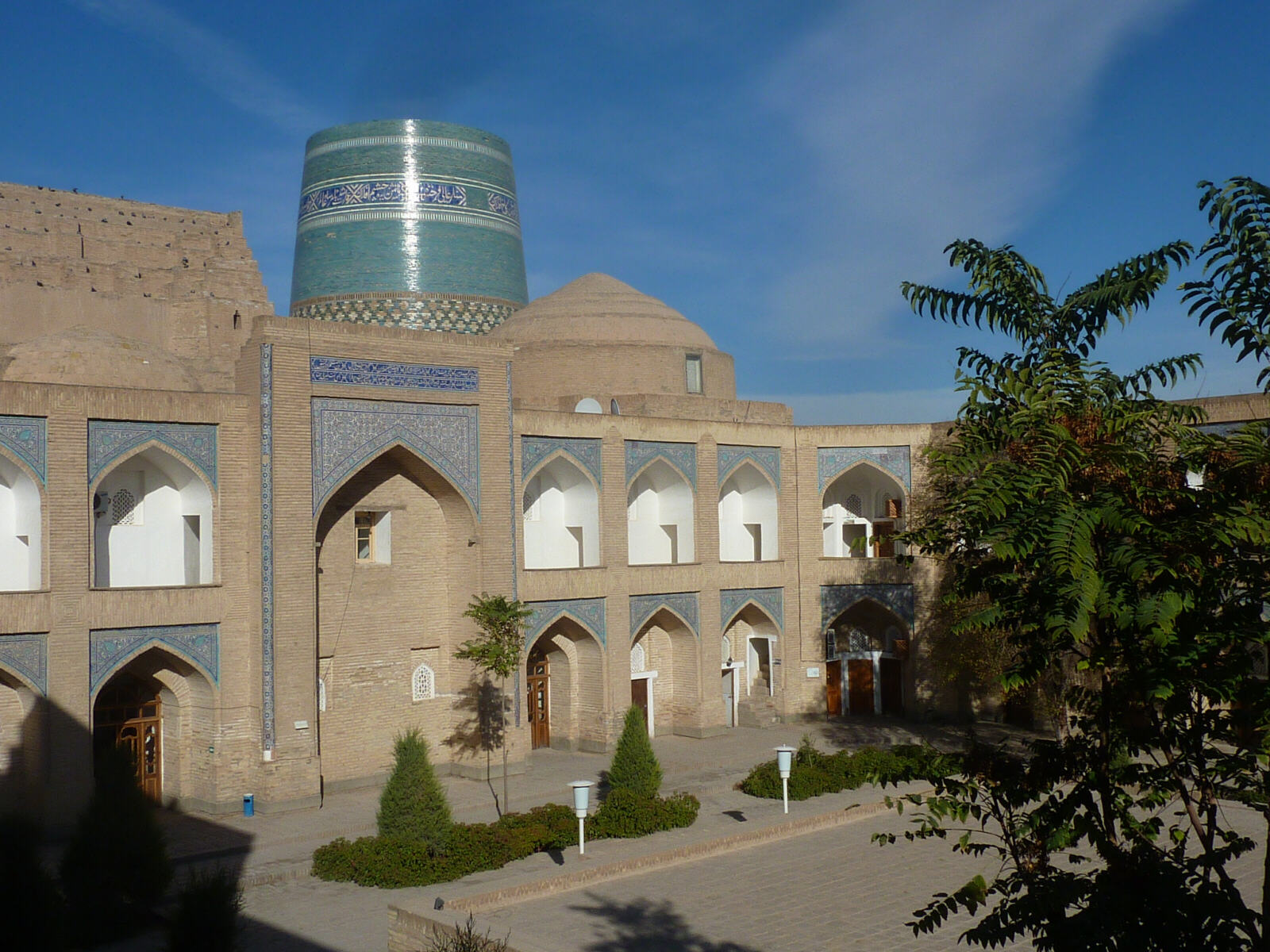
|
We walked around the compact old town trying not to see all the sights (got to save something for tomorrow) and taking photos of the mellow brickwork of the gates, minarets, and domes in all shades of blue, in the setting sun. |
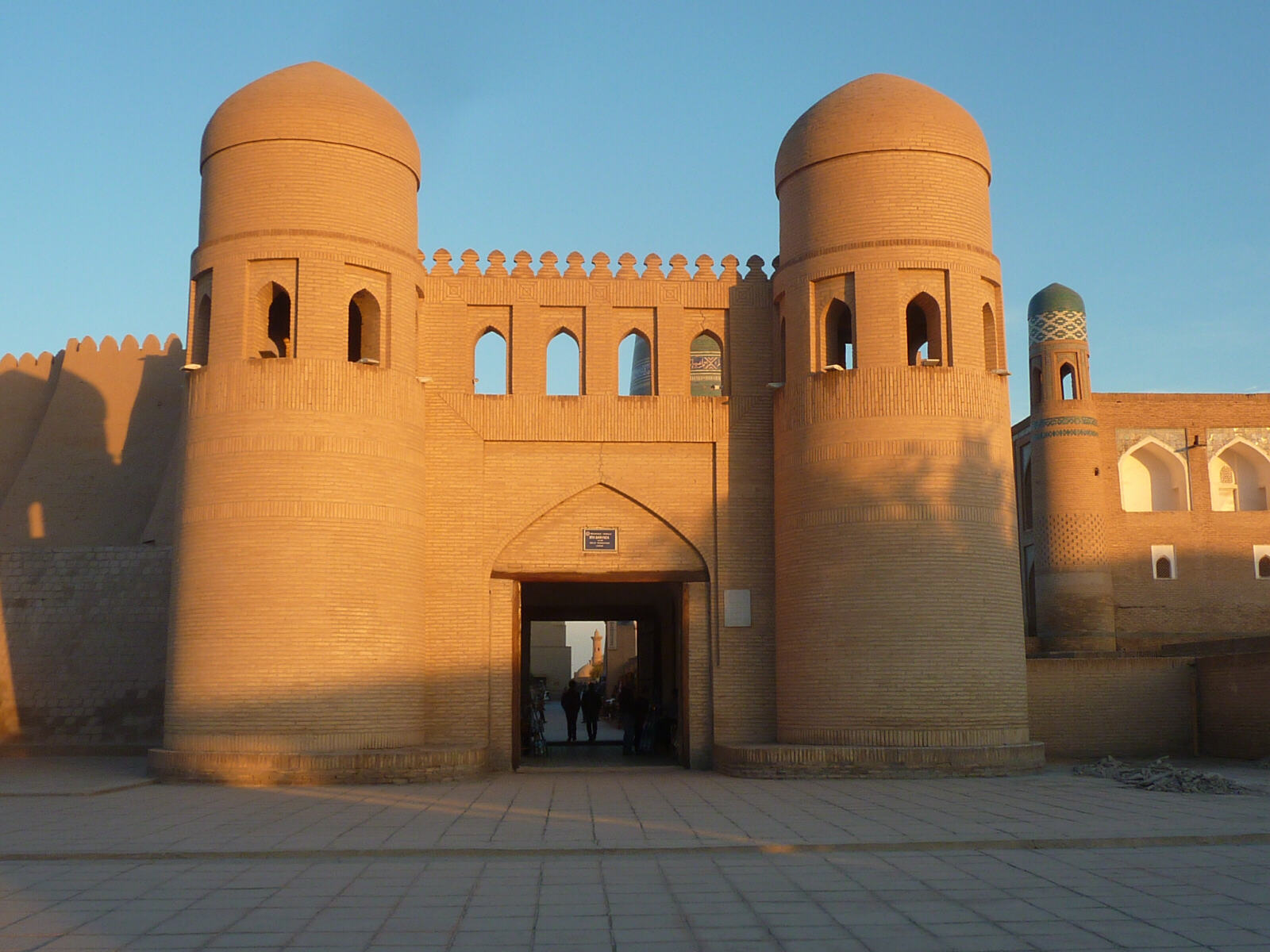
|
We went for dinner at the Khorezm Art restaurant near the East Gate and had a nice meal from the rather limited menu accompanied by local Uzbek beer and red wine from Samarkand. Sheila thought my wine tasted like paint stripper but it was fine after a couple of glasses. It was quite chilly walking back through the nearly-deserted streets (although it was only 9pm) but our cozy room was warm and dark and quiet and we slept really well.
Sat 11th. After a buffet breakfast (which I enjoyed but Sheila didn’t, she said it tasted like luncheon meat and processed cheese, although the fried eggs were good) in the huge, ornate but modern-looking madrassa next door to the hotel (absolutely packed with French tourists until they left for their scheduled tour) .... |
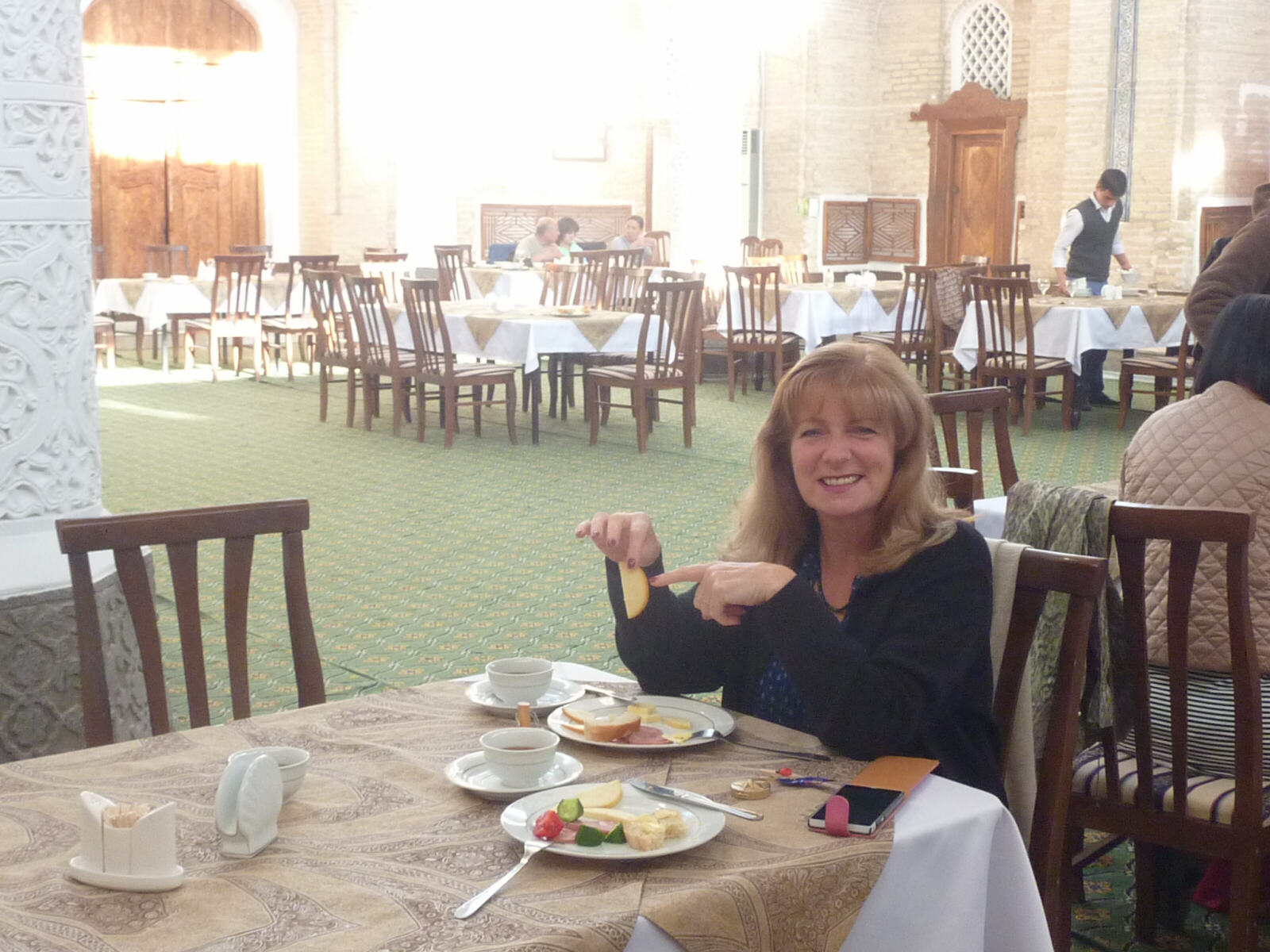
|
.... we walked up to the North Gate and into the rather featureless new town to send some postcards from the post office. On our way back we negotiated with the taxi drivers outside the gate for our ride to Moynaq, where the Aral Sea used to be, tomorrow, then went up the ramp and walked along the north-west corner of the old city walls. Unfortunately when we got to the fortress in the middle of the west wall it was a dead end and we had to backtrack all the way back.
|
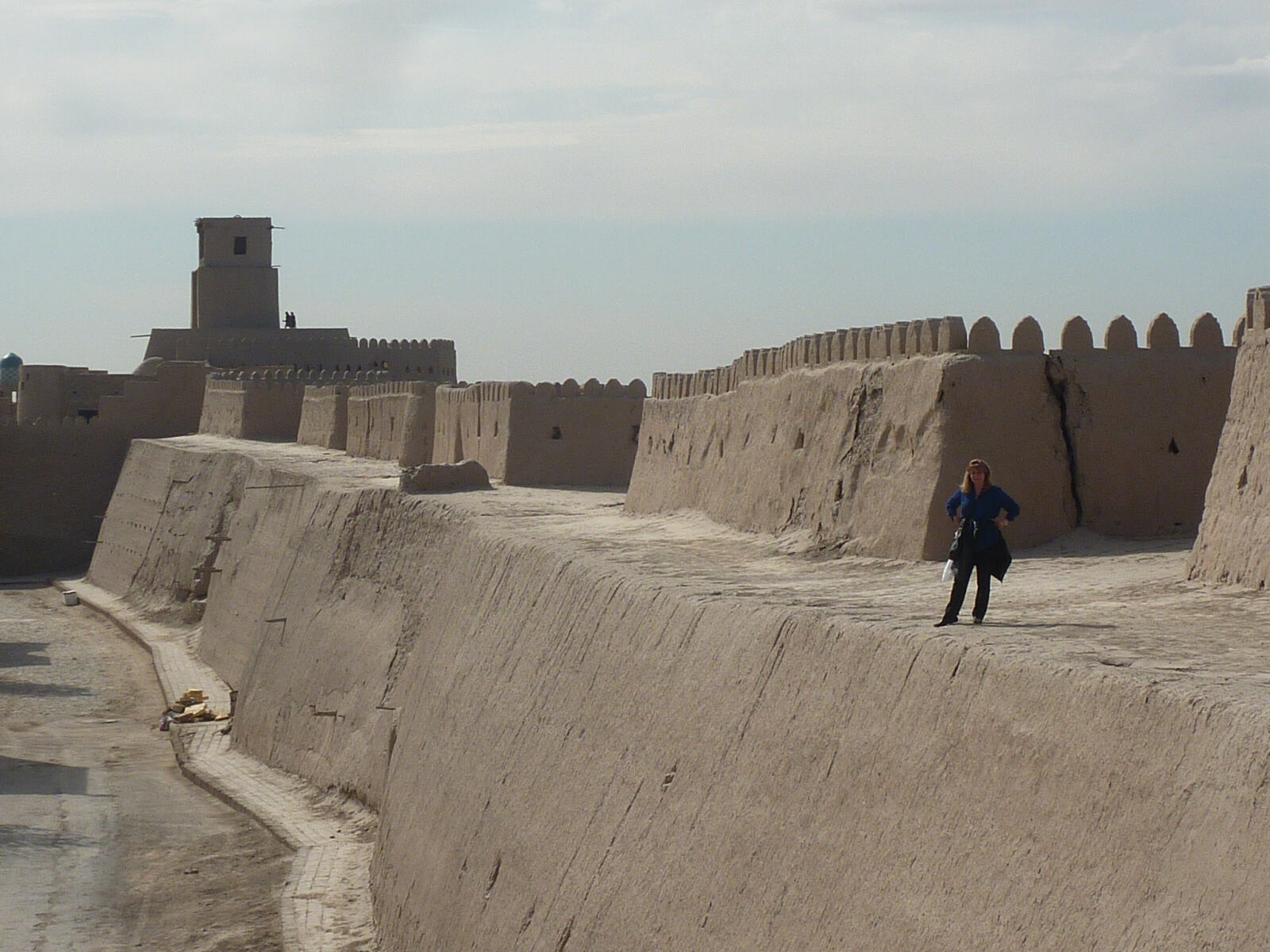
|
We had a look in the Juma mosque with its forest of ancient wooden pillars holding up the roof. |
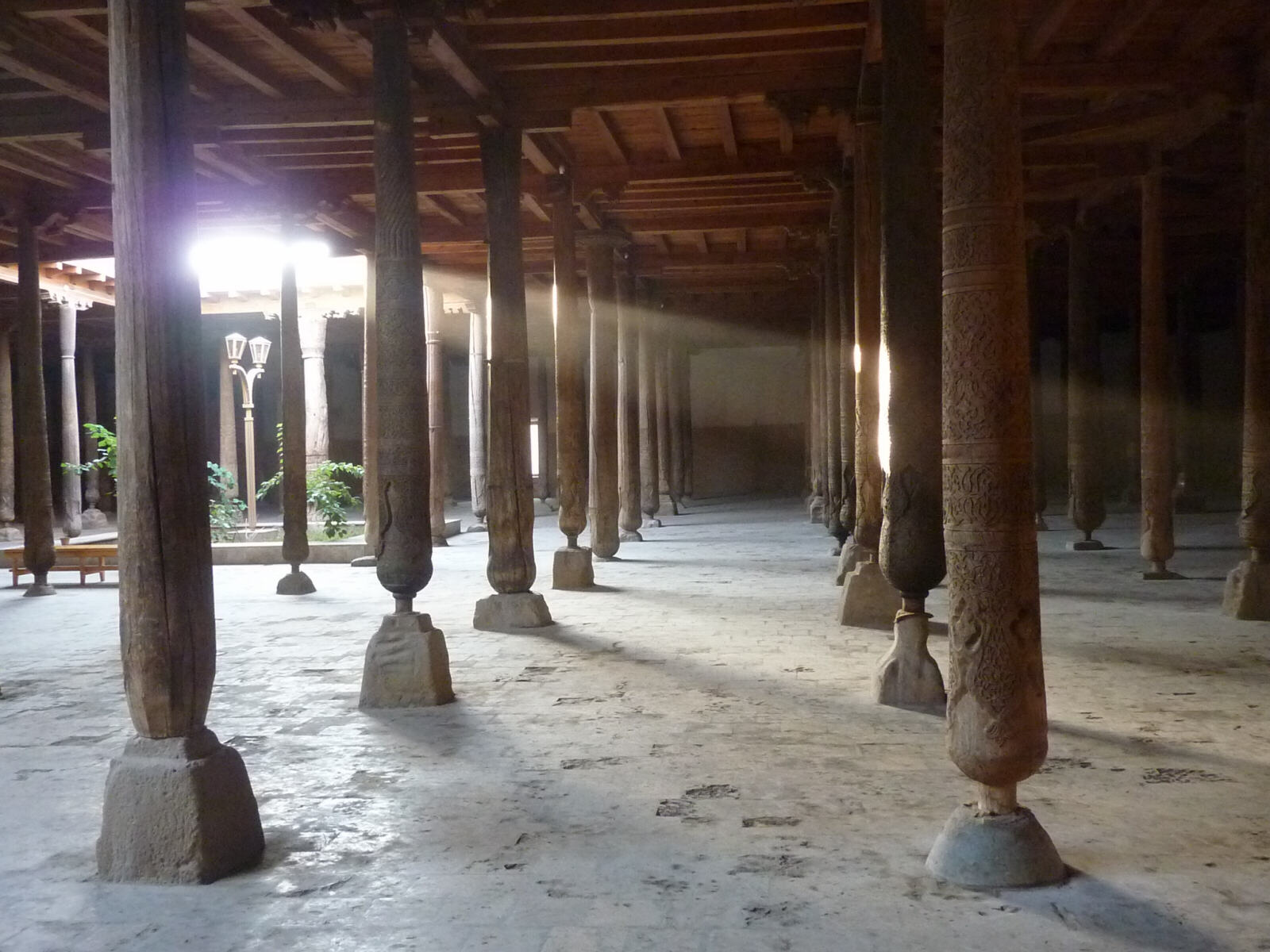
|
We enquired about using the Internet in a couple of places but apparently it ‘is very slow today’ everywhere in town (the same every day as far as we can tell), so instead we climbed up the 118 steep, dark steps to the top of the 45m-tall Islom-Huja minaret for good views of the old town. |
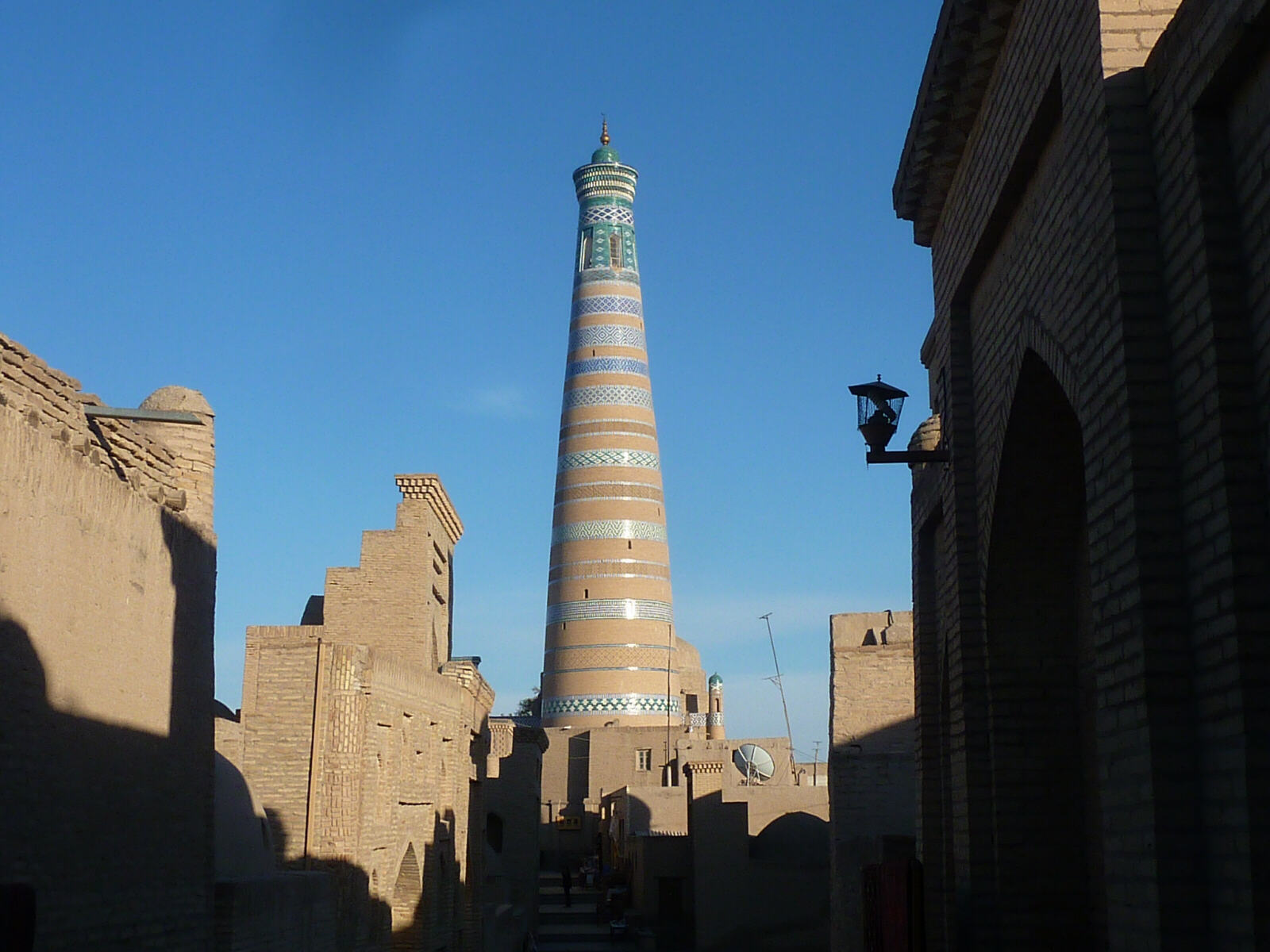
|
There are no shops as such but lots of tourist stalls selling tourist trinkets. However Sheila’s eyes lit up at the fur stalls – she eventually settled on a Russian silver fox fur collar, apparently the only decent one in the whole of Khiva, and believe me she looked at every single one - most still had the head, legs and tail attached. The fur hats were very tempting but would look a bit silly on the high street back home. Luckily she didn't buy one of the astrakhan ones, especially as we found out that the genuine ones come from lambs only a few days old, or ideally removed from the womb before they are born. We had a lunch of soup and a Mars bar in our nice hotel room and I had a walk round to the South Gate but found there are no other places where you can get onto the walls. Later we went to the ‘Ark’, the fortress of the rulers of Khiva, and went up to the pavilion at the top for great views of the old town. We walked over to the bazaar outside East Gate but it was closing up, so we went back to the Malika hotel and restaurant and had a drink sitting in their outside restaurant before going inside to have a meal, which was really nice except it arrived all in the wrong order – main courses then soups and finally vegetable accompaniments. Just as we were paying the bill the power went off all over town and we walked back looking at the stars in a clear, unpolluted sky. |
- The Aral Sea
|
Sun 12th. We were up early to meet our nice English-speaking taxi driver at 6am. We found out that he was the chap that the hotels call when they have someone who wants to go to Moynaq, so we were lucky to get him without the hotel commission added. We set off across the desert as the sun rose and headed north, stopping halfway at Nukus for breakfast at Hotel Nukus. About midday we arrived at the former fishing port of Moynaq where the Aral Sea used to be, and stopped at an information display showing how the sea had shrunk over the last 50 years, since planners in Moscow had decided to divert all the water from the rivers to irrigate the cotton plantations. On a low cliff overlooking the former sea we looked at the boats slowly rusting away in the sand which stretched to the horizon – what’s left of the sea itself is now 200 miles / 300 km away. |
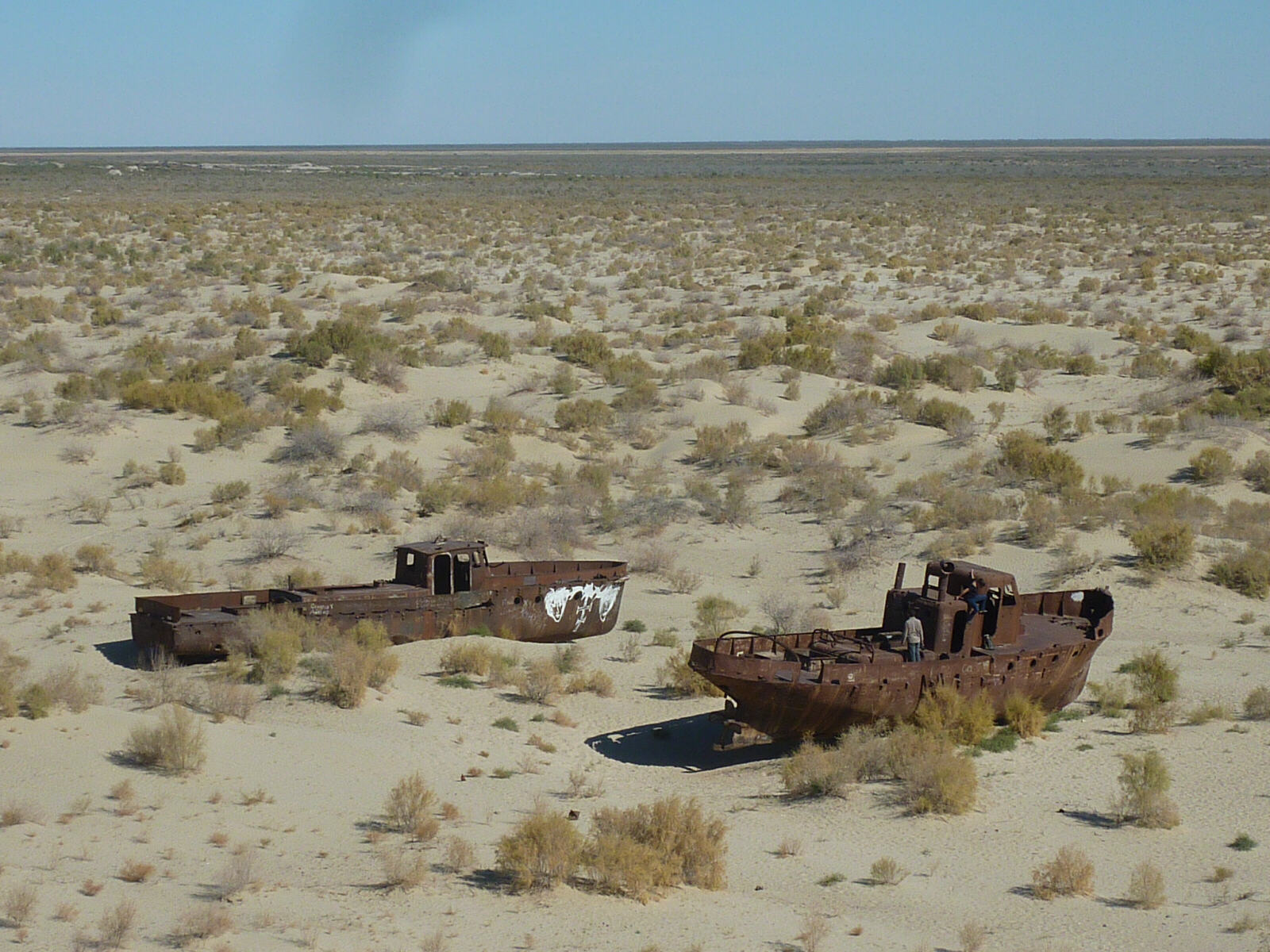
|
Cotton picking - the water that irrigates this cotton used to flow into the Aral sea. |
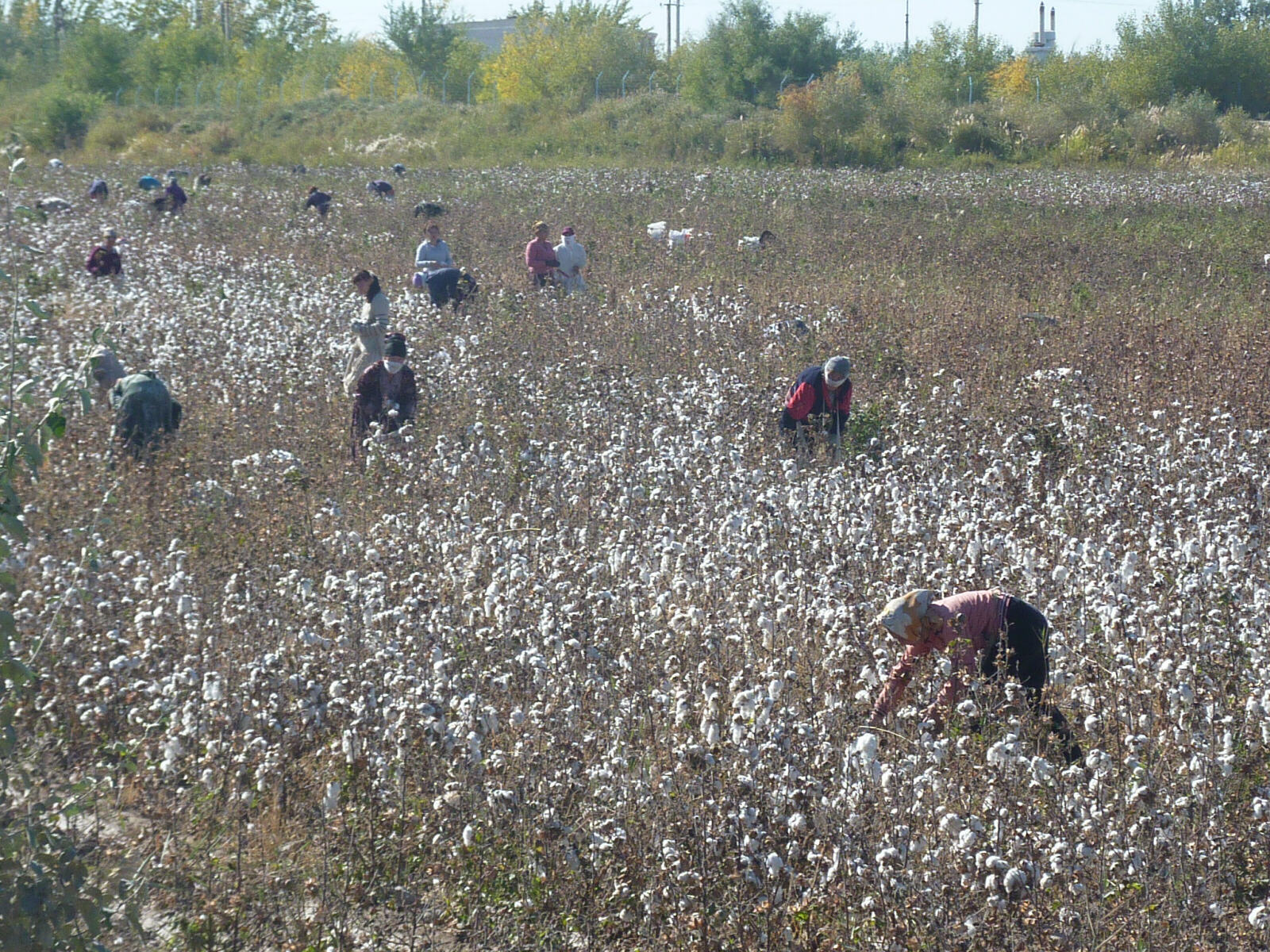
|
A former island that used to be a Soviet biological weapon testing site (anthrax, plague, etc.) is now part of the mainland and locals blame it for the terrifyingly sudden death within half an hour of half a million antelopes on the steppe nearby. We walked along the sands and climbed onto the rusting hulks sitting sadly in the midday sun. We drove back, stopping once at a roadside café for lunch of delicious noodle soup. We arrived back at the west gate of Khiva soon after 6pm, 12 hours and about 800km later. We went back to Malika restaurant and sat out in the garden drinking beer and wine and stroking the tabby cat in the pleasant mild evening (the warmest day we have had so far) before going indoors to the restaurant for another delicious pizza. |
- Bukhara again
|
Mon 13th. We had a last walk around Khiva in the morning sunshine then met our driver for Bukhara, supposedly the brother of yesterday’s driver although he didn’t look anything like him; Sheila wasn’t going to get into the car until he pulled out a piece of paper with our names and hotel room number on it to prove who he was. We had to stop twice to fill the car with methane gas, once for the driver to have a coffee because he was sleepy and once for lunch at a roadside place which we saw with dismay was full of coachloads of tourists, but they were just leaving and actually it was very nice sitting out under the trees having a kebab. We arrived back at Shoxtut hotel where the lovely ladies were waiting to greet us like long-lost friends. We asked about a room with a bathtub and they gave us the huge luxury room at the top of the house, with a vast bedroom and big bathroom with a huge bathtub. Wonderful! Usually Sheila brings lots of bubble-bath on holiday and there’s never a bathtub in sight but this time she didn’t bring any and many of the rooms have had tubs. We had a short stroll round, changed some more dollars to bricks of local money and had dinner at our restaurant next door to the hotel.
Tues 14th. We were both a bit below par with some sort of a bug, so we had a quiet day. We did go to the local bazaar and tried to draw out some more dollars at the NBU but for some reason it didn’t work so he advised us to try Kapital Bank which was quite a bit further out of town, but we managed to get the cash there. In the evening we sat beside the pool in the centre of town and had an ice-cold beer. |
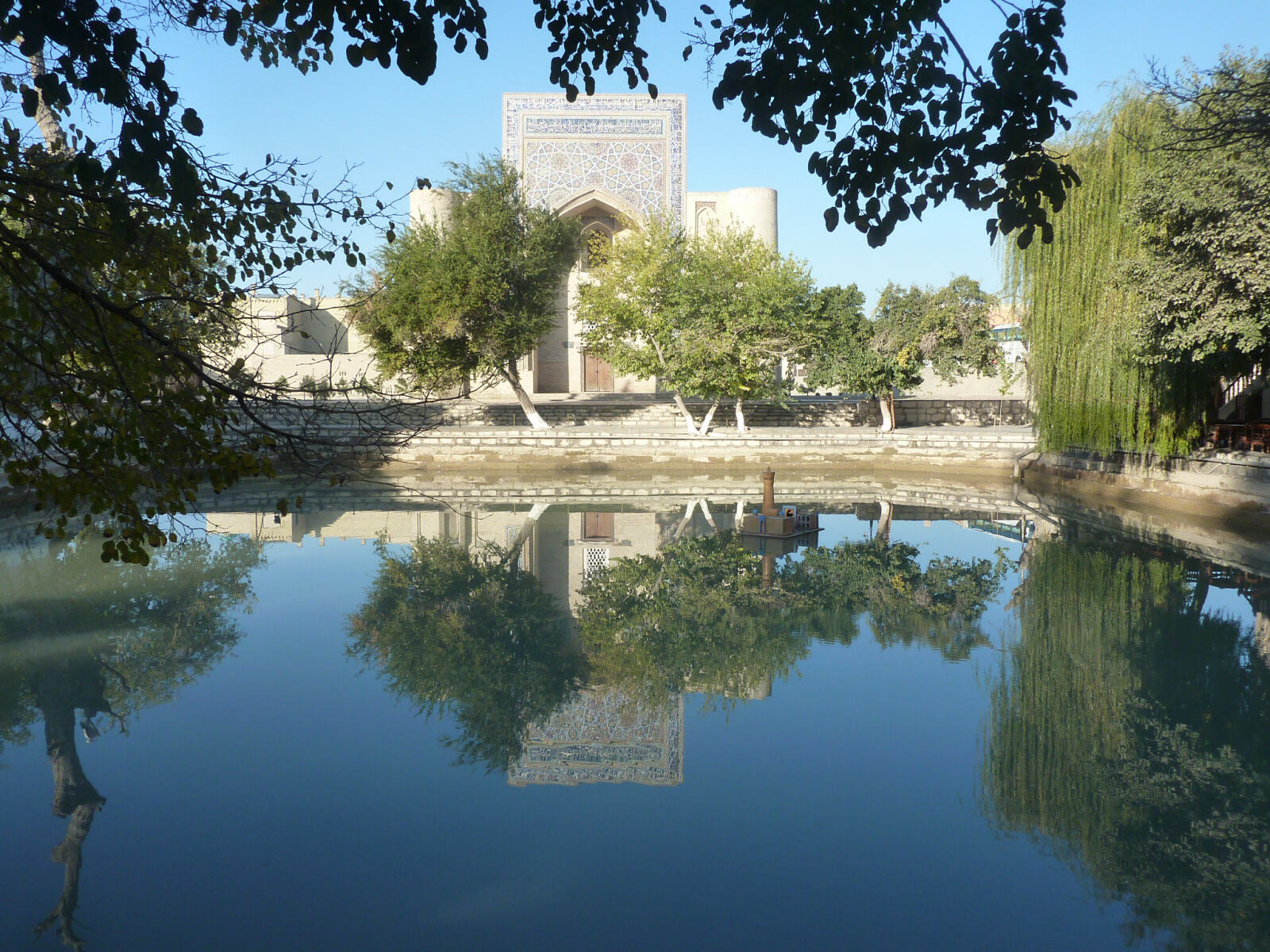
|
Weds 15th. Another quiet day enjoying Bukhara, walking through the bazaars .... |
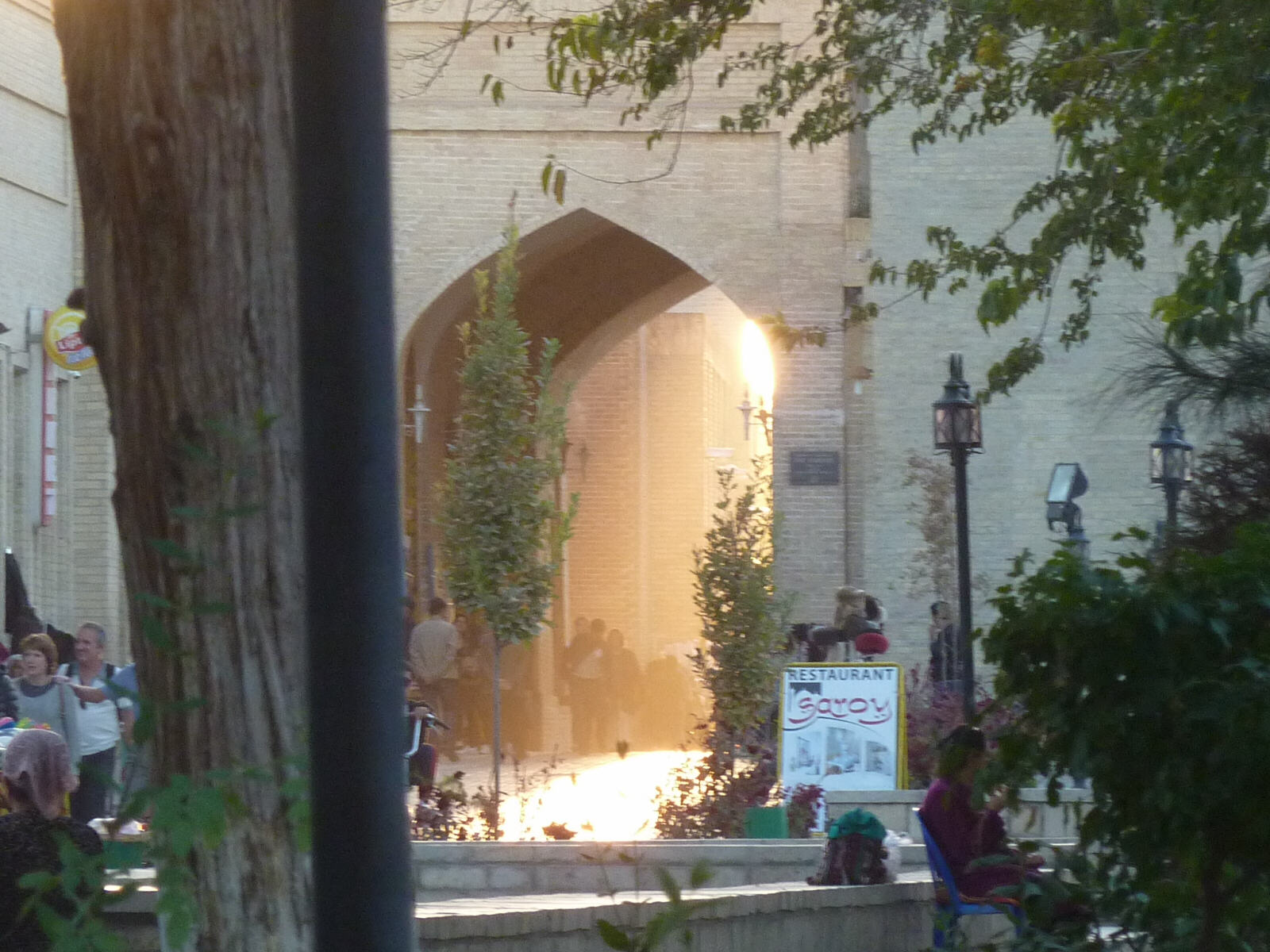
|
.... and looking at the blue-green domes. |
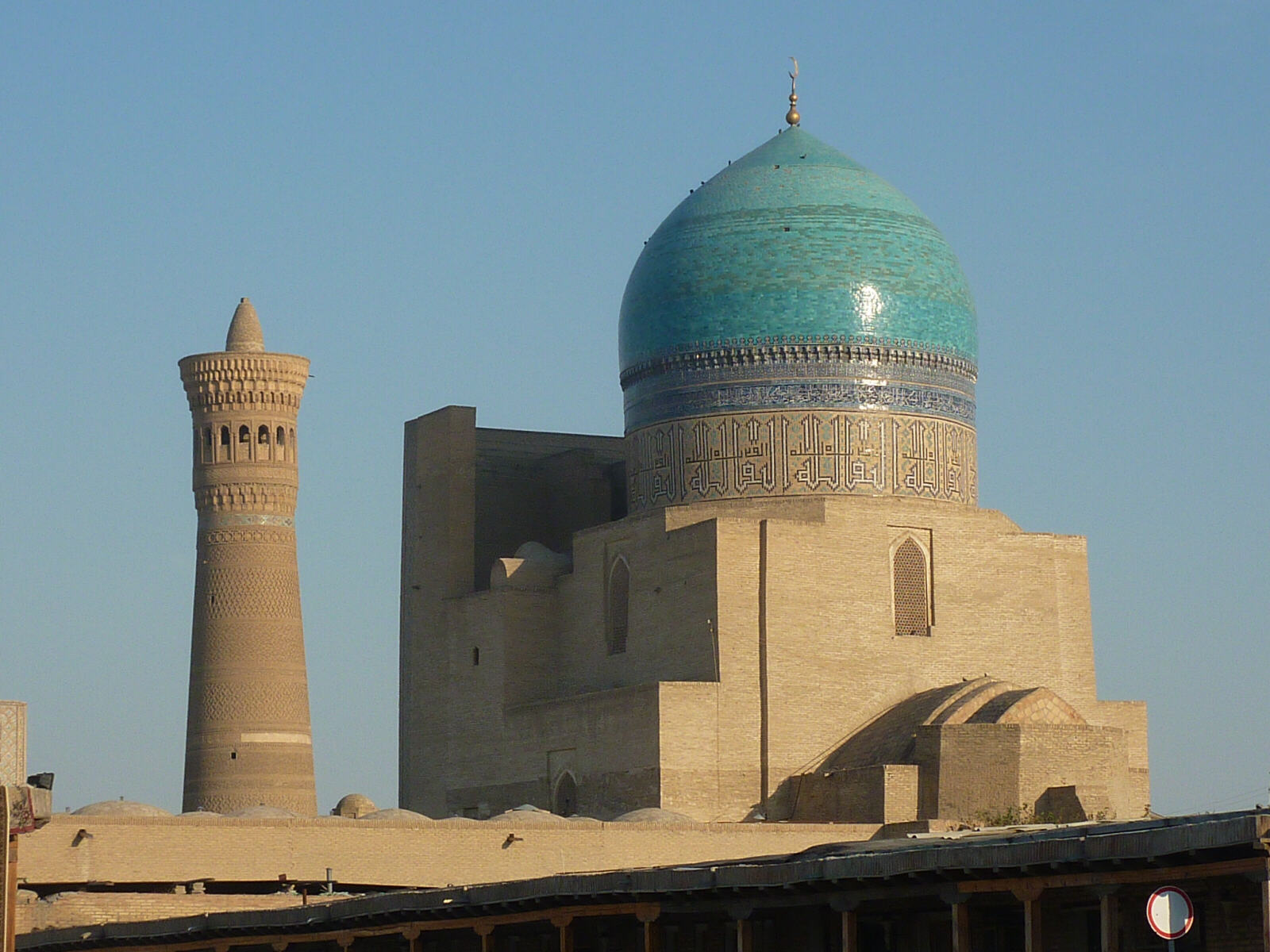
|
In the evening Sheila still wasn’t ready to face a big meal so I went and had the buffet at Lyabi Hauz restaurant, sitting outside in a prime position beside the lake under a spreading willow tree. It was the warmest evening yet and I was comfortable in shirtsleeves all the time. |
Uzbekistan
- Samarkand
|
Thurs 16th. We had the same nice driver who took us to Khiva and at 9am we said goodbye again to Sitora, Victoria and Hope, the lovely ladies at the Shoxtut hotel and set off along the Silk Road to Samarkand. It was a slow four-hour journey because there were villages almost all the way with strictly-enforced speed limits, and we still managed to get caught in a radar speed trap and the driver had to pay a fine (not sure how much, but we gave him a tip at the end which will soften the blow). It was another cloudless day and the temperature climbed to 24 degrees outside, and much more in the car as the sun streamed in through the windows.
Our first impression of Samarkand was disappointing – it’s a big sprawling town with more aggressive drivers typical of cities. As we drove past the fabulous Registan, the monumental group of medieval buildings that Samarkand is famous for, they seemed marooned in a park, disconnected from the city and the old town of which they were once the thriving central square. We stayed at the new Hotel Caravan Serail in a nice old building with a garden in a courtyard in the old town, and walked from there down some featureless back streets to the Registan, which was certainly impressive and fabulously ornate, but rather frozen and purposeless without the city around it. We walked up Tashkent Street, the pedestrianised shopping street, which was all very clean, modern and sterile, past the spectacular Bibi-Khanym mosque to the rather featureless, purpose-built modern main bazaar, which was still busy in the late afternoon although it starts about 6am. There are no restaurants in the old city – tourist groups eat in their hotels and the main restaurants are in the new city a mile or two away. There are several local cafes around but they have no menus at all, never mind anything in English. So we walked back to the Hotel Asia on Hosh Hauz Street between the Caravan Serail and the Registan and had a late lunch/early dinner of Uzbek ‘champagne’ (sweet sparkling wine) and Pringles crisps sitting in their garden. We went back to Registan Street to find a reputed Internet café that wasn’t there, then retired for an early night.
Fri 17th. After a nice buffet breakfast at Caravan Serail hotel we set off sightseeing. We went back to the main bazaar which was busy, but still not quite as crowded as we expected. |
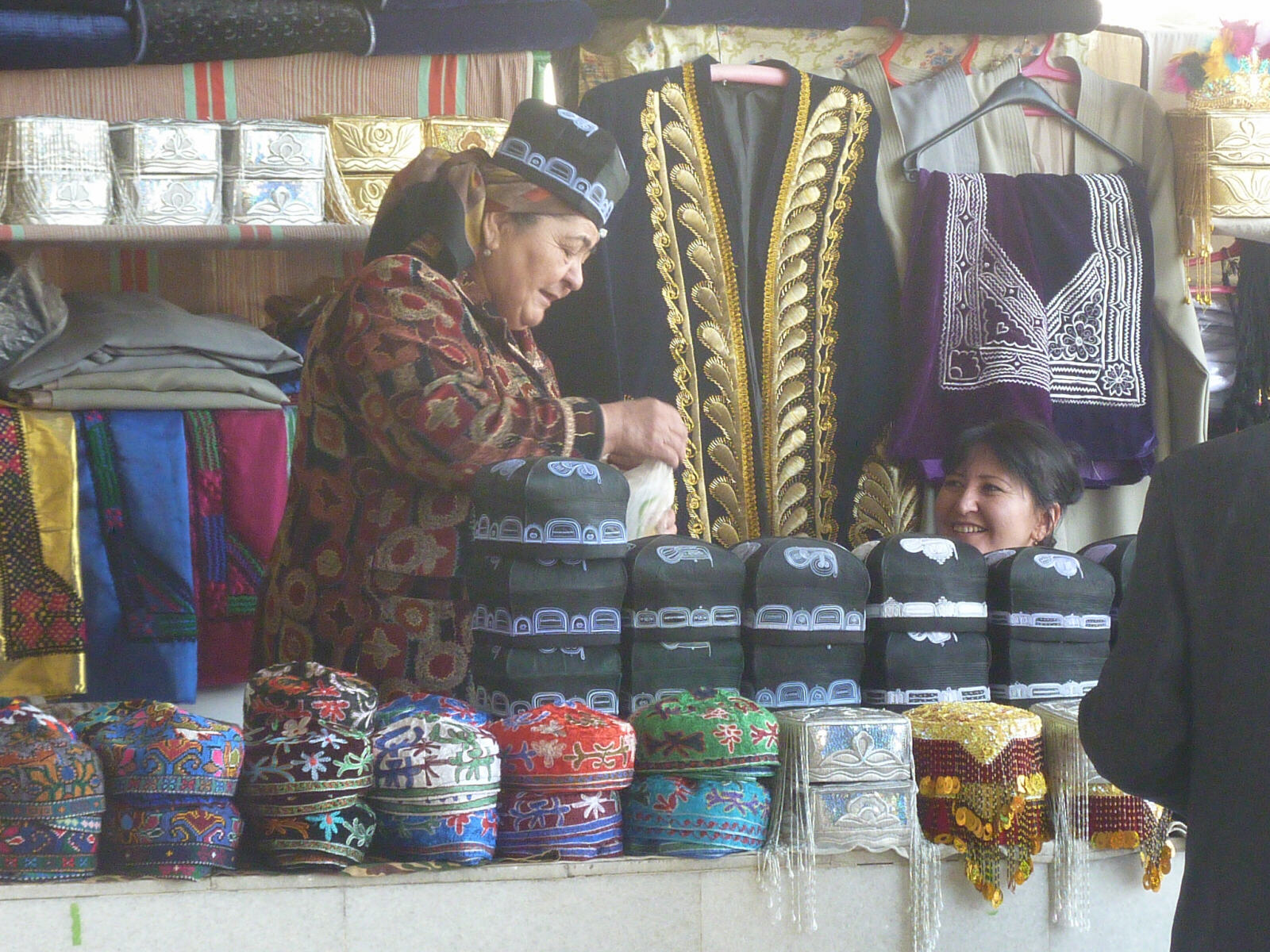
|
Bread or non-bread? Confusing signs in the bazaar! |
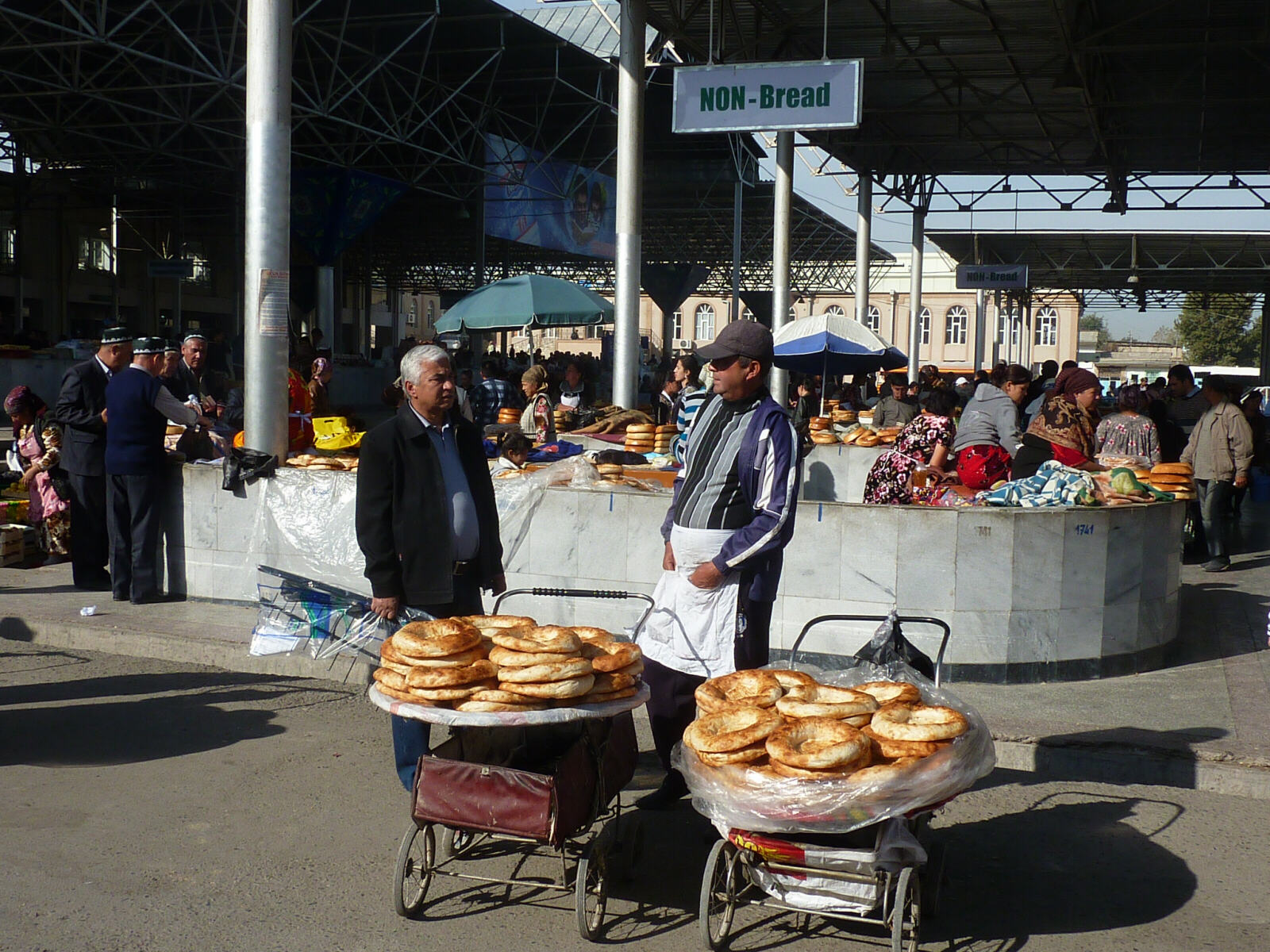
|
From there we went by a convenient side door into the huge and impressive Bibi-Khanym mosque, with four enormous gateways around a shady central garden area. We didn’t intend to bypass the ticket desk but as we left by the main gateway we realized that’s what we had done. |
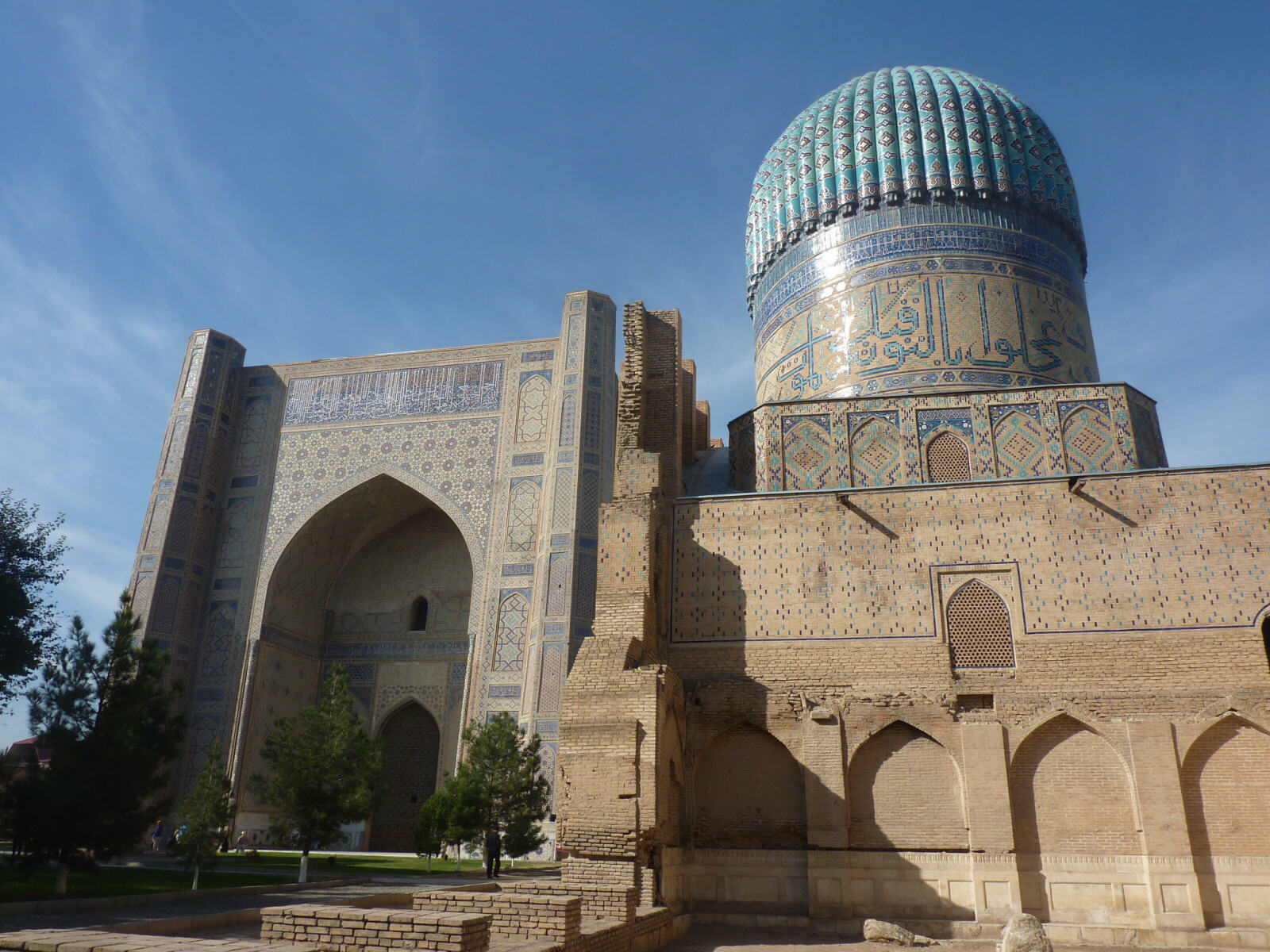
|
We waited for the little electric bus that runs up and down Tashkent Street and went down to the other end where the Registan is. The Registan is three huge madrassas with towering, lavishly-tiled facades in shades of blue, arranged around three sides of a square. |
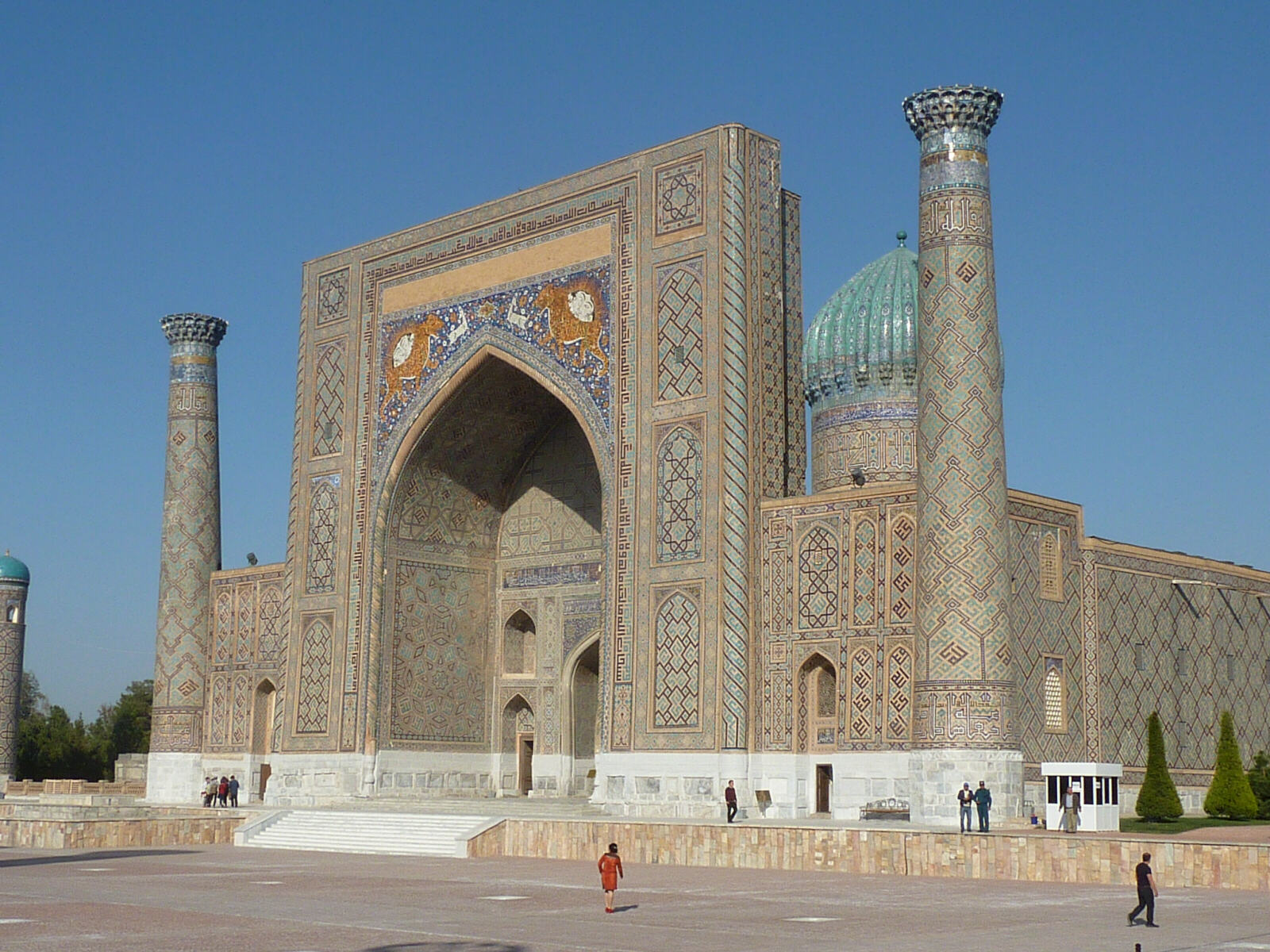
|
We took our time exploring all three of them and taking countless photos of the ornate and colourful tilework, .... |
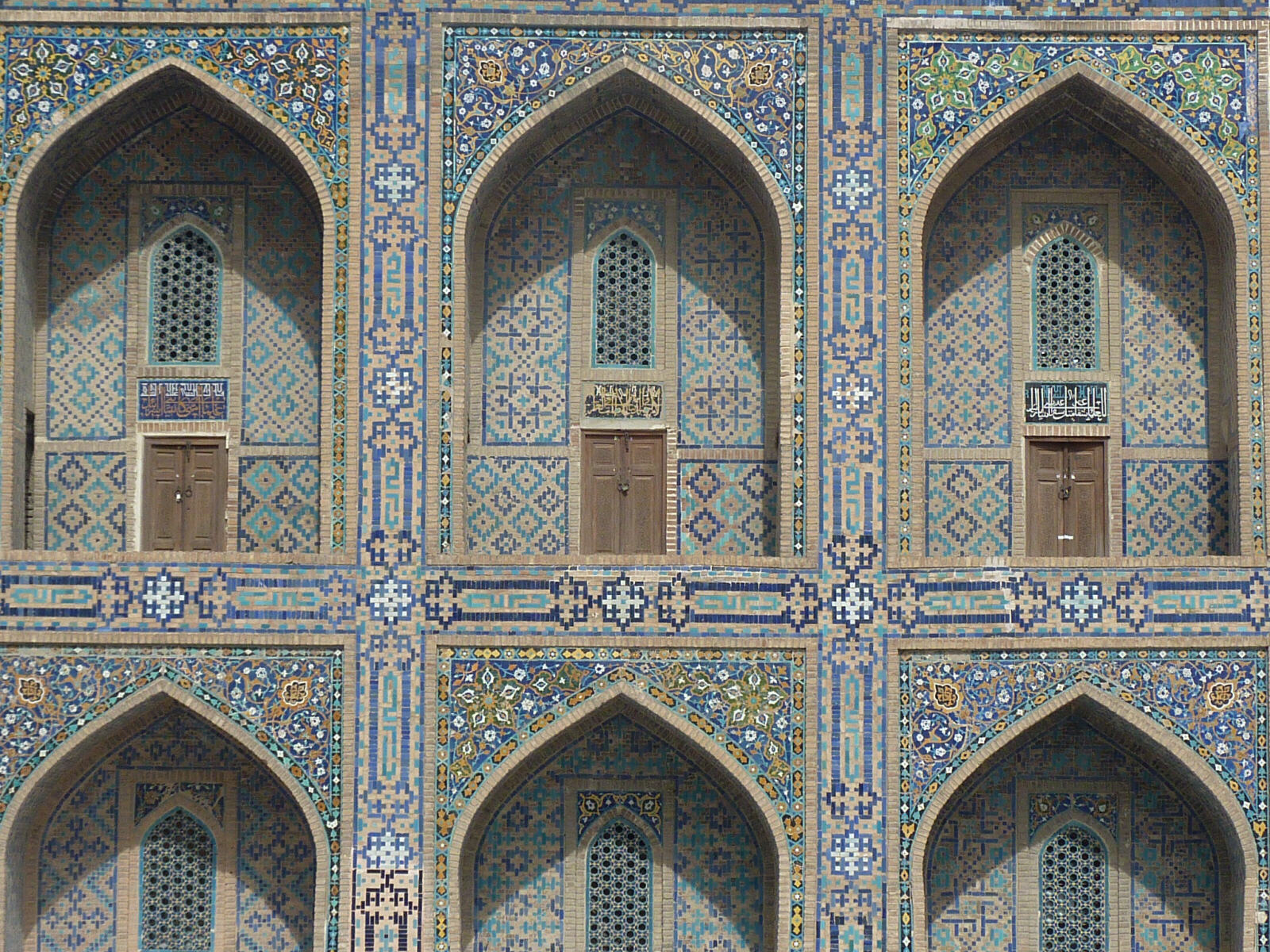
|
.... archways and doorways. |
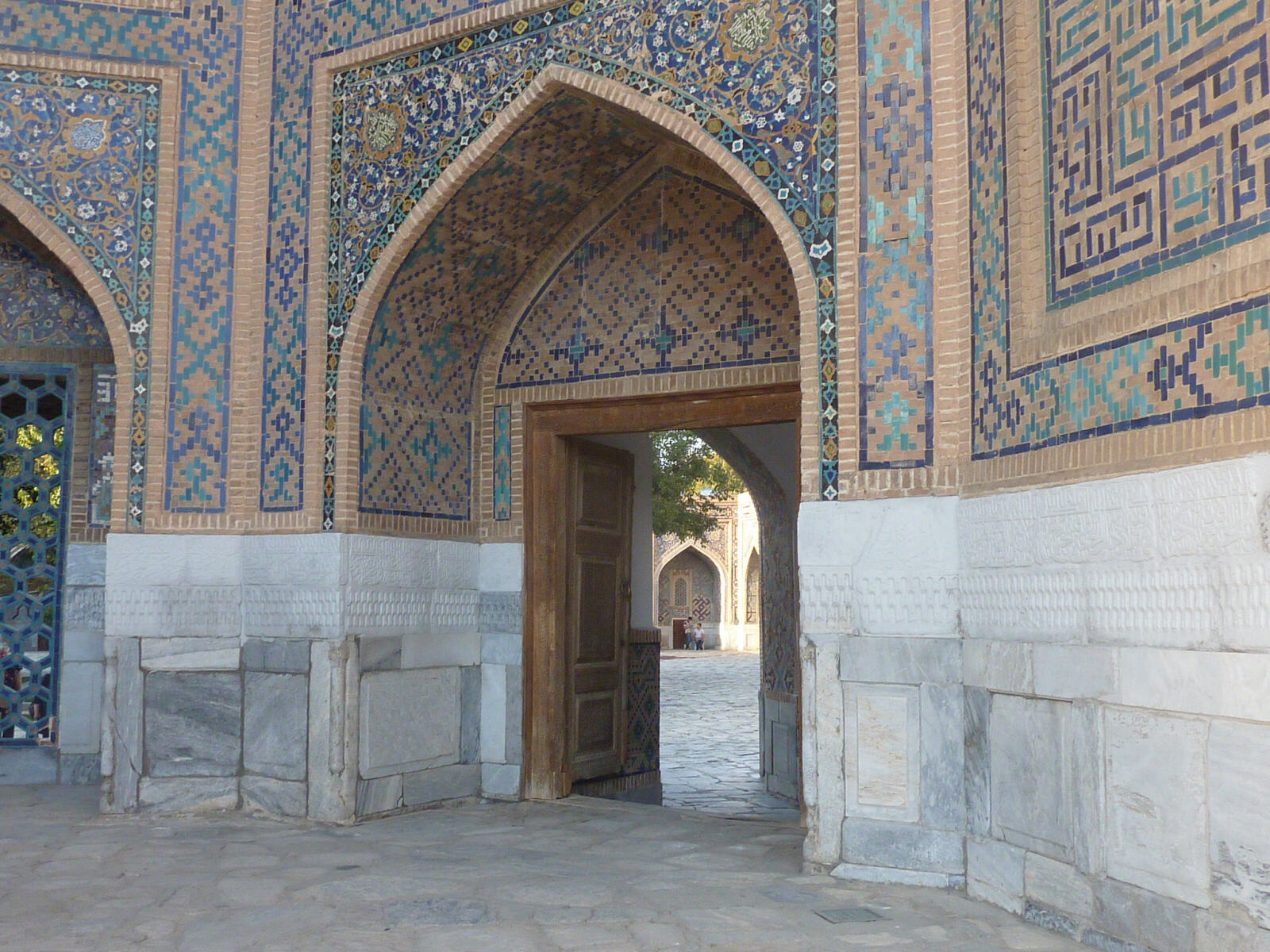
|
Most of the madrassas’ ‘study rooms’ are now shops and in one of them Sheila asked the lady there where she got her fingernails done – to cut a long story short she ended up with an appointment at 2:30 at a salon at the other end of town. By now we were pretty dehydrated from walking about all morning in the sunshine so we got the electric bus back to the bazaar and had refreshing lunch of soup and tea at the pleasant nearby Anorgis Art café. We went through the bazaar to the taxi stand and after getting out of the first taxi because the old crook tried to charge us far too much (we only got in because he had such an old heap and we felt sorry for him), got a yellow taxi to Salon Milano to get Sheila’s nails done. I tried to explain to the driver that we knew where it was and could direct him but he didn’t believe us and phoned the salon for directions. We still managed to get lost and drove round in circles asking directions until someone pointed it out – it was obvious but we’d missed it because the name was in Cyrillic not Latin letters. Apparently brides have gel nails for their wedding day (and there were certainly plenty of weddings when we were there). There were groups of bride, groom photographer and lighting men all over the place, having their photos taken in front of the monuments. The brides also have full professional make-up done for the day. The wedding dresses have lots of sequins, diamonds and long trains. Indeed while Sheila was waiting to have her nails done, a lady showed us the wedding gown showroom where there were 50 or so on show, some made in Uzbekistan and some in China (of course!). The average price was $300 (£186).
Sheila was very pleased with the job they made of her nails (gel instead of the usual acrylic) and then we walked back down Universitet Boulevard to an Internet café we’d spotted. This was not so successful though because the government block or slow down most internet traffic, and we couldn’t get through to our email system or phone home. We went to a nearby bus stop and met a lady we knew (we keep meeting people we know around the city!) who spoke good English and told us which bus to get on and how much to pay – the bus was very crowded because it was rush hour but we managed to squeeze on and at an intermediate stop Sheila even got the front seat – those elbows never let her down! We were able to use our morning tickets for another relaxed stroll round the Registan ensemble as the sun went down, making a wonderful backdrop for all the brides and wedding photographers who were doing their promenading. |
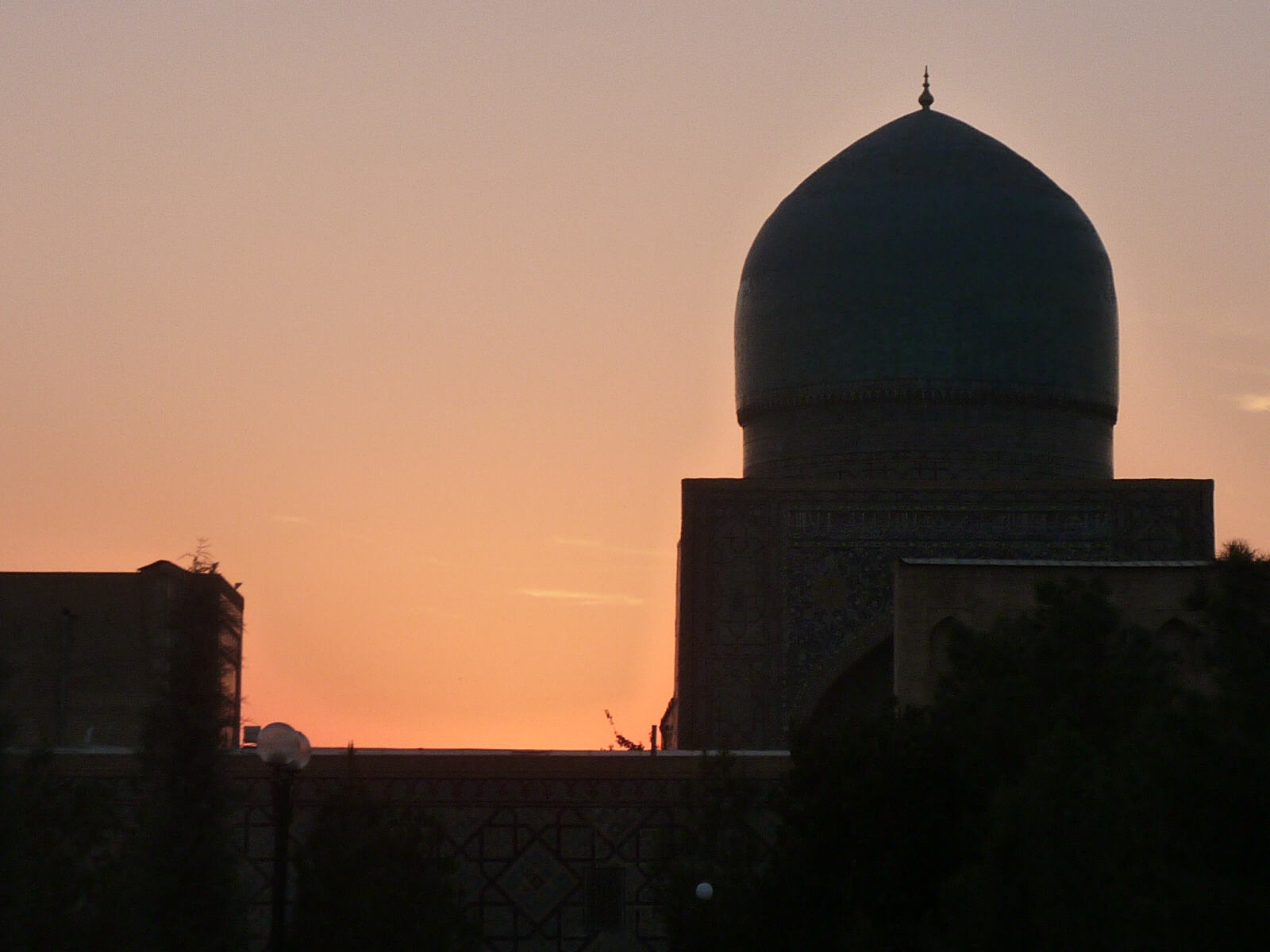
|
We then went and sat in the garden at the Asia Hotel again and had ‘champagne’ and Pringles for dinner as dusk turned to darkness. Back at the Caravan Serail Hotel, which had seemed almost deserted yesterday, it was really busy because a tour group had moved in. Earlier at the Asia the power had gone off but they and the Caravan Serail had generators, but about 8pm our generator stopped, so we went to bed by candlelight and had an early night.
Sat 18th. We’ve had clear skies and sunshine most of the time since we first arrived in Bukhara ten days ago, but suddenly this morning it clouded over and rain is forecast. Nevertheless we set out to go sightseeing and walked to the taxi stand by the bazaar to get a taxi up to Afrosiab, the site of ancient Samarkand on a hill overlooking the city. We didn’t go into the museum but walked out over the bare dusty hill, through abandoned archaeological digs and extensive modern graveyards. We could never quite get a clear view of the city through the trees that line the edge of the site, until after quite a long walk we came out through a cemetery entrance onto the road, just above the Hazrat-Hizr mosque, where we finally got a good view from the mosque’s terrace (although we had to pay a rather steep entrance fee to go into the mosque which was otherwise quite plain). We met an Australian couple there returning from the Mongolia car rally in a 1-litre (the maximum size allowed in the rally) Toyota Starlet car from England. They told us about everyone in Uzbekistan being forced to leave their normal jobs for a month every year to go and pick cotton because the farmers get a very poor price for their crop but get free labour to pick it. Round the corner and along another road is the entrance to another of the major sights of the city, Shahr-i-Zindah which means Tomb of the Living King. A gateway through the former ancient city wall leads to a very impressive avenue of blue-tiled mausoleums, many commemorating relatives of Timur (Tamurlane, the powerful despot who wreaked havoc in the area in the 1300s after Ghengis Khan had flattened it in the 1200s, then created the dazzling city of Samarkand as his capital). |
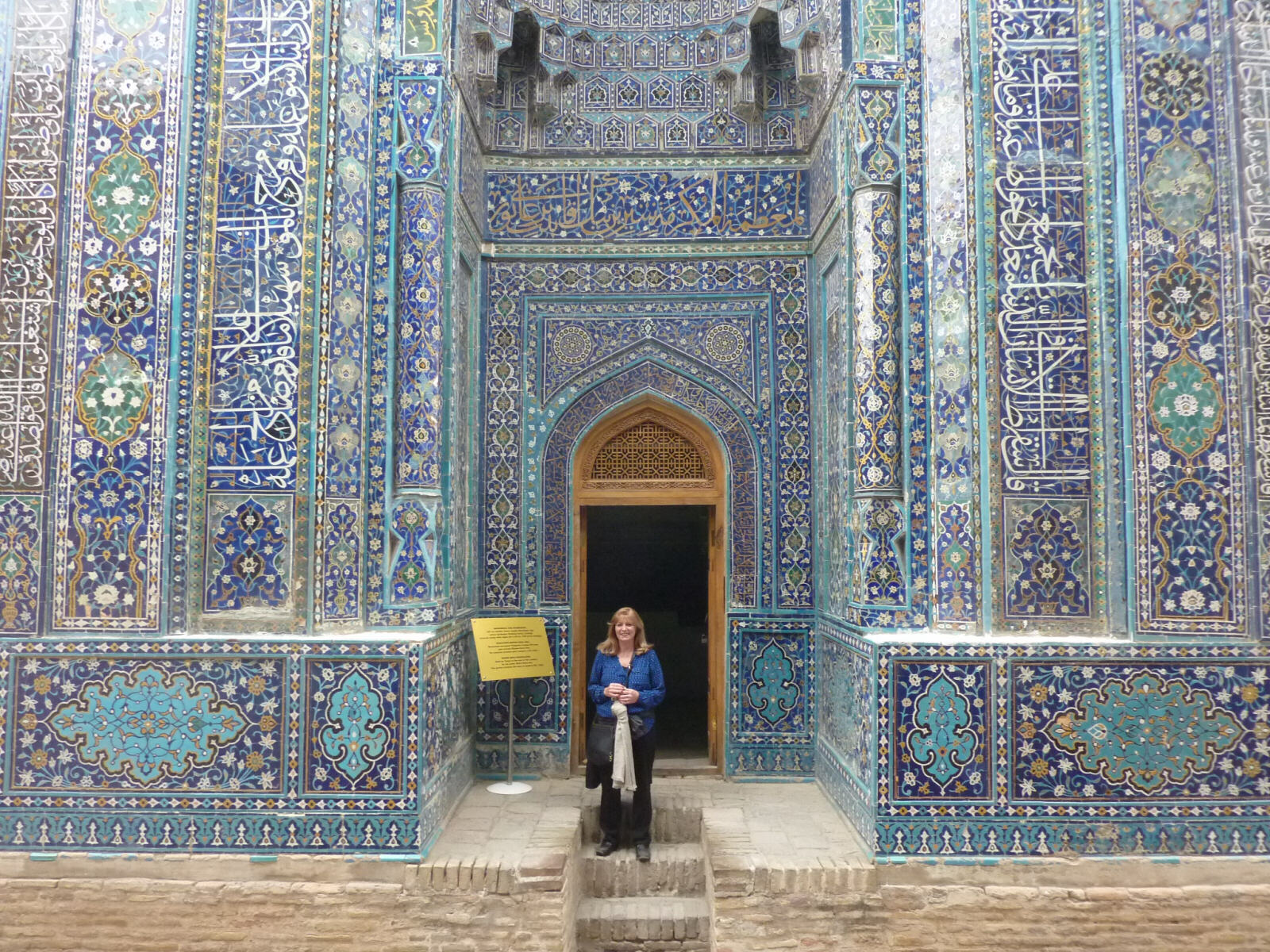
|
The oldest building at the centre of the complex is apparently the burial place of the Prophet Mohammed’s cousin. We walked back through the market buying cucumbers for a lunchtime snack to have with some soup at the hotel. A big rainstorm blew up so we sat that out then asked the nice man at the hotel reception to recommend a restaurant for tonight. He recommended the Restaurant Samarkand so we got a taxi through the new city to the restaurant and it was amazing; there was a huge ornate dining room full of local people including families and birthday and wedding groups, with live music and dancing in the space in the middle. We were glad to be in the main central area on the ground floor, but when a tour group arrived they were hustled upstairs to a private room away from all the action. Everyone was having a good time and one of the chaps came over and dragged us onto the dance floor; Sheila didn’t need much dragging of course, she was in there, arms raised twirling around like the locals – such fun! |
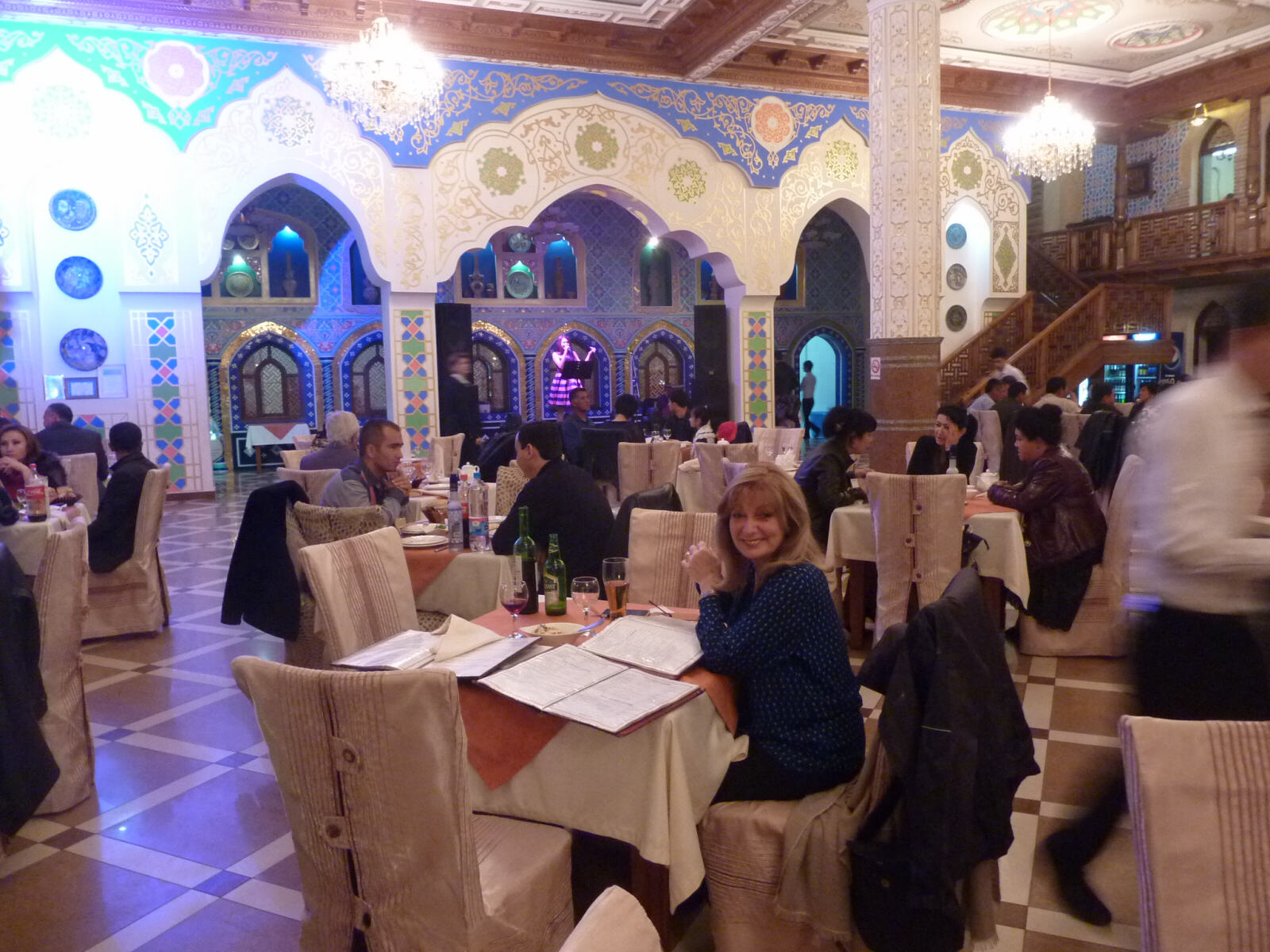
|
Sun 19th. We set off at 10am from Samarkand with a nice but rather slow taxi driver to go to the Tajikistan border. He hadn’t been there before so we stopped many, many times to ask directions and it seemed very complicated as we went through industrial back streets and across hydro-electric dams and we were running alongside the Tajik border and thought we were nearly there, but in fact we had to carry on for another hour or so until we got on a good straight road going north towards Tashkent, and suddenly about 2pm there was the Oybeck border post right beside the main road. It seemed very quiet and there were few foot passengers going through and the customs men were very friendly and helpful, so again apart from some form-filling it was very painless, but possibly less so for some local women who were crossing at the same time, who were taken individually into a large side room which had nothing but soap and a sink in it! |
Tajikistan
- Khojand (or Khujand)
|
Once again of course we arrived outside the border post at a group of rough-looking taxi drivers who exaggerated the distance (actually about 80km) from the border to Khojand and we negotiated down from $40 to $25 (£16) and we were on our way. The road was very good and we got quite excited when we went up a small hill, the first one we’ve seen for weeks. The scenery has been quite boring up to now apart from the odd camel a couple of weeks ago; fields of cotton in various stages of picking can have a soporific effect, indeed Sheila with her insistence on not sharing a taxi has spent quite a lot of time flat out fast asleep on the back seat. We stayed at the Hotel Khochand which was an old-fashioned Russian-style hotel with big suites with a hallway, sitting room, bedroom and bathroom, with high ceilings, thick heavy bedding, sturdy wooden doors and furniture, and rather suspect plumbing works in the bathroom, but the lady at reception was friendly and we liked it there. Almost nobody speaks any English here and there are no English menus in restaurants. We thought we were in trouble arriving on a Sunday night with no local money and no local language, but in fact just round the corner from the hotel we found two currency exchange booths offering reasonable rates and changed some dollars, then we found an ATM which accepted our card and gave us even more cash, apparently with no commission! The ATM also offered us the choice of local currency or dollars so we didn’t need to visit all those banks in Bukhara after all. Flushed with success we started having a look round and immediately found an Internet café – so many things that are almost impossible to find in Uzbekistan! We went into a nice-looking restaurant called the Café-bar Ravshan and here it was a bit tricky because the menu was only in Russian and nobody spoke English. Each section of the menu had one picture of an example dish (salad, soup, kebab, main course, etc.) which considerably restricted our choice (especially as some of the pictured dishes were not available) but we managed to have a nice meal and beers selected from the fridge.
Mon 20th. We walked down to the Syr Darya river (formerly the Jaxartes and the furthermost limit of the ancient Hellenistic world) and across the rather rickety bridge. There was no sign of the huge statue of Lenin that used to be on the other side and we learned later that it has been moved somewhere else, far away. |
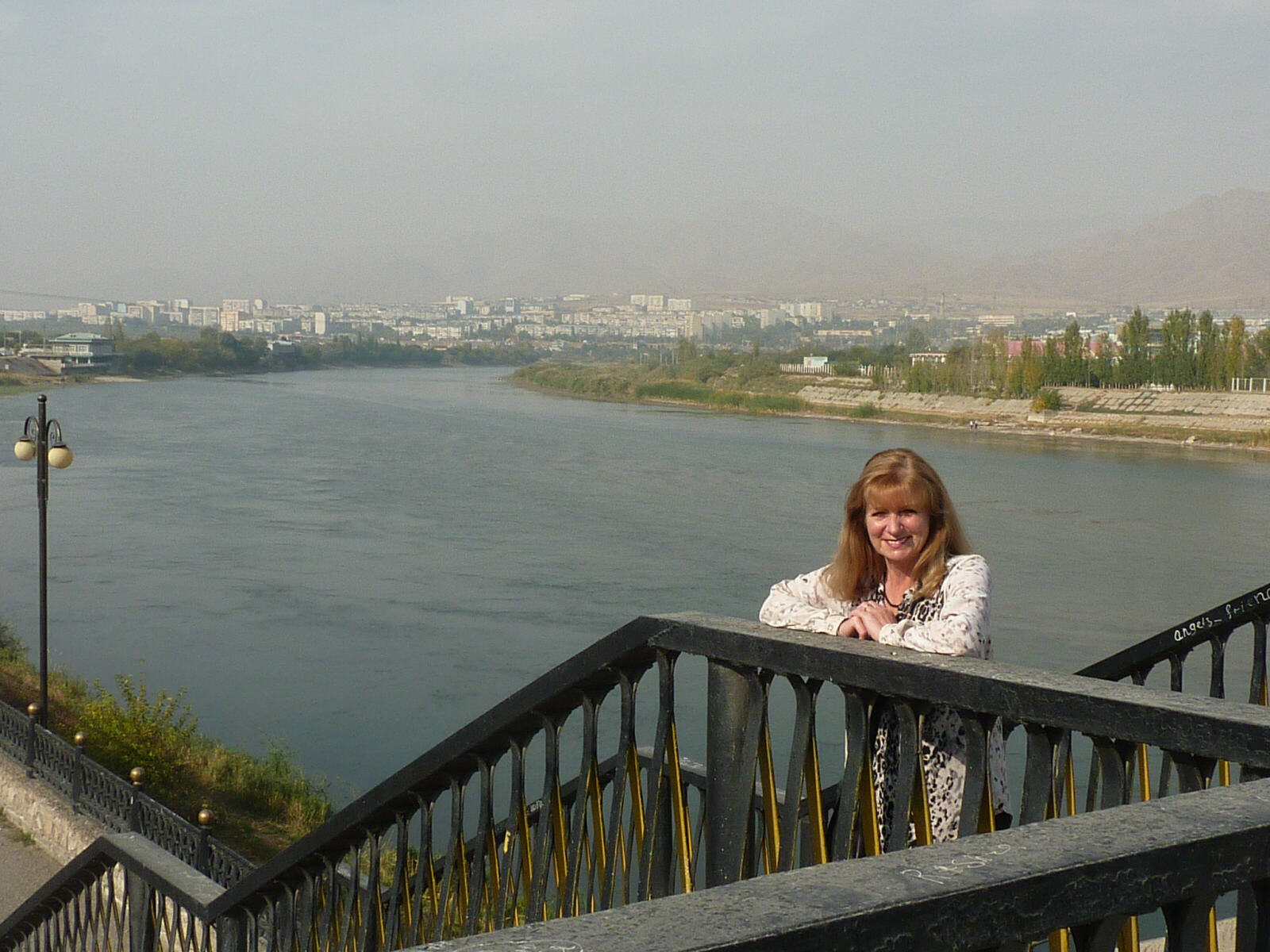
|
They make more of the riverfront here than the Amu Darya in Uzbekistan and there are some pleasant parks and restaurants alongside the water. We stopped at one which was just opening up and had thick, tasty soups and refreshing sliced melon for brunch. |
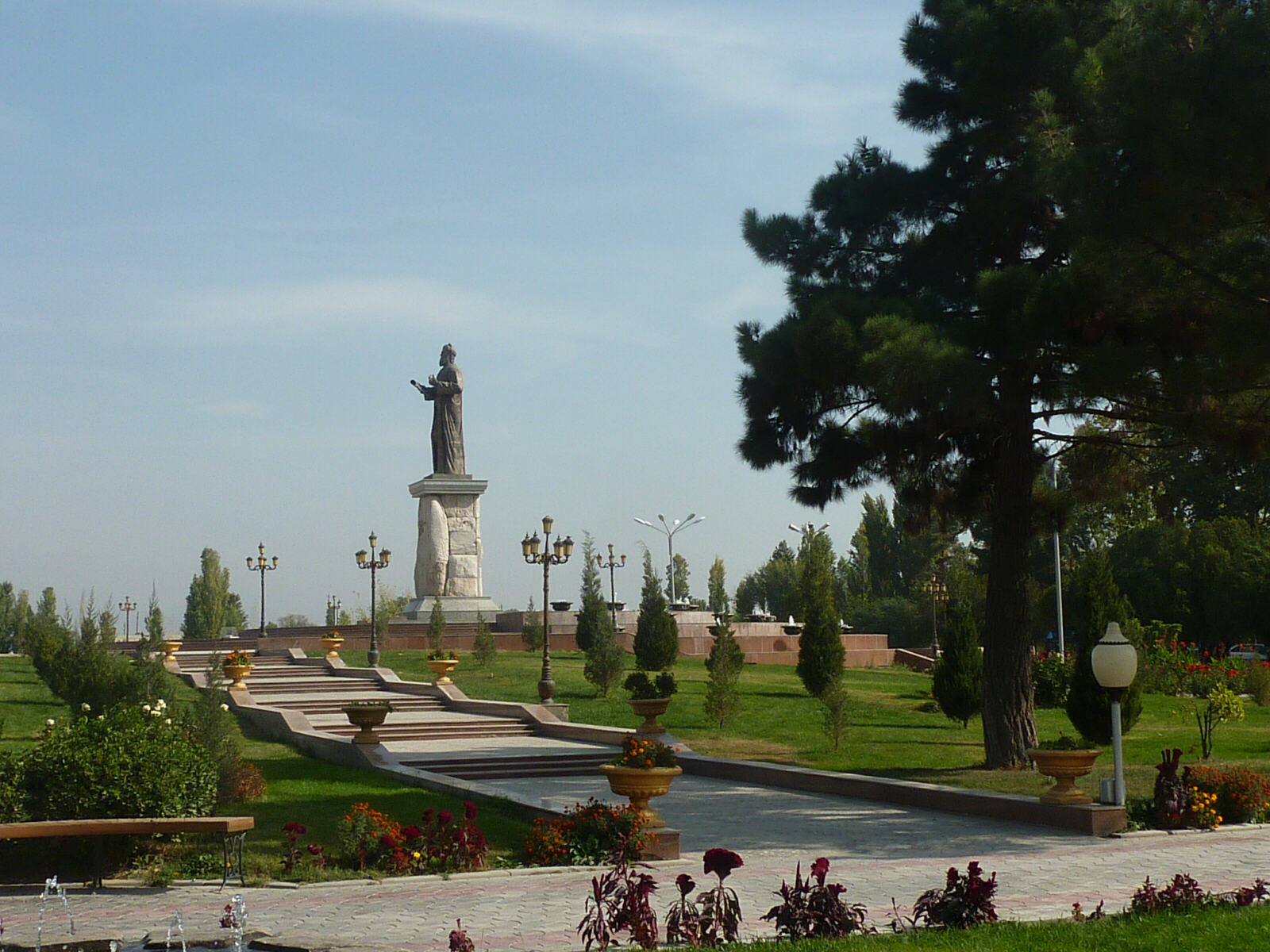
|
We spent the afternoon snoozing (Sheila) and catching up on Internet stuff (me) then went for a walk round in the evening, but ended up back at the Ravshan again for a very nice salad and kebab with Moldovan red wine and local beer. The Ravshan is definitely the ‘in’ place because the other restaurants we looked in were empty but the Ravshan was full of local people drinking large vodkas or tea and having kebabs.
Tues 21st. We walked down the main street to the bazaar, taking pictures of Sheikh Massad-ad-Din mosque, madrassa and mausoleum from the square outside. The central part of the bazaar was in a big purpose-built hall, but the more interesting part sprawled around the outside of it, where friendly gold-toothed traders with huge piles of onions or carrots posed to have their picture taken. |
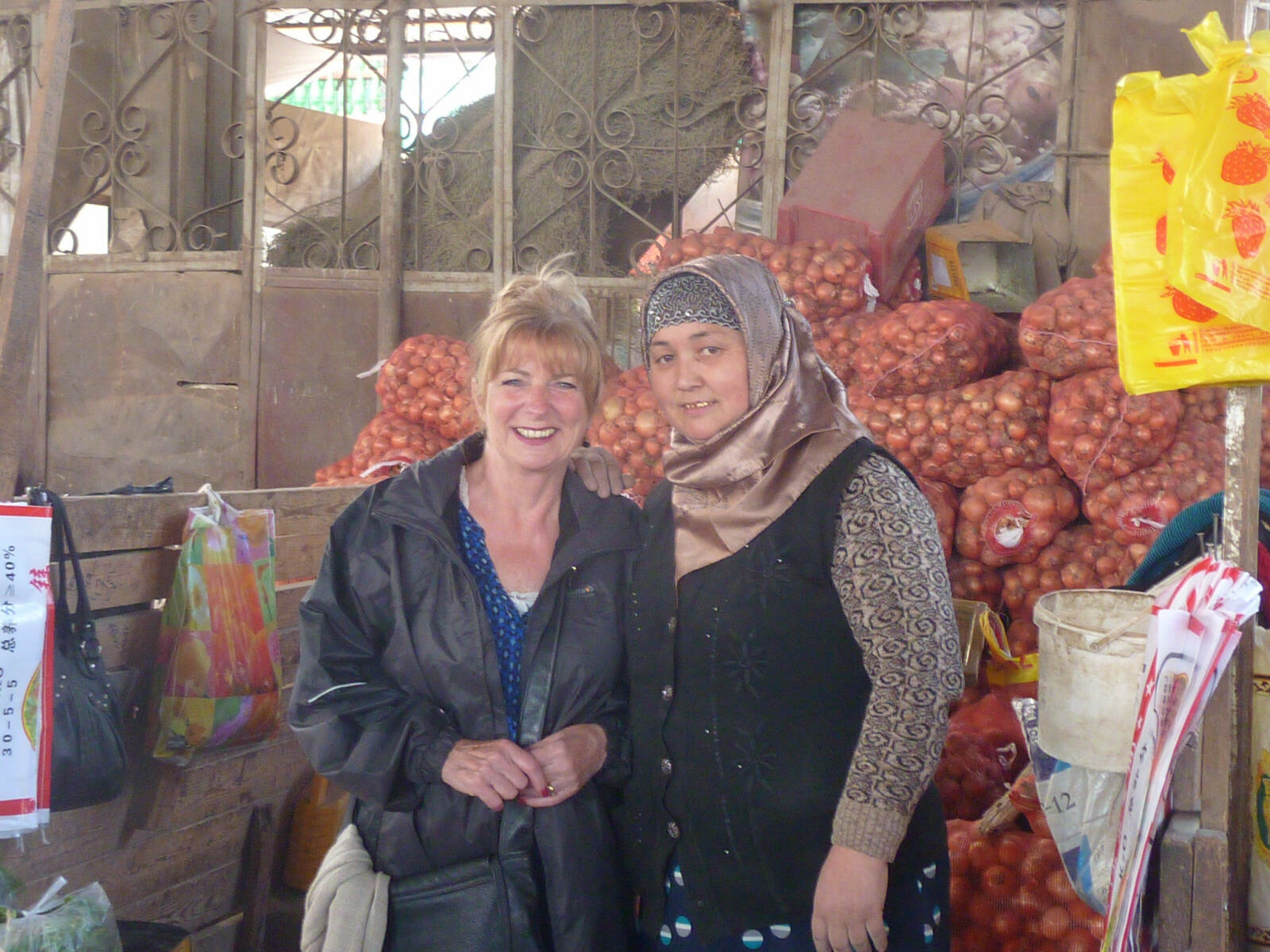
|
Then we walked all the way back down to the river and had more thick, tasty soup and melon for lunch. On the way back to the hotel we went into the museum in the restored eastern gate of the citadel, but it is no longer possible to climb up onto the ramparts to take photos of the town. |
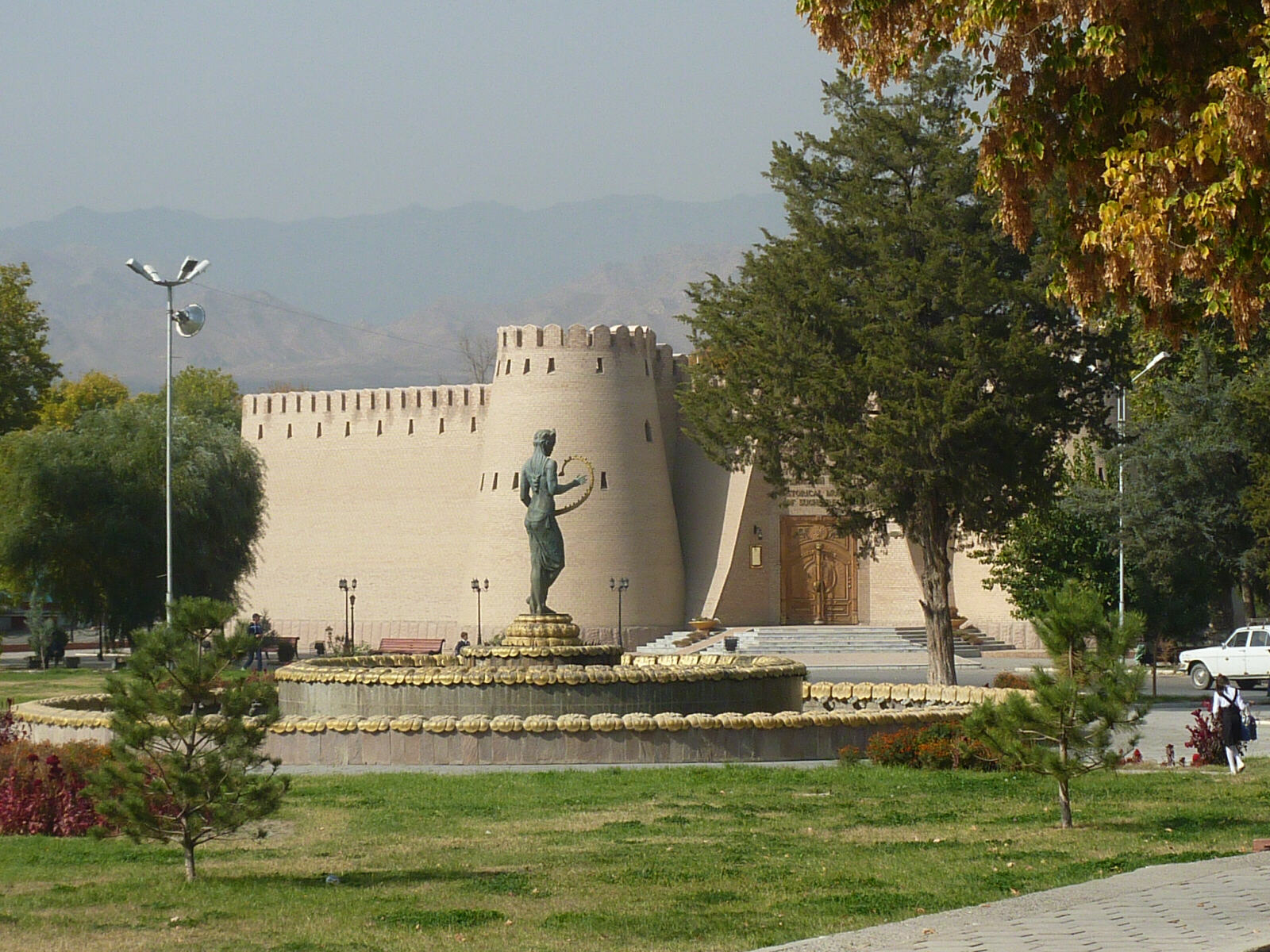
|
The rest of the day was basically about eating and drinking – I had a coffee and cake in a café off the main street and in the evening we went back to the Ravshan for another lovely meal of kebab, sausages, chips, beer and Moldovan wine.
Weds 22nd. We went down to the corner of the street and negotiated with a taxi driver there for the one-hour ride to the Uzbek border at Kanibadam. He was a cheerful old chap who at first didn’t speak any English and he chatted away incomprehensibly for a while, before apparently remembering some schoolboy English from long ago and exclaimed: ‘Little grey mouse, where is your house’! He could also count from one to ten but not necessarily in the right order! During the ride we got excited again when we started seeing mountains and lakes, after three weeks of flat desert and cotton fields. We had agreed a price of 100 Somali ($20/£12.50) but he started pointing out the distance we had travelled and explained (I gathered eventually) that the proper price is one Somali per km. In the end the journey was 125km and a $20 note and my remaining local change just about covered it and we parted the best of friends. Again the border was very quiet and the formalities painless and we crossed back into Uzbekistan with no trouble, even the two border posts were adjacent and there was no long walk in between. |
Uzbekistan again
- Kokand
|
However, once outside the border we ran into an unexpected problem because there were no taxis or any vehicles at all waiting, just a straight empty road stretching into the distance. We walked a km or two and came to a little village with a cluster of men talking so we asked about a taxi to Kokand, about 50km away. They had no idea of the value of dollars and started quoting ridiculous amounts, scratching $100 (equivalent of £62) in chalk on the road surface, but we had some Uzbek Som left over from before (it’s not clear whether it’s legal to export and re-import them but nobody asked) so when we started quoting prices in Som it got more realistic. Eventually a man agreed to take us in his car and we set off, but it was a petrol car and all the garages were closed (no petrol in Uzbekistan) and he was running out, so in the end he handed us over to a marshrutnoe driver (marshrutnoes are tiny seven-seater minibuses that shuttle back and forth along semi-fixed routes). The two of them split the money rather unevenly in favour of the first chap and we continued on our way. The driver took us to the Hotel Kokand which is very central and we got a fair-sized room with a huge settee round a coffee table for $50 (£31). We walked down the road, stopping for a shawarma and coffee at a fast-food restaurant because it was 2pm and we hadn’t had any breakfast or lunch. Then we went to the main tourist sight in town, the Khan’s Palace, set around two courtyards with several rooms housing a museum. |
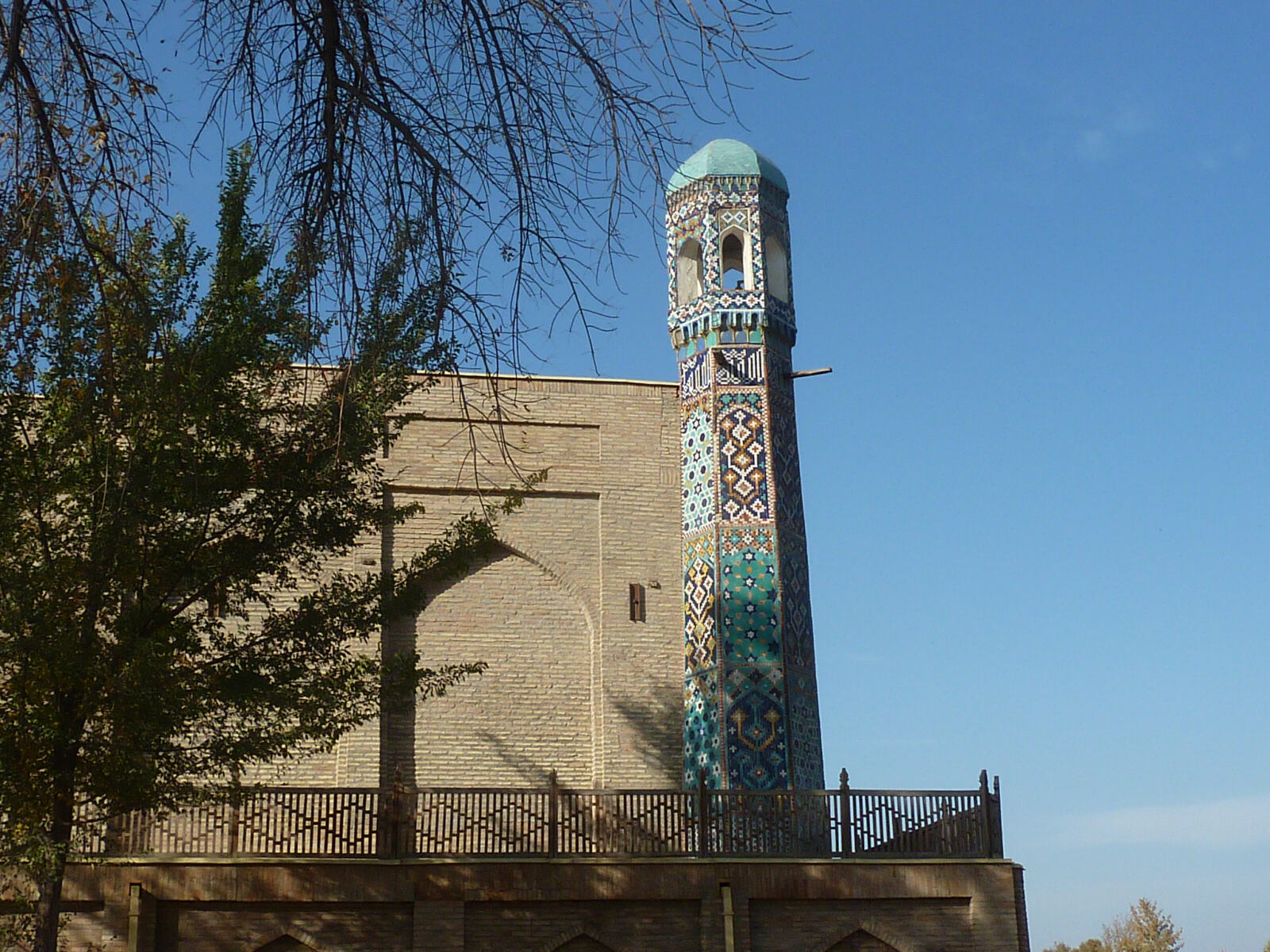
|
Then we walked back through the park and down the main shopping street. There’s nothing specifically wrong with Kokand but we didn’t take to it like we did to Khojand. We went to the café next door to the hotel for dinner and had a super meal of thick sausage soup and huge pepperoni pizza, with TWO bottles of Uzbek champagne!
Thurs 23rd. UK passport-holders don’t need a visa for Kyrgyzstan but we were worried about turning up at the border without one in case the Uzbeks didn’t know that and sent us away. So we had printed out the Kyrgyz embassy web page and now enquired about getting it translated into Russian. The people at hotel Kokand said a notary would do it and came out to a yellow city taxi in front of the hotel to explain to him where to take us. We got to the notary but nobody there spoke English, but one of the people phoned his brother who spoke excellent English and said he could come to help. When he arrived he was a young chap with a cheeky grin and a sense of humour. He was actually nothing to do with the notaries, but he used their computer to find the Kyrgyz web site in Russian and printed it out for us, and none of them would accept any money for doing it. We expected the taxi driver who was waiting for us to take us to the taxi station where we’d get a taxi to Andijan at the other end of the valley, where we’d have to get another taxi to the Kyrgyz border near Osh. However, while all the notary stuff was going on, Sheila went and agreed with Adil, our yellow-cab driver, that he would take us all the way to the border for the equivalent of less than $40/£25. As soon as we had the Kyrgyz information in our hands we set off and had a smooth, quick four-hour ride to the border while Adil practiced his quite good English on us, and the journey was only interrupted by yet another police radar trap. Adil said ruefully that he was doing 83 km/hour in a 50 limit. When we got to the border we gave him all our remaining Uzbek change to help out with the speeding fine. |
Kyrgyzstan
- Osh
|
The border crossing was even simpler than all the others and nobody mentioned the visa, so all the notary work was unnecessary. All the Kyrgyz border guards said "welcome to Kyrgyzstan" and were very friendly. We did have a bit of negotiation with the group of taxi drivers outside the border post (same the world over) but even that was more reasonable than normal. However, the hotel we asked to go to was full so the driver took us to his choice, the Tes Guest House, which was lovely – clean, pine-furnished rooms set around a garden and a friendly, helpful, English-speaking lady in charge. We settled in, did some laundry in their laundry room, then went for a walk round the town as dusk fell and stocked up on local money from the plentiful ATM machines. We returned to the first restaurant we saw, the Bridge Bar not far from the hotel, and although most of the items on the extensive menu were not available we had an excellent dinner of steak and fajitas (but without the tortillas, sour cream and guacamole) with big glasses of local lager beer.
Fri 24th. We had a very nice breakfast at Tes Guest House then went sightseeing in Osh. We walked all the way down the main street to the large bazaar which sprawls alongside the river. |
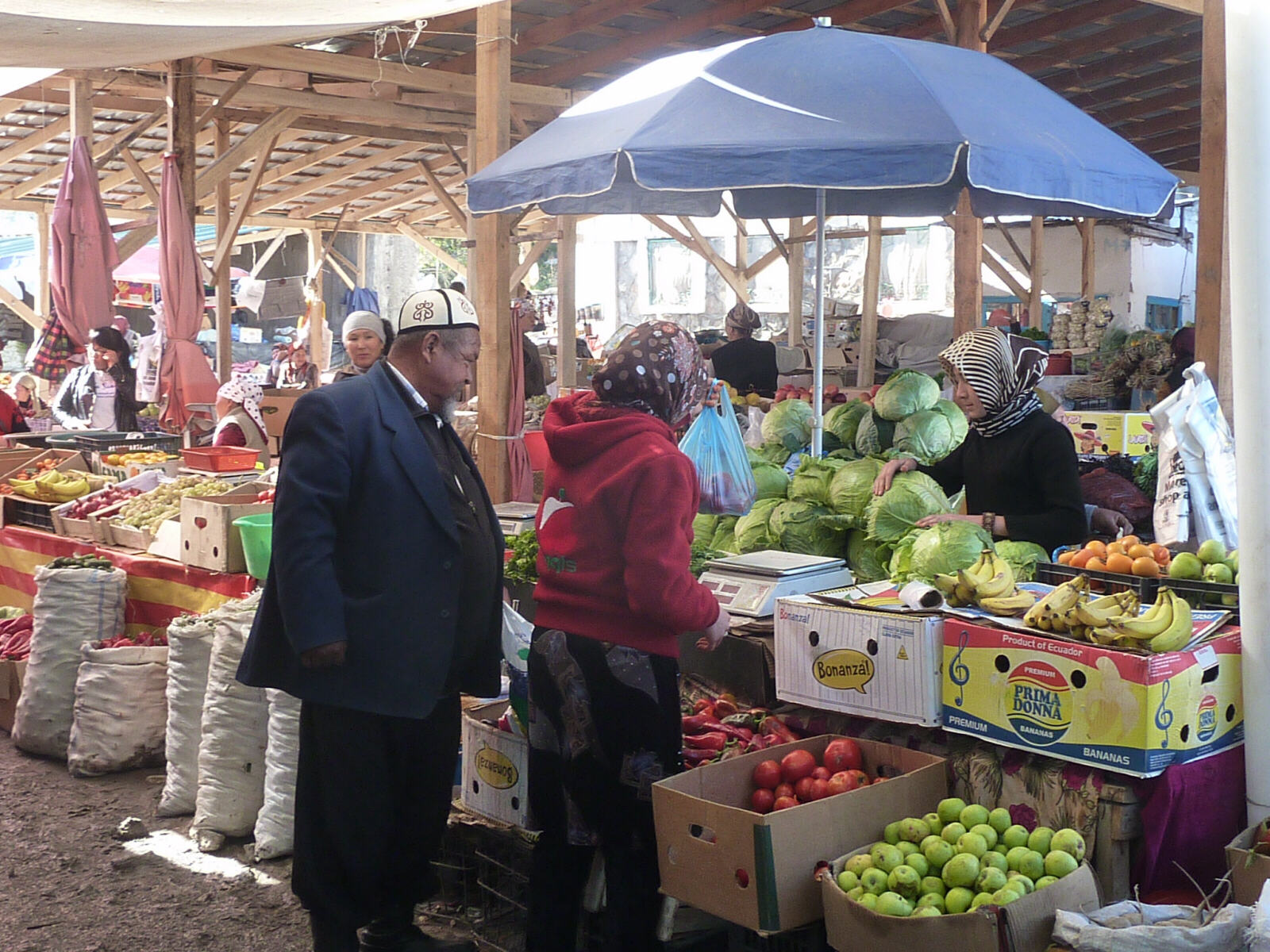
|
The main interest was all the fascinating people in fancy hats buying and selling things, rather than the goods on display .... |
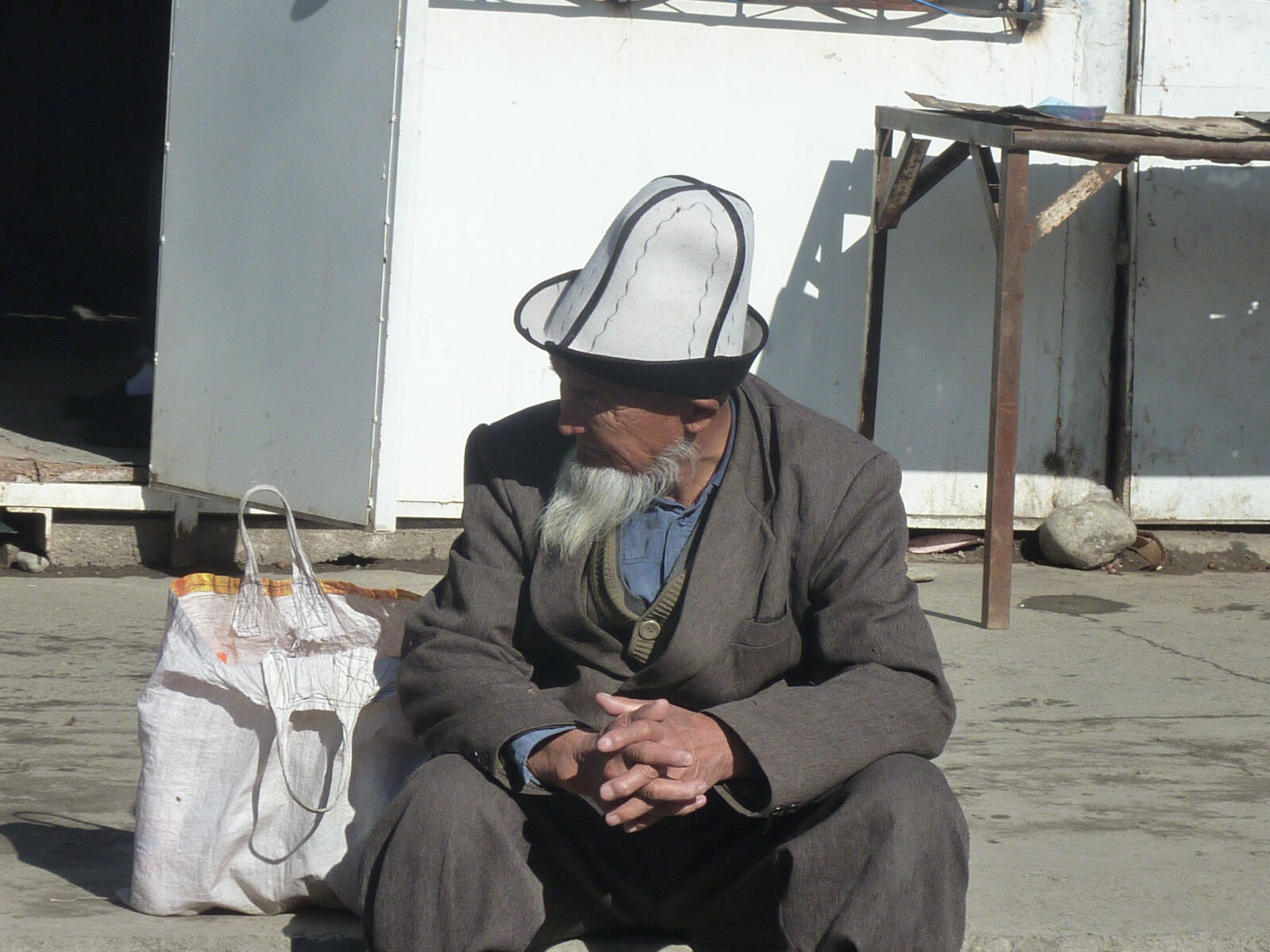
|
.... although the stalls of cows’ tongues and feet caused us to pause a moment. |
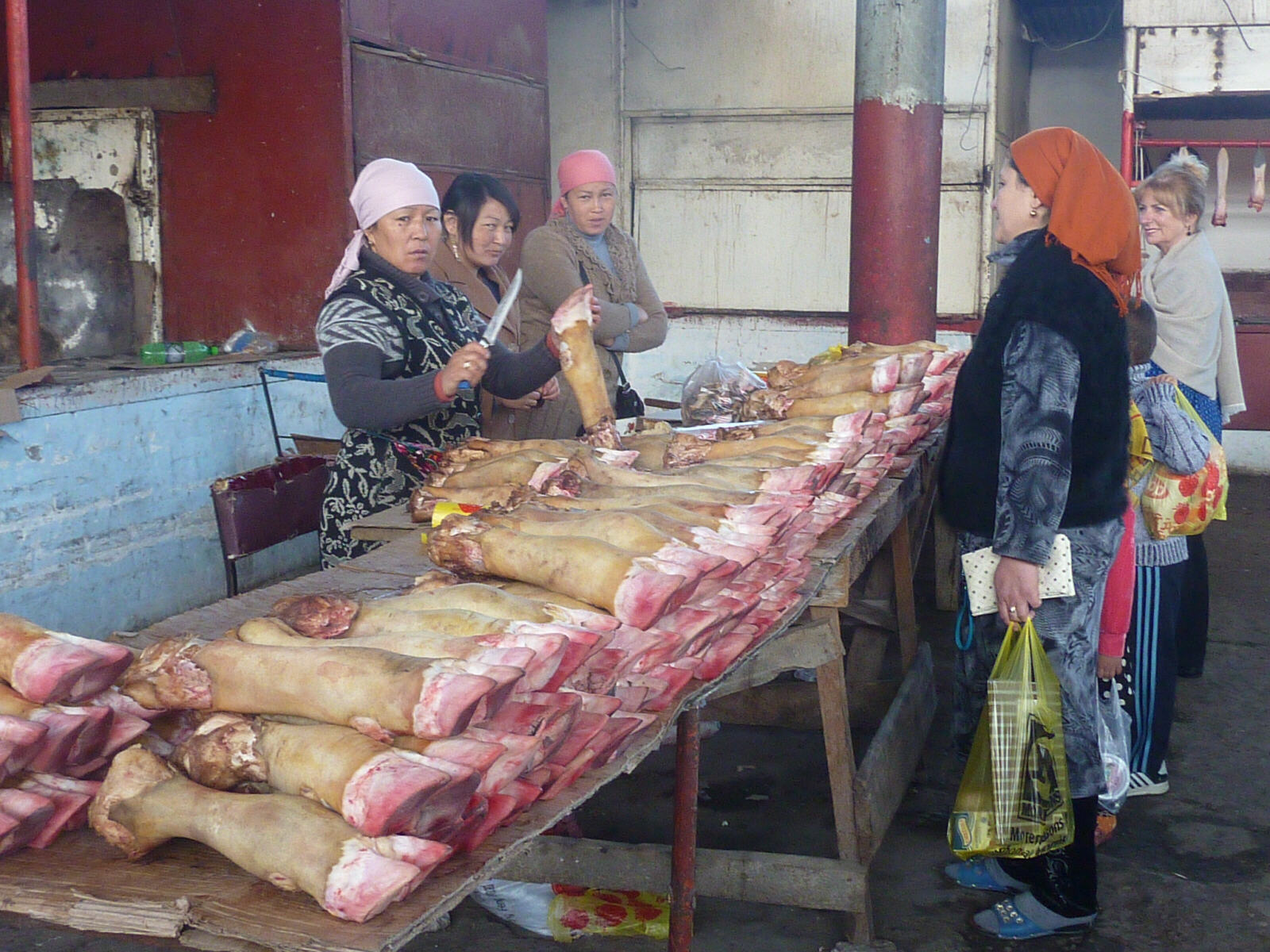
|
Then we walked back up the other main street to the square where there was a huge three-story yurt (nomad’s tent) set up as a museum. |
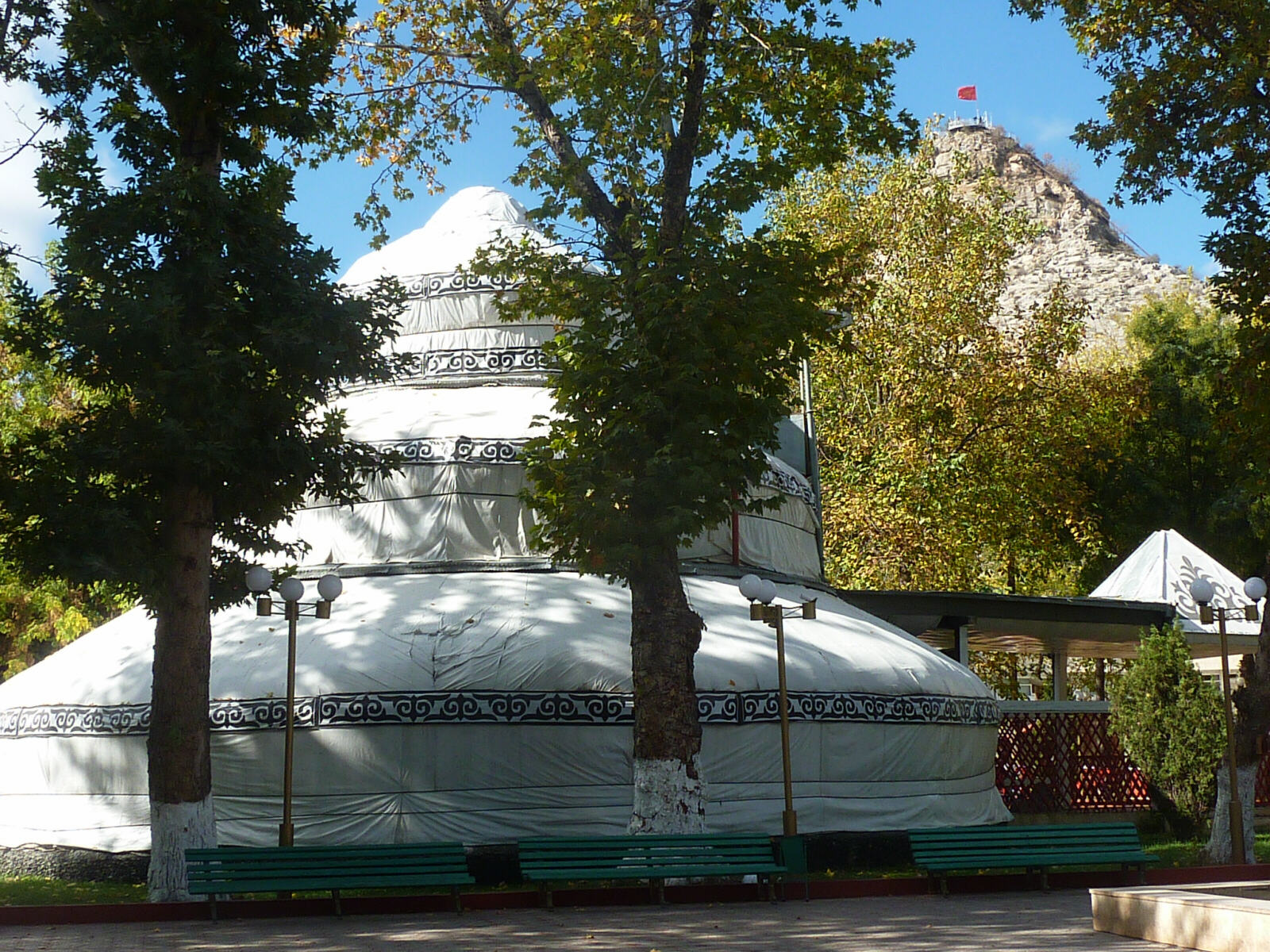
|
On the way back to the hotel we stopped at a fast-food restaurant for a tasty shawarma. As we left the hotel in the evening an event seemed to be in progress at the nearby stadium, with live singers and crowds of young people cheering – we found out later it was the 75th anniversary celebration for the founding of Osh University. Everyone going in had a ticket but we hovered around the gate for a while until one of the officials said ‘go on, you can go in’ (or something like that in Kyrgyz). We listened to a few of the singers, who were obviously well-known to the audience, then as it got colder we left and went for another wonderful meal at the Bridge Pub, accompanied by local beer and Russian red wine this time. When we returned the concert seemed to be nearing its climax so we went in and sat with the crowd for the last couple of songs and the firework show finale. |
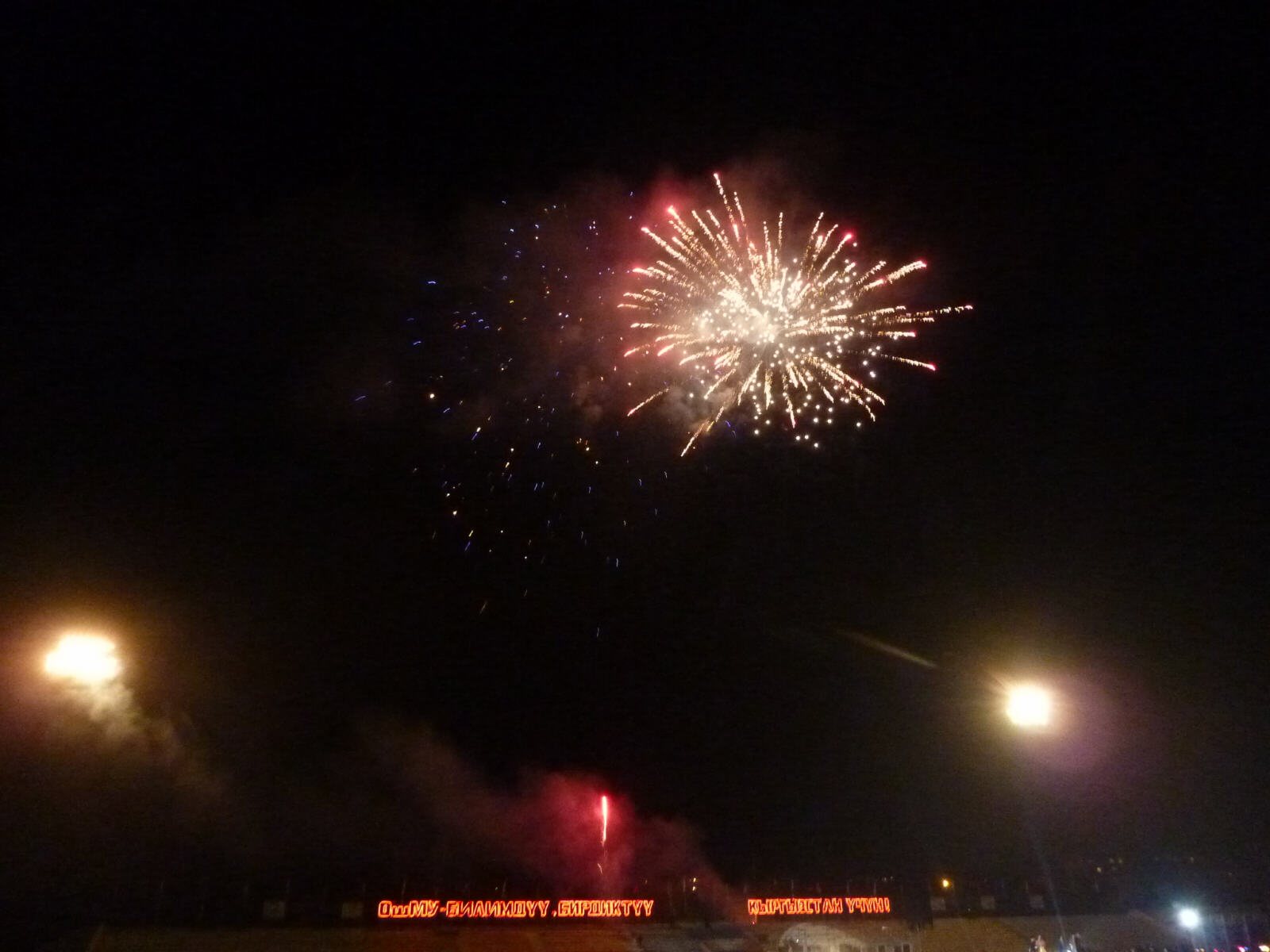
|
Sat 25th. We set off at 8am for the long drive across the mountains to Bishkek. There were hills and valleys with agricultural towns with markets that spilled over the street, then mountains with canyons and lakes and spectacular multi-coloured rocks. |
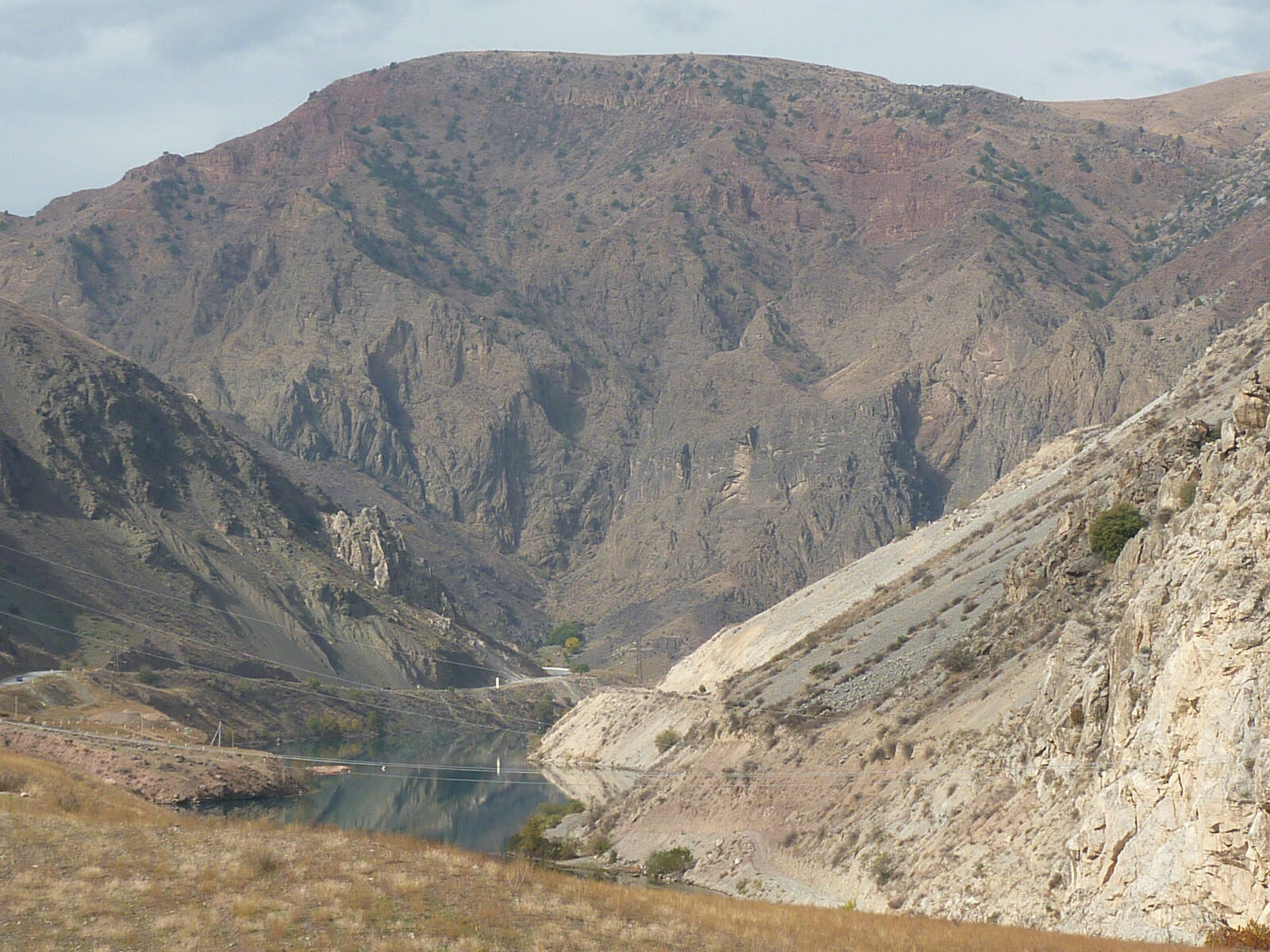
|
We went through a wide central valley for an hour or so then up to the high mountain passes through the snow. Unfortunately Sheila didn’t see any of it because the back windows were heavily tinted (in fact blacked out) and she didn’t want to sit in the front because of the terrible driving. |
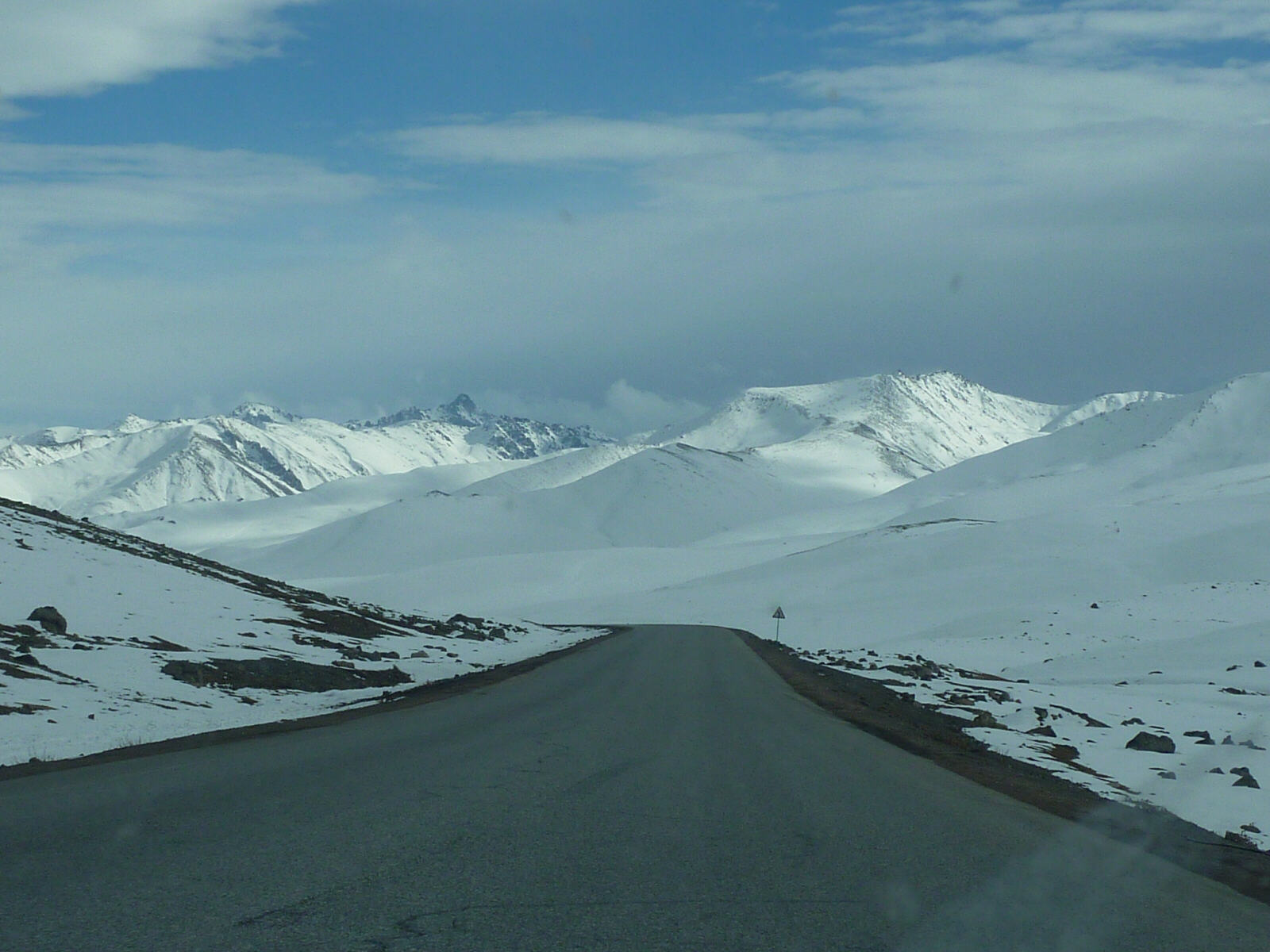
|
We were ahead of schedule at this point because we were worried about snow blocking the mountain roads; it was a sunny day and our fears seemed groundless, but a couple of days later we were proved right. |
Kyrgyzstan
- Bishkek
|
We eventually got to Bishkek just before 6pm and somehow the driver found our Shah Palace hotel down a little side street. We went to the main street and walked around looking for somewhere for dinner and settled on a nice Italian coffee bar where we had beers and pastas.
Sun 26th. We moved from the Shah Palace to the Futuro Hotel which we’d booked previously. The Futuro is a little way outside the town but otherwise is a really nice hotel, very clean and modern and they run a shuttle service to town to overcome the location problem. There were literally hundreds of free movies on the in-house TV so Sheila spent the rest of the day in heaven, in bed, eating chocolate and watching films of her choice. I got the shuttle into town and walked around taking photos of the Soviet-style squares and checking out restaurants for tonight, then came back to the hotel down Chui Avenue, the main road, on trolleybus no. 9 for less than 10 pence. |
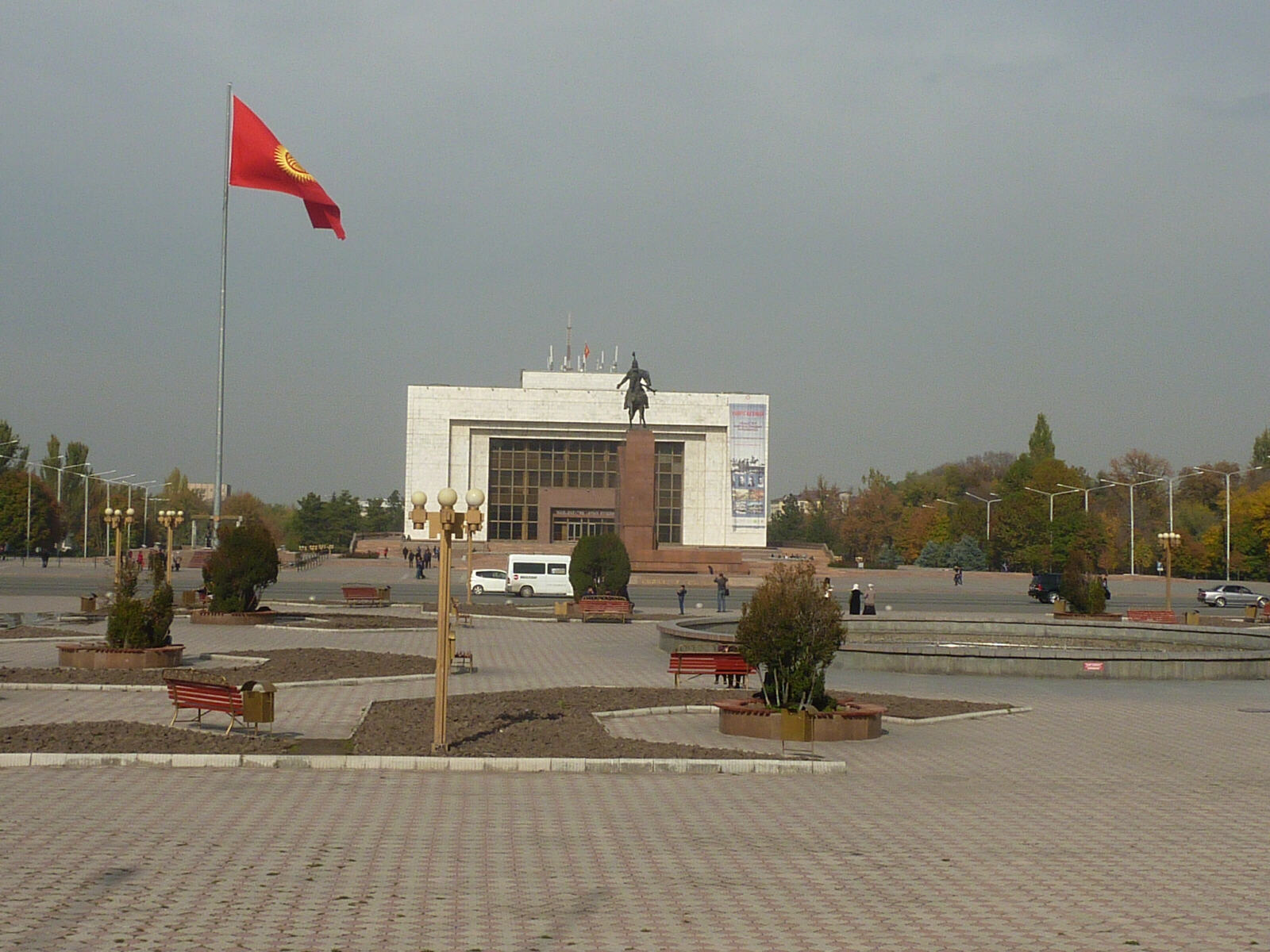
|
In the evening we went back to my choice from my survey of restaurants in the town, ‘Fat Boy’s’ Italian restaurant, where we had a really excellent meal of thick soup and extremely tasty duck risotto and smoked fish carbonara, accompanied by local beer, then French red wine, then Kyrgyz champagne. The chef came out with each course to ask if we were enjoying it, before going for a cigar outside. It was clear and dry when we arrived at the restaurant but then a violent wind and rainstorm blew up and soaked the road outside and everyone in it, then stopped by the time we left.
Mon 27th. Yesterday it was warm and sunny walking around the town before the rain blew up, but the weather hadn’t finished playing games with us. We had a shock when we opened the curtains in the morning and saw that several inches of snow had fallen overnight! We lingered over the excellent buffet breakfast at the Futuro; Sheila wondering if, after a plateful of salamis and cheeses followed by fried eggs on toast, would putting condensed milk on her toast with bilberry jam be too decadent? She wisely decided it would be. We huddled in the hotel watching TV most of the day and went for a German dinner of black beer and sausages at Steinbrau micro-brewery in the evening.
Tues 28th. It was still below freezing outside and Sheila was happy to have another day watching TV but I was getting stir-crazy so I walked into town, stopping at Adriano’s for a coffee to warm up when I got there. I walked through the parks and tree-lined avenues admiring the ‘winter wonderland’ effect of the snow clinging to every branch and surface. |
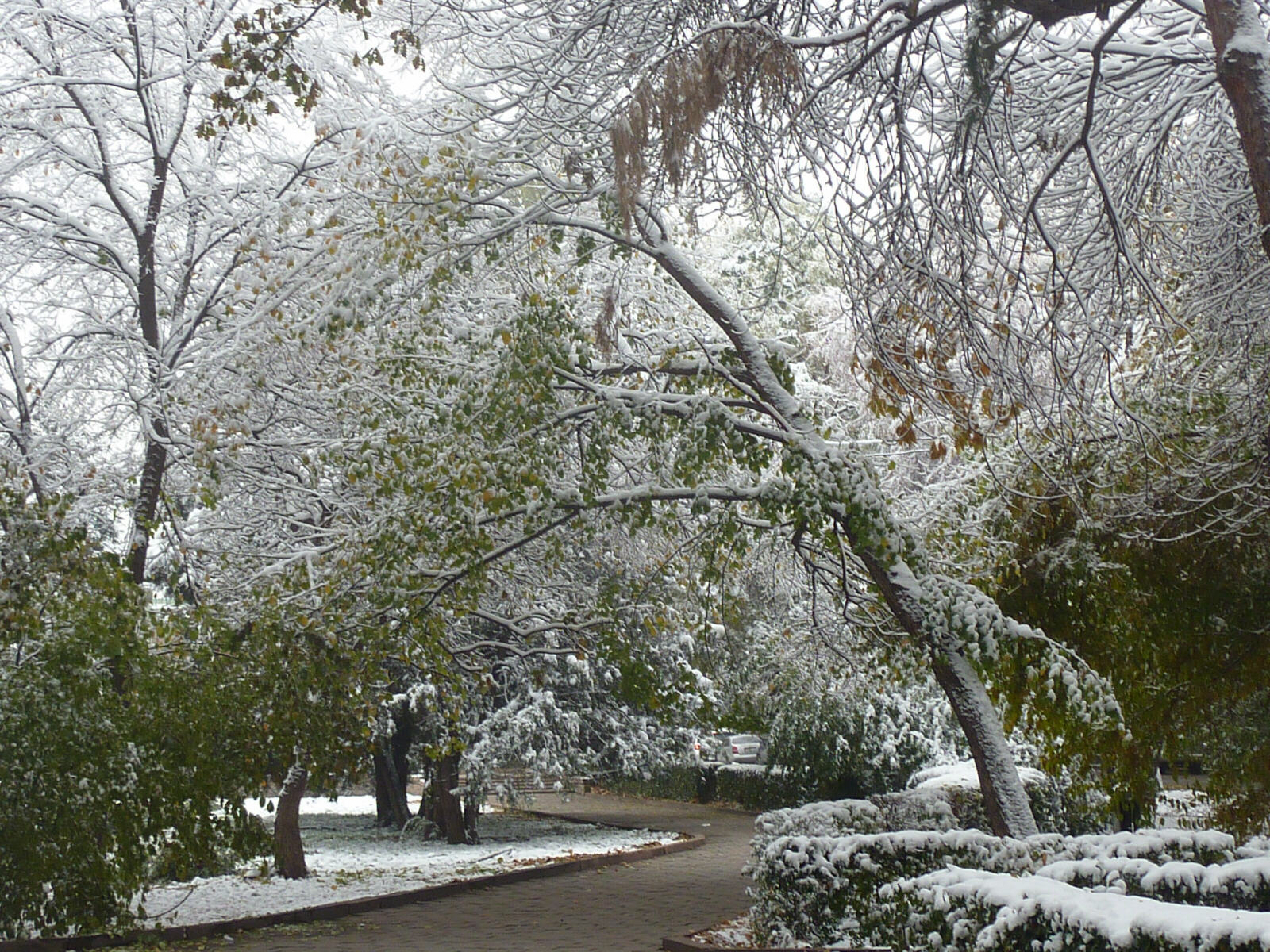
|
On the other side of town I had another coffee to warm up again at Bar Navigator, then a look at the railway station where two trains all the way to Moscow were advertised, before walking back to the main road and getting trolleybus no. 8 back to the hotel. |
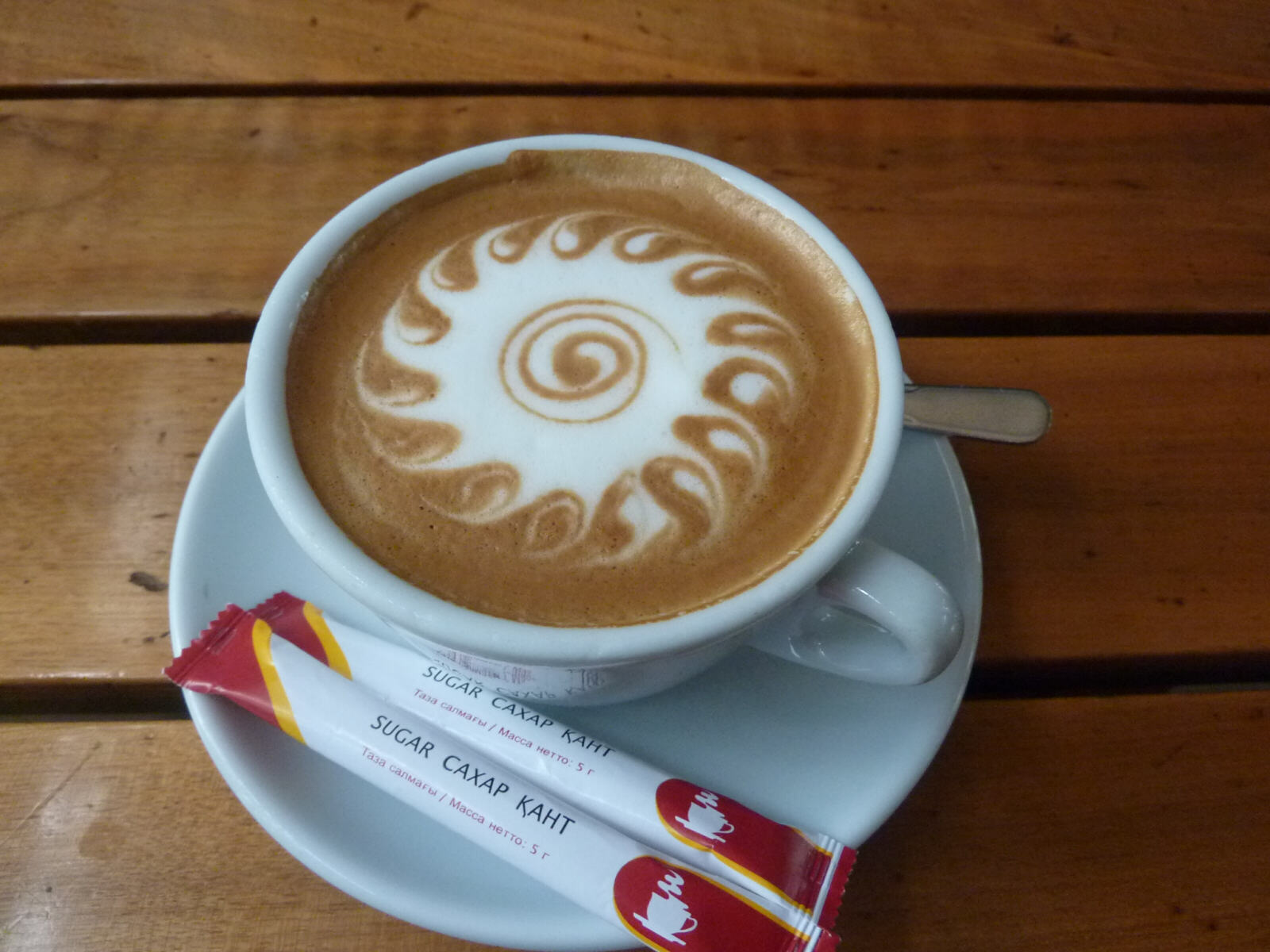
|
In the evening we went back to the Navigator for a delicious meal of soups and fillet mignon with potatoes and mushrooms, accompanied by Efes beer and French wine.
Weds 29th. Our driver who is going to drive us to Almaty in Kazakhstan said we should start early because the border gets really busy. We left at 8:30 and sure enough when we got there about 9am it was quite busy already, with a queue of cars going through and lots of foot passengers, unlike all our previous border crossings which have been almost deserted. The driver said he’d wait for us at the other side as we had to walk through, but in fact everyone pushed us to the front of the queue, customs waved us through without a search, and we had to wait about half an hour for the driver and car to catch up with us! |
Kazakhstan
- Almaty
|
We drove another three hours or so to Almaty (pronounced Almater) and the driver found our hotel, the D’Rami, which was quite an achievement because it is on the third floor of an apartment block in the middle of the city. It’s a lovely hotel, recently decorated by professional designers and in a great location in the city centre for restaurants and shopping. We had a walk round looking at restaurants and shops and were shocked by the prices of everything – Almaty is the commercial centre of Central Asia’s richest country and the prices are similar to London or Paris rather than the other much cheaper places on the journey. The weather was still freezing with a layer of snow on everything, so we stopped for lunch and a warm-up at a lovely French-style salon de thé called Aroma. |
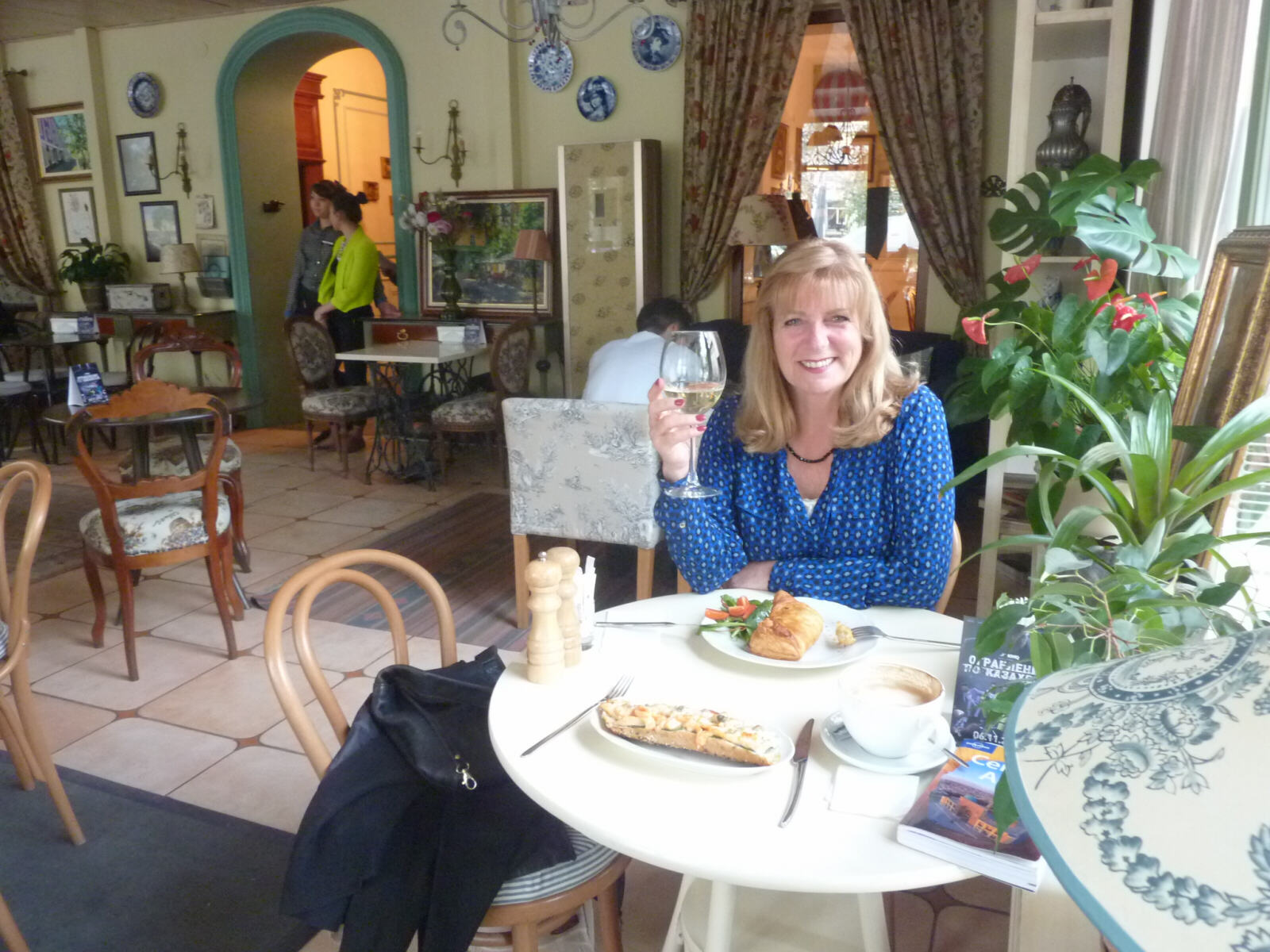
|
In the evening we had dinner at an Italian-style restaurant called Del Papa – all excellent but scary prices (for example a 40-pence bowl of soup in Uzbekistan would be £4 in Almaty). |
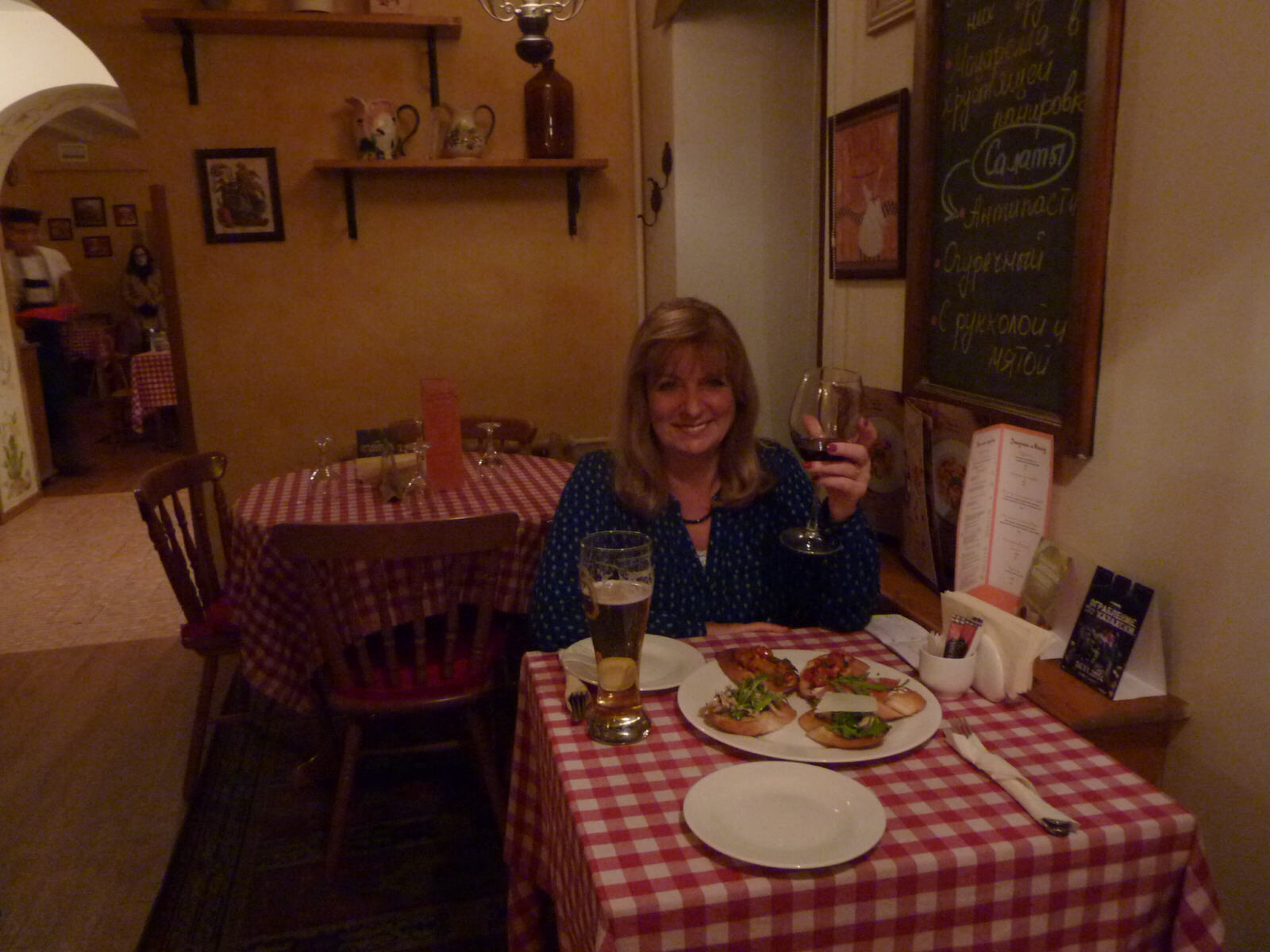
|
Thurs 30th. It was still freezing and the snowy trees were still a winter wonderland but we went out to walk round Almaty. We went to find a fur shop Sheila had heard of but it had disappeared (luckily), so we had a nice English breakfast at Travellers Café. We continued walking and checking out Almaty’s chic cafés and trendy restaurants (taking the opportunity to get warm in each one). We went to Panfilov Park to see the lovely wooden Zenkov Cathedral, about the only building still standing from before the 1911 earthquake. |
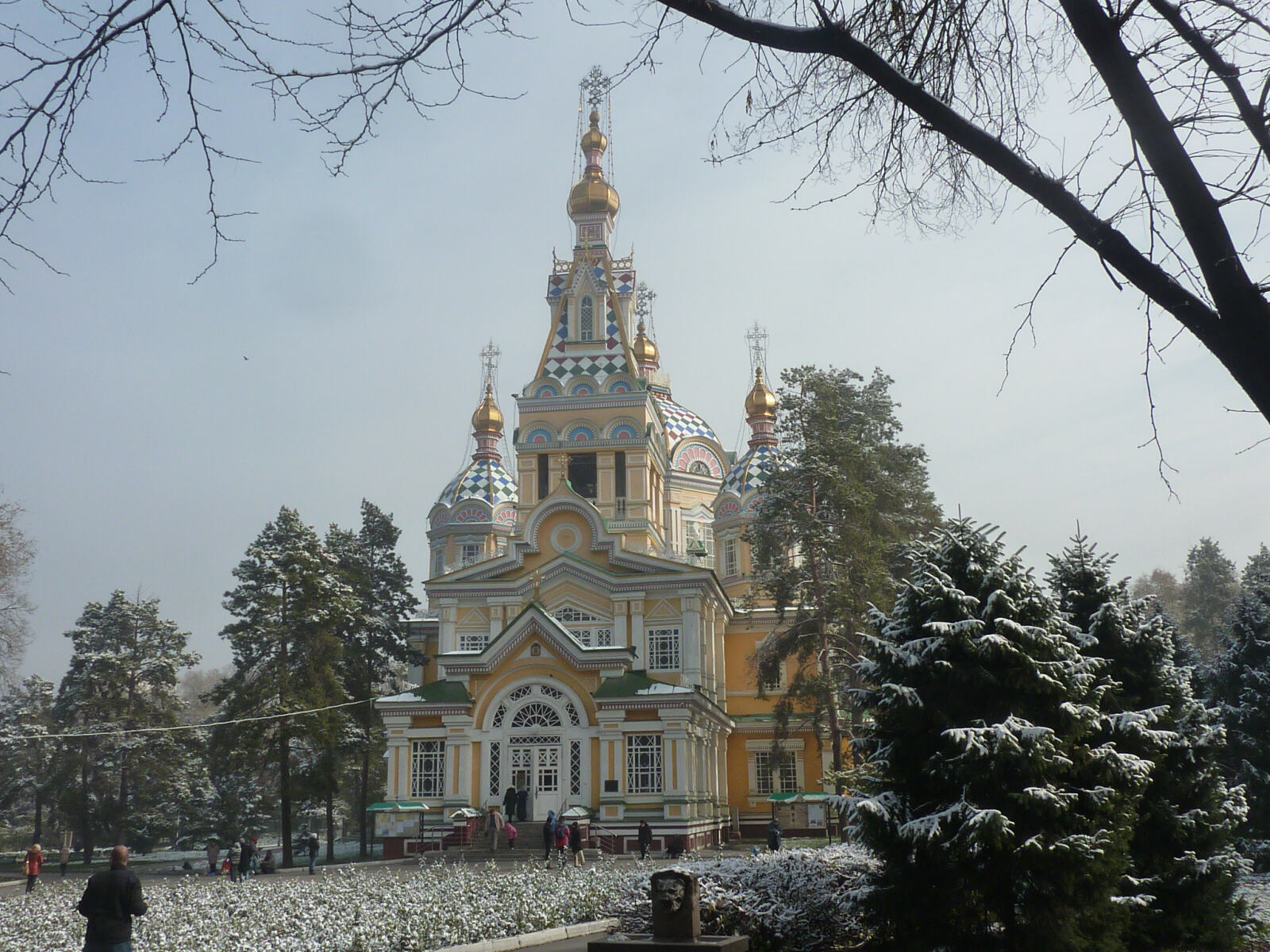
|
It was very colourful inside as well. |

|
We looked at the nearby war memorial with square-jawed Soviet heroes emerging from blocks of rocks. |
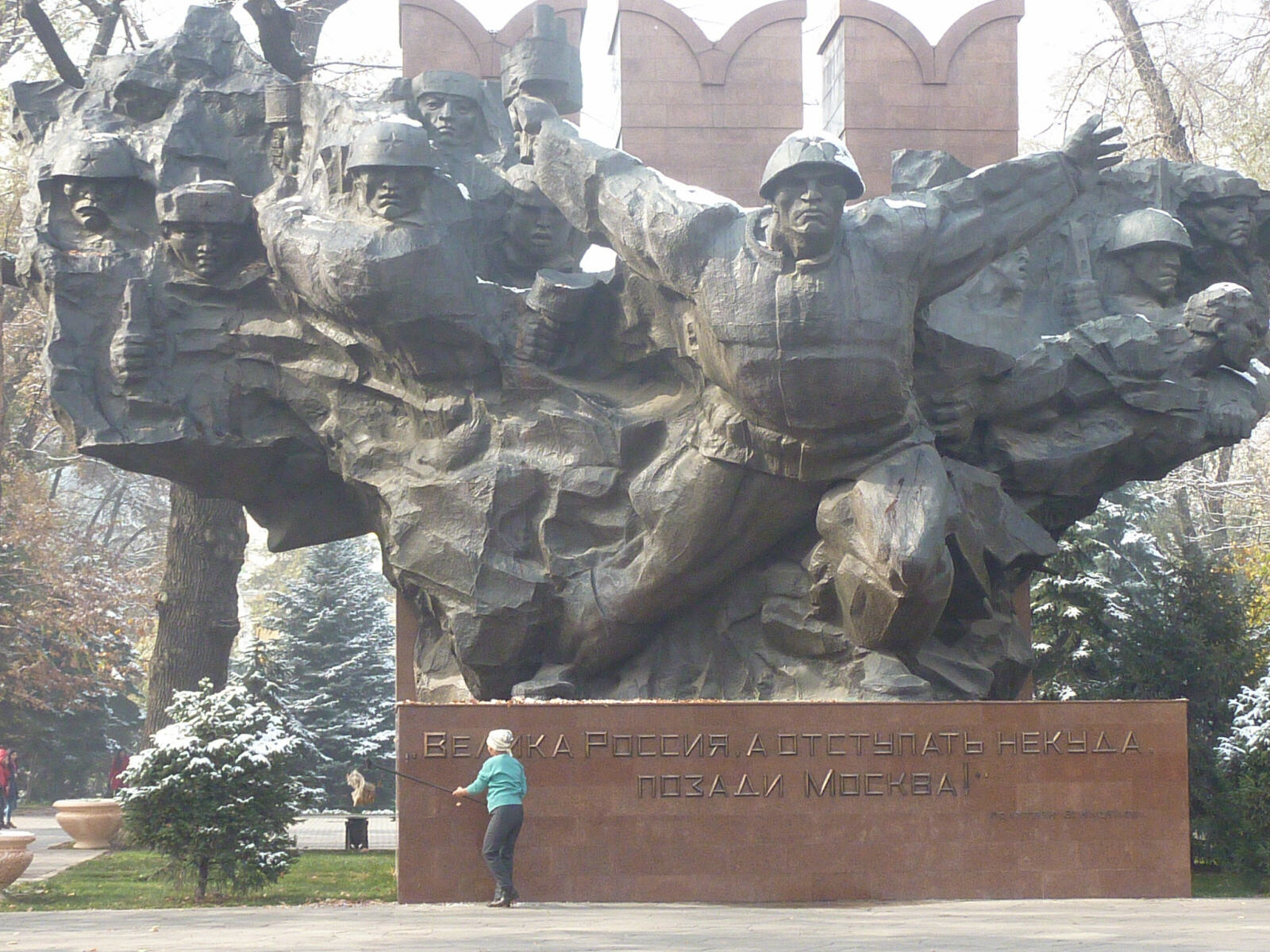
|
We went back to Hotel D’Rami for lunch of lasagna (left over from last night’s meal and warmed up and plated for us by the kindly hotel staff) and Leffe brown beer from the well-stocked nearby supermarket. While Sheila slept off the lunchtime beer I decided to go to the railway station to enquire about trains to Urumchi in China, for a possible continuation of our Silk Road journey some time. I was walking down the street when by chance I found the entrance to a metro station. The metro is new and doesn’t feature in my rather old guide book, but I saw that it went to a place near the railway station, so for 80 tenge (30 pence) I went two stops to the end of the Red line at Raiymbek. It was still a bit of a walk to the station and by the square outside I found the booking office where the friendly ladies, who thought it was hilarious that I didn’t speak Russian, managed to convey (I think) that the train runs twice a week, takes 30 hours and costs about £106 each – I hope that’s for a sleeper. The station itself was really busy and one of the platforms was packed with people apparently expecting a train any time soon. Several trolleybus routes terminate in the station square so I got the no. 5 all the way up Ablay Khan Street back to the hotel, for 30 pence. In the evening we went next door to Schwabischer Domuk (house) for a wonderful meal of German sausages, garlic bread and black ‘dunkel’ beer.
Fri 31st. We’ve pretty much done the sights so today is all about eating and drinking (even more than most days are!) We went down to the pedestrian shopping street and had eggs benedict and fancy coffees for breakfast at Presso Italian coffee bar, then strolled back looking for a cake shop with a nice lemon tart that we saw before but we couldn’t find it, so we ended up back at Schwabish House for lunch of lentil soup and tasty salted herring with onions and potatoes, washed down with glasses of house white and red wine. After a quiet afternoon we went back to Schwabish House for a lovely sizzling beef and vegetables with Paulaner dunkel beer.
Sat 1st Nov. We flew home on Air Ukraine via Kiev. Kiev airport was pretty disorganized but the flights were alright and we arrived home more or less on time. |
If you would like to see more of our travels just click the map.

|